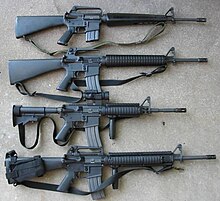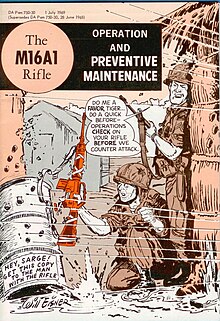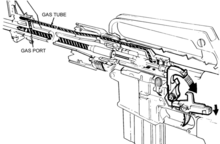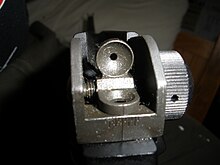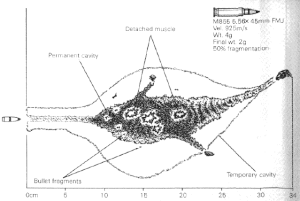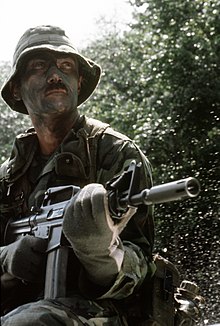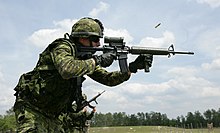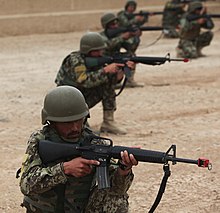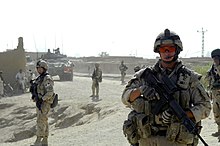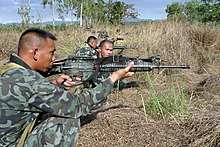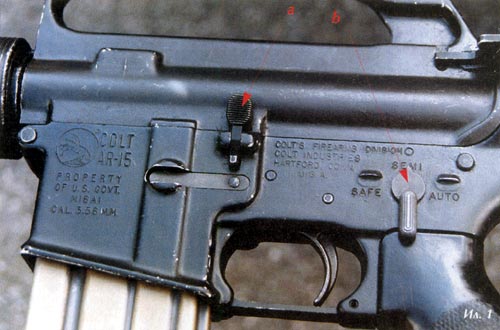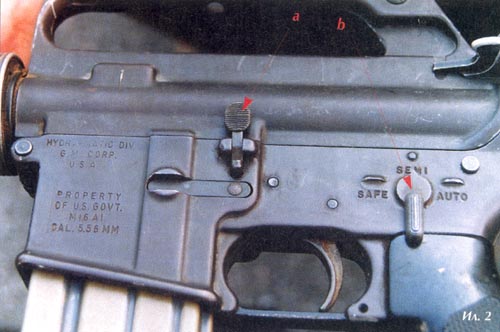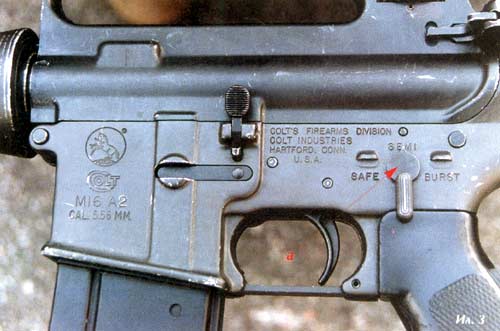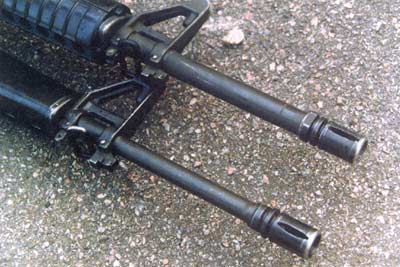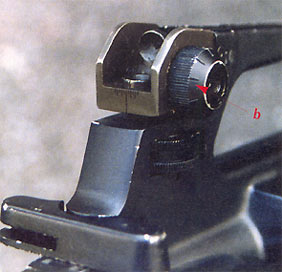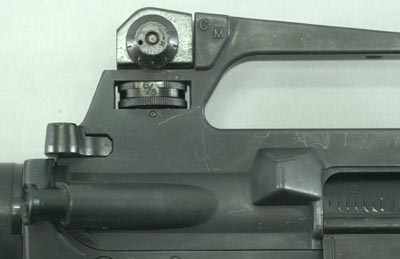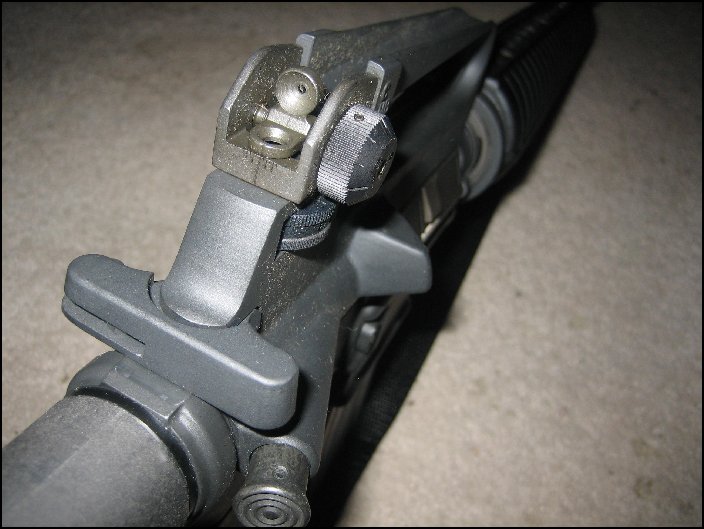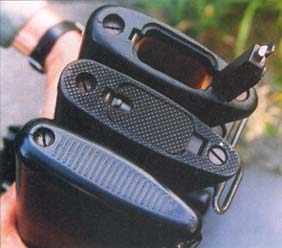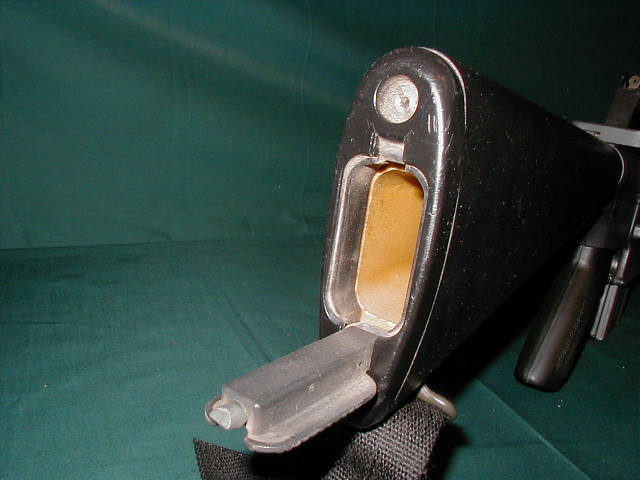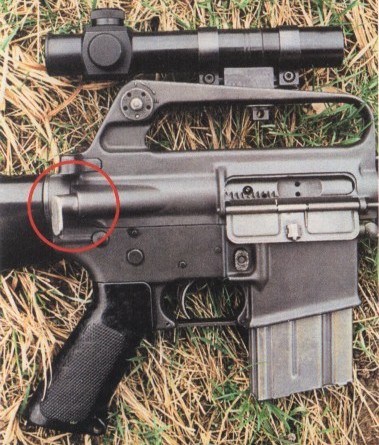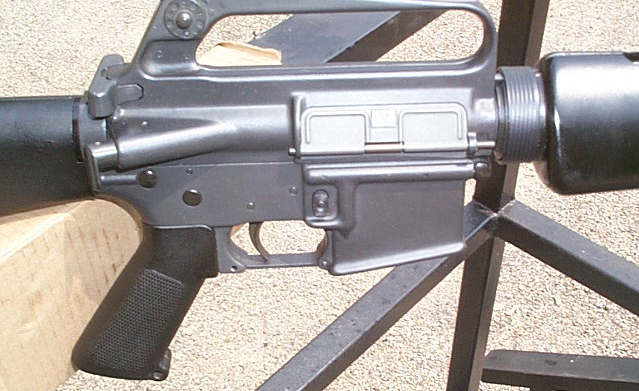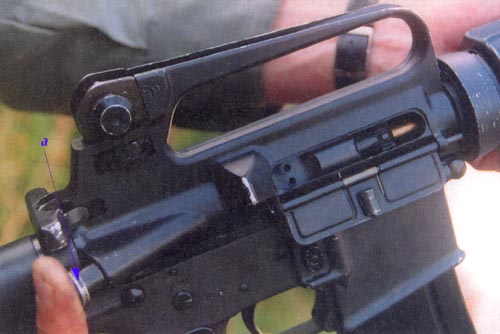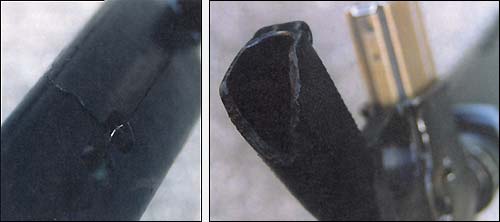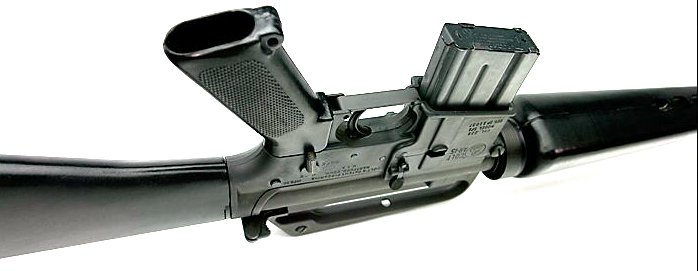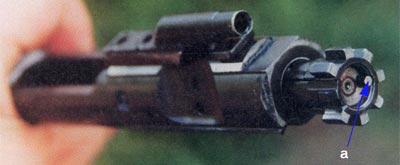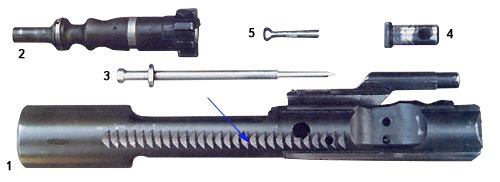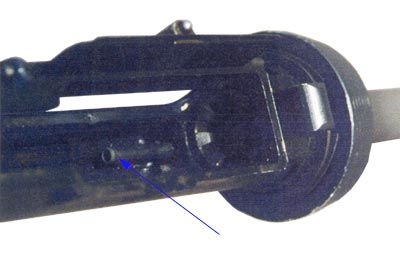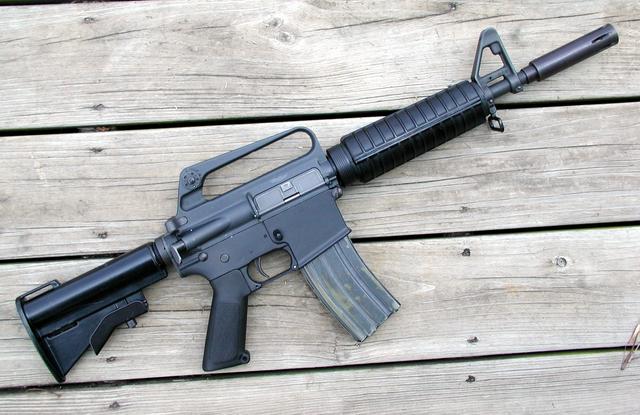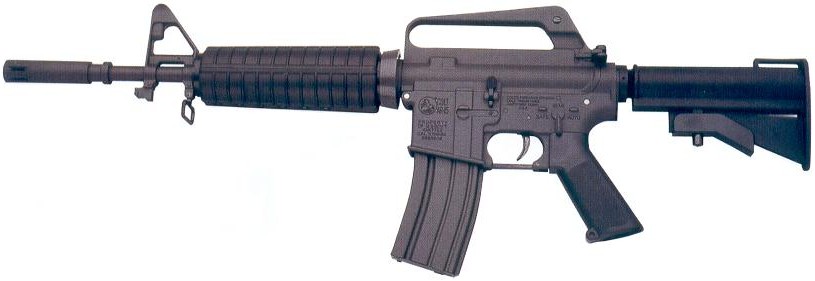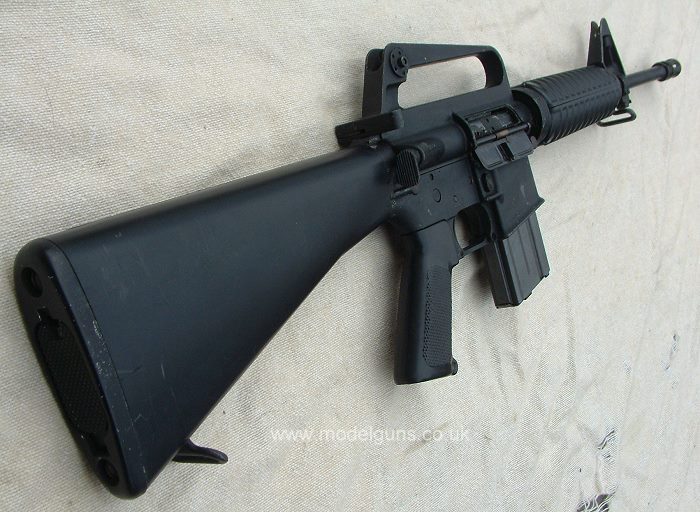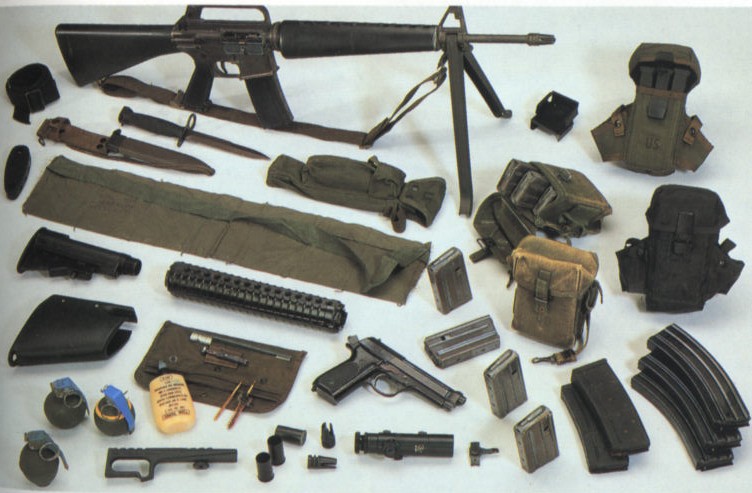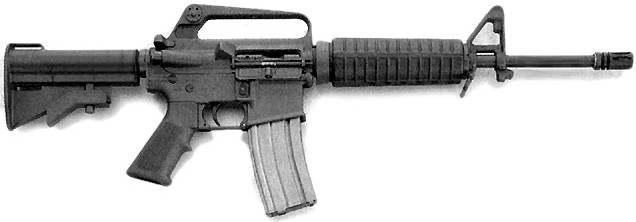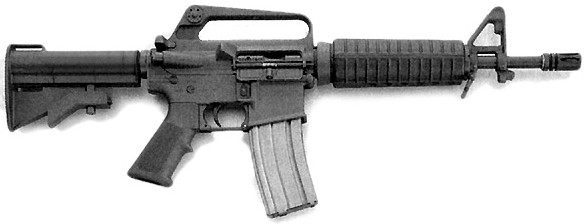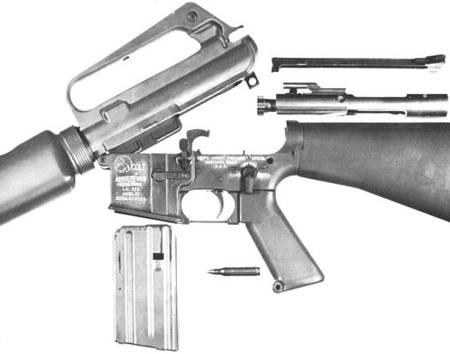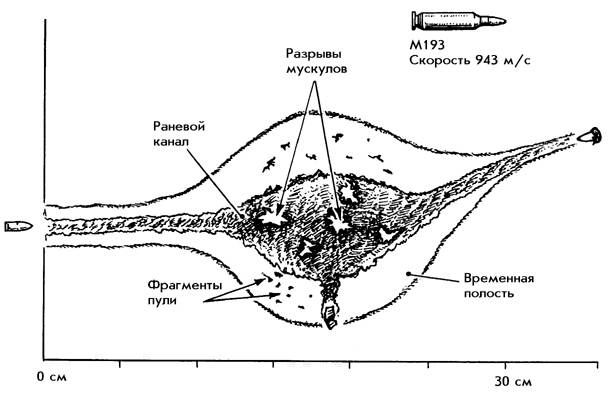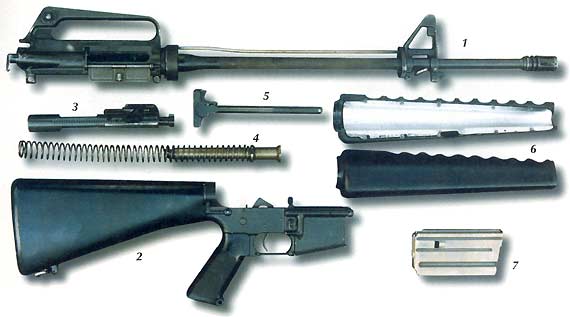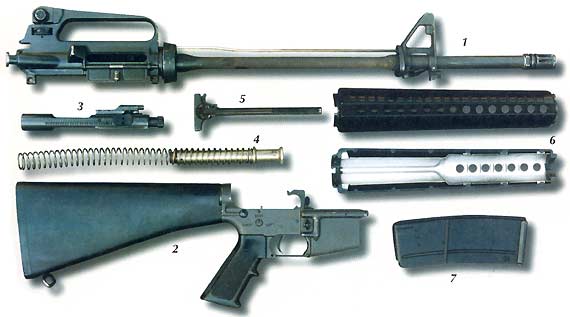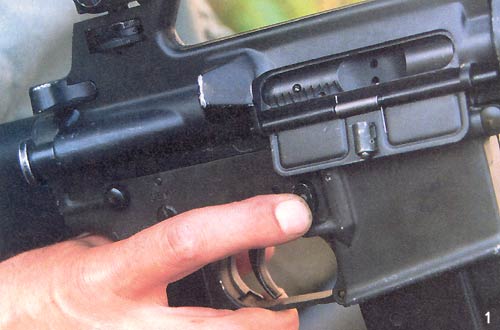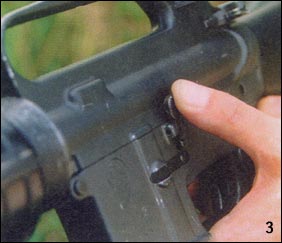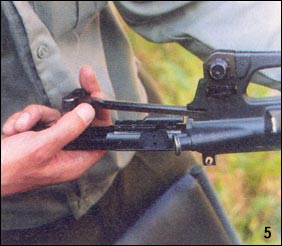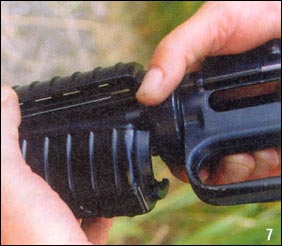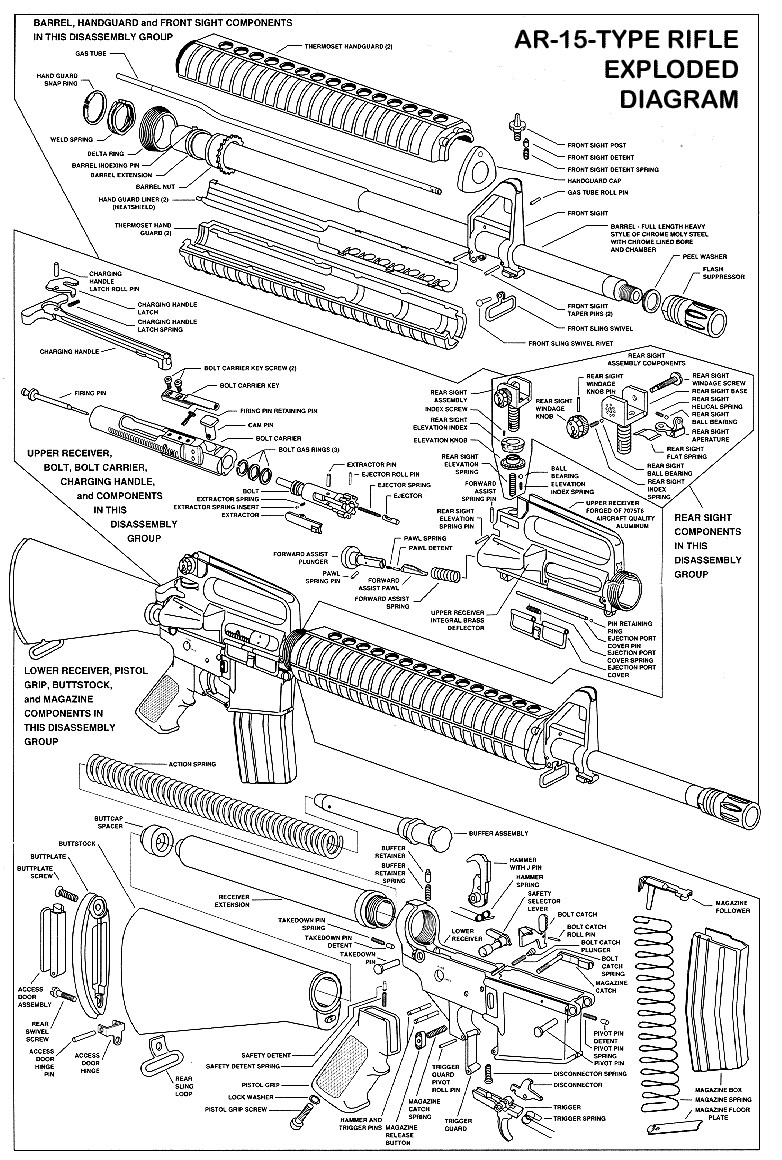Инструкция по обращению со штурмовой винтовкой M16A2
[youtube][/youtube]
[youtube][/youtube]
Заряжание:
* Направьте оружие в безопасную сторону.
* Возьмите снаряжённый магазин и твёрдо вставьте его в оружие до щелчка.
* Дёрните магазин вниз, проверяя, встал ли он на своё место и надёжно ли держится.
* Потяните «Рукоятку Заряжания» назад до упора, затем отпустите. Она вернётся в исходную позицию, взводя ударник и досылая боеприпас в патронник. Теперь оружие заряжено и выстрелит, если нажать на спусковой крючок.
* Если нет намерения вести огонь прямо сейчас, установите переводчик огня в положение «Безопасно», если он был в положении «Одиночные» или «Очередь», и закройте «Шторку окна выброса».
Стрельба:
* Направьте заряженное оружие на цель.
* Пальцем нажмите на переводчик огня, меняя его положение с «Безопасно» на «Одиночные» или «Очередь».
* Нажмите спусковой крючок — оружие выстрелит.
* Если переводчик огня был установлен в положение «Одиночные», оружие выстрелит один раз. Если на «Очередь» — автоматически произведёт три выстрела один за другим.
* В любом случае, при следующем нажатии на спусковой крючок каждый раз оружие будет стрелять, а энергия пороховых газов выбрасывать стреляный боеприпас и досылать в патронник новый.
* Не нужно беспокоиться, открыта или закрыта «Шторка окна выброса». Если она закрыта, а оружие намерено выбросить боеприпас, «Шторка окна выброса» откроется автоматически и будет открыта до тех пор, пока стрелок не сочтёт нужным закрыть её.
Разряжание:
* Направьте оружие в безопасную сторону.
* Правым указательным пальцем отожмите защёлку магазина над спусковой скобой с правой стороны оружия, и извлеките магазин. Обычно магазин выпадает сразу после того, как нажата защёлка магазина.
* ПОСЛЕ извлечения магазина потяните «Рукоятку Заряжания» назад, извлекая патрон из патронника.
* Взгляните через окно выброса, убеждаясь, что в патроннике нет боеприпаса. Затем отпустите «Рукоятку Заряжания», позволяя ей сместиться на её обычное место.
* Установите переводчик огня в положение «Безопасно».
* Закройте «Шторку окна выброса».
Приведение оружия к осмотру:
* Приведение оружия к осмотру означает его разряжание и приведение в безопасное состояние, визуально очевидное для стороннего наблюдателя.
* Для приведения винтовки М16А2 к осмотру извлеките магазин, потяните «Рукоятку Заряжания» назад и заблокируйте в заднем положении, установите переводчик огня в положение «Безопасно» и оставьте «Шторку окна выброса» в открытом положении. В таком состоянии оружие наиболее безопасно.
[youtube][/youtube]
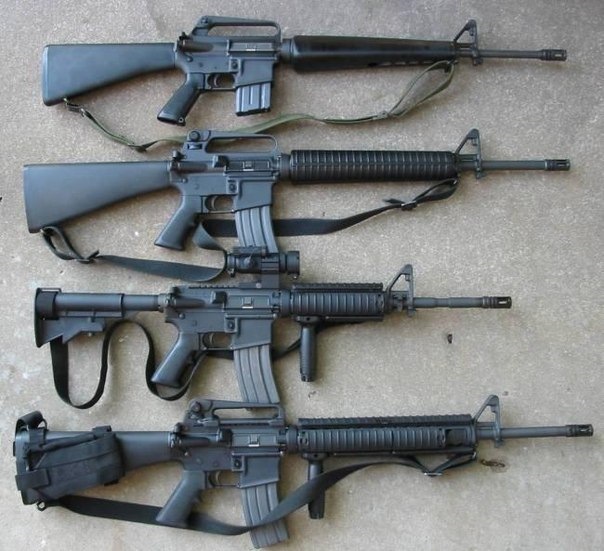
Автоматическая винтовка калибра 5,56×45 мм с воздушным охлаждением ствола, автоматикой на основе газового двигателя (использование энергии пороховых газов) и схемой запирания поворотом затвора. Пороховые газы, отведенные из канала ствола по тонкой газоотводной трубке, воздействуют непосредственно на затворную раму (а не на поршень, как во многих других схемах) толкая её назад. Движущаяся затворная рама поворачивает затвор, тем самым выводя его из зацепления со стволом. Дальше затвор и затворная рама движутся под действием остаточного давления в патроннике, сжимая возвратную пружину, одновременно с этим выбрасывается стреляная гильза. Распрямляющаяся возвратная пружина толкает затворную группу обратно, затвор извлекает из магазина новый патрон и досылает его в патронник, после чего входит в зацепление (запирается) со стволом. На этом цикл работы автоматики завершается и после выстрела все повторяется сначала. В конструкции М16 предусмотрена задержка затвора в крайнем заднем положении для облегчения перезарядки оружия. Это значит, что, когда в магазине закончатся патроны, для перезарядки будет достаточно сменить магазин и нажать на кнопку затворной задержки, расположенную на левой стороне затворной коробки, а не тянуть за Т-образную ручку на заднем торце оружия.
Для изготовления винтовки использованы сталь, алюминий и пластмасса.
M16A2 с подствольным гранатомётом M203
M16 — винтовка классической компоновки. В прикладе размещены приспособления для чистки оружия. С правой стороны ствольной коробки хорошо виден «досылатель» затвора (предназначенный для ручного досылания затвора, если энергии возвратной пружины окажется недостаточно) и крышка над окном выбрасывателя гильз, предохраняющая механизм от попадания грязи и автоматически открывающаяся при взведении затвора. Кроме того, на винтовках, начиная с модификации М16А2, появился отражатель, который позволяет стрелку вести огонь с левого плеча, не боясь попадания гильз в лицо. На винтовку может устанавливаться 40-мм подствольный гранатомет M203 (в каждом отделении американской армии имеется по два автомата с данным гранатомётом)[1]. На современных винтовках имеются направляющие типа Picatinny rail, позволяющие устанавливать широкий ассортимент прицелов и дополнительных приспособлений — лазерных целеуказателей, тактических фонарей, передних рукояток и так далее.
Цена вопроса: 30 000 ₽
- Армия
- Cancel
1. Отделить магазин нажатием на кнопку защелки магазина, расположенную с правой стороны спусковой коробки.
2. Отвести назад планку перезаряжания и осмотреть патронник на предмет отсутствия патрона.
3. Если подвижные части винтовки удерживались затворной задержкой, нажатием на рычаг затворной задержки спустить их в переднее положение.
4. Вытолкнуть чеку в задней части спусковой коробки и откинуть вверх заднюю часть ствольной коробки.
5. Придерживая рукой стебель затвора, сдвинуть его вместе с планкой перезаряжания назад и отделить от ствольной коробки движением вниз.
6. Поджав фиксатор буфера противоотскока, вынуть его вместе с возвратной пружиной из полости приклада.
7. Сдвинув подпружиненную муфту цевья назад, отделить накладки цевья.
Неполная разборка М16А1
1. Ствол со ствольной коробкой; 2. Спусковая коробка с прикладом и рукояткой; 3. Затвор в сборе; 4. Буфер противоотскока с возвратной пружиной; 5. Планка перезаряжания; 6. Накладки цевья (у М16А1 — левая и правая, у М16А2 обе накладки одинаковые); 7. Магазин.
По материалам сайта
http://www.sinopa.ee/kalashnikov/kraznoe/k01m16/m1602.htm
Разбирали когда-нибудь это оружие?
| Rifle, Caliber 5.56 mm, M16 | |
|---|---|

M16A2, multi-sided view |
|
| Type | Assault rifle |
| Place of origin | United States |
| Service history | |
| In service | 1964–present[1] |
| Used by | See Users |
| Wars | See Conflicts |
| Production history | |
| Designer | Eugene Stoner (AR-10)[2] L. James Sullivan (AR-15)[3] |
| Designed | 1959[4] |
| Manufacturer |
|
| Produced |
|
| No. built | c. 8 million as of 2011[1] |
| Variants | See List of Colt AR-15 and M16 rifle variants |
| Specifications (M16) | |
| Mass | unloaded: 6.37 lb (2.89 kg) (M16A1) 8.31 lb (3.77 kg) (M16A2) 7.50 lb (3.40 kg) (M16A4) 8.81 lb (4.00 kg) (loaded with 30 rounds and sling)[5][6] |
| Length | 38.81 in (986 mm) (M16A1) 39.63 in (1,007 mm) (M16A2) 39.37 in (1,000 mm) (M16A4) |
| Barrel length | 20 in (508 mm) |
|
|
|
| Cartridge | 5.56×45 mm NATO (M193) |
| Caliber | 5.56 mm (.223 in) |
| Action | Gas-operated (Expansion of gas within piston inside bolt carrier), closed rotating bolt |
| Rate of fire | 700–800 rounds/min cyclic sustained (M16A1)[7] 700-900 rounds/min cyclic sustained (M16A2, M16A3)[8] 800 rounds/min cyclic sustained (M16A4)[8] |
| Muzzle velocity | 3,150 ft/s (960 m/s) (M855A1 round)[9] |
| Effective firing range | 550 m (601 yd) (point target)[10] 800 m (875 yd) (area target)[11] |
| Maximum firing range | 3,600 m (3,937 yd) |
| Feed system | STANAG magazine 20-round detachable box magazine: 0.211 lb (0.096 kg) (empty) / 0.738 lb (0.335 kg) (full) 30-round detachable box magazine: 0.257 lb (0.117 kg) (empty) / 1.06 lb (0.48 kg) (full) 60-round detachable box magazine Beta C-Mag 100-round drum magazine: 2.20 lb (1.00 kg) (empty) / 4.81 lb (2.18 kg) (full) |
| Sights | Iron sights: Rear: aperture; L-type flip Front: wing-protected post Various aiming optics |
The M16 rifle (officially designated Rifle, Caliber 5.56 mm, M16) is a family of military rifles adapted from the ArmaLite AR-15 rifle for the United States military. The original M16 rifle was a 5.56×45mm automatic rifle with a 20-round magazine.
In 1964, the M16 entered US military service and the following year was deployed for jungle warfare operations during the Vietnam War.[12] In 1969, the M16A1 replaced the M14 rifle to become the US military’s standard service rifle.[13][14] The M16A1 incorporated numerous modifications including a bolt-assist, chrome-plated bore, protective reinforcement around the magazine release, and revised flash hider.[12]
In 1983, the US Marine Corps adopted the M16A2 rifle, and the US Army adopted it in 1986. The M16A2 fires the improved 5.56×45mm (M855/SS109) cartridge and has a newer adjustable rear sight, case deflector, heavy barrel, improved handguard, pistol grip, and buttstock, as well as a semi-auto and three-round burst fire selector.[15][16] Adopted in July 1997, the M16A4 is the fourth generation of the M16 series. It is equipped with a removable carrying handle and Picatinny rail for mounting optics and other ancillary devices.[17]
The M16 has also been widely adopted by other armed forces around the world. Total worldwide production of M16s is approximately 8 million, making it the most-produced firearm of its 5.56 mm caliber.[18][1] The US military has largely replaced the M16 in frontline combat units with a shorter and lighter version, the M4 carbine.[19][20]
In April 2022, the U.S. Army selected the SIG MCX SPEAR as the winner of the Next Generation Squad Weapon Program to replace the M16/M4. The rifle is designated XM7.[21]
History[edit]
Background[edit]
In 1928, a U.S. Army ‘Caliber Board’ conducted firing tests at Aberdeen Proving Ground and recommended transitioning to smaller caliber rounds, mentioning, in particular .27 in (6.86 mm) caliber. Largely in deference to tradition, this recommendation was ignored and the Army referred to the .30 in (7.62 mm) caliber as «full-sized» for the next 35 years.[22] After World War II, the United States military started looking for a single automatic rifle to replace the M1 Garand, M1/M2 Carbines, M1918 Browning Automatic Rifle, M3 «Grease Gun» and Thompson submachine gun.[23][24] However, early experiments with select-fire versions of the M1 Garand proved disappointing.[25] During the Korean War, the select-fire M2 carbine largely replaced the submachine gun in US service[24] and became the most widely used carbine variant.[26] However, combat experience suggested that the .30 Carbine round was underpowered.[27] American weapons designers concluded that an intermediate round was necessary, and recommended a small-caliber, high-velocity cartridge.[28]
However, senior American commanders, having faced fanatical enemies and experienced major logistical problems during World War II and the Korean War,[29][30][31][32][33] insisted that a single, powerful .30 caliber cartridge be developed, that could not only be used by the new automatic rifle but by the new general-purpose machine gun (GPMG) in concurrent development.[34][35] This culminated in the development of the 7.62×51 mm NATO cartridge.[34]
The U.S. Army then began testing several rifles to replace the obsolete M1. Springfield Armory’s T44E4 and heavier T44E5 were essentially updated versions of the M1 chambered for the new 7.62 mm round, while Fabrique Nationale submitted their FN FAL as the T48. ArmaLite entered the competition late, hurriedly submitting several AR-10 prototype rifles in the fall of 1956 to the U.S. Army’s Springfield Armory for testing.[36] The AR-10 featured an innovative straight-line barrel/stock design, forged aluminum alloy receivers, and with phenolic composite stocks.[37] It had rugged elevated sights, an oversized aluminum[38] flash suppressor and recoil compensator, and an adjustable gas system.[39] The final prototype featured an upper and lower receiver with the now-familiar hinge and takedown pins, and the charging handle was on top of the receiver placed inside of the carry handle.[36] For a 7.62 mm NATO rifle, the AR-10 was incredibly lightweight at only 6.85 lb (3.11 kg) empty.[36] Initial comments by Springfield Armory test staff were favorable, and some testers commented that the AR-10 was the best lightweight automatic rifle ever tested by the Armory.[40][41] In the end, the U.S. Army chose the T44, now named the M14 rifle,[34] which was an improved M1 Garand with a 20-round magazine and automatic fire capability.[42][43] The U.S. also adopted the M60 general-purpose machine gun (GPMG).[34] Its NATO partners adopted the FN FAL and HK G3 rifles, as well as the FN MAG and Rheinmetall MG3 GPMGs.
The first confrontations between the AK-47 and the M14 came in the early part of the Vietnam War. Battlefield reports indicated that the M14 was uncontrollable in full-auto and that soldiers could not carry enough ammunition to maintain fire superiority over the AK-47.[42][44] And, while the M2 carbine offered a high rate of fire, it was under-powered and ultimately outclassed by the AK-47.[45] A replacement was needed: a medium between the traditional preference for high-powered rifles such as the M14, and the lightweight firepower of the M2 Carbine.[citation needed]
As a result, the Army was forced to reconsider a 1957 request by General Willard G. Wyman, commander of the U.S. Continental Army Command (CONARC) to develop a .223-inch caliber (5.56 mm) select-fire rifle weighing 6 lb (2.7 kg) when loaded with a 20-round magazine.[23] The 5.56 mm round had to penetrate a standard U.S. helmet at 500 yards (460 meters) and retain a velocity over the speed of sound while matching or exceeding the wounding ability of the .30 Carbine cartridge.[46]
This request ultimately resulted in the development of a scaled-down version of the Armalite AR-10, named the ArmaLite AR-15.[47][48][13] The AR-15 was first revealed by Eugene Stoner at Fort Benning in May 1957.[49] The AR-15 used .22-caliber bullets, which destabilized when they hit a human body, as opposed to the .30 round, which typically passed through in a straight line. The smaller caliber meant that it could be controlled in autofire due to the reduced bolt thrust and free recoil impulse. Being almost one-third the weight of the .30 meant that the soldier could sustain fire for longer with the same load. Due to design innovations, the AR-15 could fire 600 to 700 rounds a minute with an extremely low jamming rate. Parts were stamped out, not hand-machined, so they could be mass-produced, and the stock was plastic to reduce weight.[22]
In 1958, the Army’s Combat Developments Experimentation Command ran experiments with small squads in combat situations using the M14, AR-15, and another rifle designed by Winchester. The resulting study recommended adopting a lightweight rifle like the AR-15. In response, the Army declared that all rifles and machine guns should use the same ammunition, and ordered full production of the M14.[22] However, advocates for the AR-15 gained the attention of Air Force Chief of Staff General Curtis LeMay. After testing the AR-15 with the ammunition manufactured by Remington that Armalite and Colt recommended, the Air Force declared that the AR-15 was its ‘standard model’ and ordered 8,500 rifles and 8.5 million rounds.[22] Advocates for the AR-15 in the Defense Advanced Research Projects Agency acquired 1,000 Air Force AR-15s and shipped them to be tested by the Army of the Republic of Vietnam (ARVN). The South Vietnam soldiers issued glowing reports of the weapon’s reliability, recording zero broken parts while firing 80,000 rounds in one stage of testing, and requiring only two replacement parts for the 1,000 weapons over the entire course of testing. The report of the experiment recommended that the U.S. provide the AR-15 as the standard rifle of the ARVN, but Admiral Harry Felt, then Commander in Chief of Pacific Forces, rejected the recommendations on the advice of the U.S. Army.[22]
Throughout 1962 and 1963, the U.S. military extensively tested the AR-15. Positive evaluations emphasized its lightness, «lethality», and reliability.[22] However, the Army Materiel Command criticized its inaccuracy at longer ranges and lack of penetrating power at higher ranges.[47][42][22] In early 1963, the U.S. Special Forces asked and was given permission, to make the AR-15 its standard weapon. Other users included Army Airborne units in Vietnam and some units affiliated with the Central Intelligence Agency. As more units adopted the AR-15, Secretary of the Army Cyrus Vance ordered an investigation into why the weapon had been rejected by the Army. The resulting report found that Army Materiel Command had rigged the previous tests, selecting tests that would favor the M14 and choosing match grade M14s to compete against AR-15s out of the box.[22] At this point, the bureaucratic battle lines were well-defined, with the Army ordnance agencies opposed to the AR-15 and the Air Force and civilian leadership of the Defense Department in favor.[22]
In January 1963, Secretary of Defense Robert McNamara concluded that the AR-15 was the superior weapon system and ordered a halt to M14 production.[47][42] In late 1963, the Defense Department began mass procurement of rifles for the Air Force and special Army units. Secretary McNamara designated the Army as the procurer for the weapon with the Department, which allowed the Army ordnance establishment to modify the weapon as they wished. The first modification was the addition of a «manual bolt closure,» allowing a soldier to ram in a round if it failed to seat properly. The Air Force, which was buying the rifle, and the Marine Corps, which had tested it both objected to this addition, with the Air Force noting, «During three years of testing and operation of the AR-15 rifle under all types of conditions the Air Force has no record of malfunctions that could have been corrected by a manual bolt closing device.» They also noted that the closure added weight and complexity, reducing the reliability of the weapon. Colonel Harold Yount, who managed the Army procurement, would later state the bolt closure was added after direction from senior leadership, rather than as a result of any complaint or test result, and testified about the reasons: «the M-1, the M-14, and the carbine had always had something for the soldier to push on; that maybe this would be a comforting feeling to him or something.»[22][50]
After modifications,[48] the new redesigned rifle was subsequently adopted as the M16 Rifle.[12][47][42]
(The M16) was much lighter compared to the M14 it replaced, ultimately allowing soldiers to carry more ammunition. The air-cooled, gas-operated, magazine-fed assault rifle was made of steel, aluminum alloy, and composite plastics, truly cutting-edge for the time. Designed with full and semi-automatic capabilities, the weapon initially did not respond well to wet and dirty conditions, sometimes even jamming in combat. After a few minor modifications, the weapon gained in popularity among troops on the battlefield.[42][51][52]
Despite its early failures the M16 proved to be a revolutionary design and stands as the longest continuously serving rifle in US military history.[12][47] It has been adopted by many US allies and the 5.56×45 mm NATO cartridge has become not only the NATO standard but «the standard assault-rifle cartridge in much of the world.»[47][53][54] It also led to the development of small-caliber high-velocity service rifles by every major army in the world.[47] It is a benchmark against which other assault rifles are judged.[47][55][56]
Adoption[edit]
In July 1960, General Curtis LeMay was impressed by a demonstration of the ArmaLite AR-15. In the summer of 1961, General LeMay was promoted to U.S. Air Force chief of staff and requested 80,000 AR-15s. However, General Maxwell D. Taylor, chairman of the Joint Chiefs of Staff, advised President John F. Kennedy that having two different calibers within the military system at the same time would be problematic and the request was rejected.[57] In October 1961, William Godel, a senior man at the Advanced Research Projects Agency, sent 10 AR-15s to South Vietnam. The reception was enthusiastic, and in 1962 another 1,000 AR-15s were sent.[58] United States Army Special Forces personnel filed battlefield reports lavishly praising the AR-15 and the stopping power of the 5.56 mm cartridge, and pressed for its adoption.[42]
The damage caused by the 5.56 mm bullet was originally believed to be caused by «tumbling» due to the slow 1 turn in 14-inch (360 mm) rifling twist rate.[42][57] However, any pointed lead core bullet will «tumble» after penetration into flesh, because the center of gravity is towards the rear of the bullet. The large wounds observed by soldiers in Vietnam were caused by bullet fragmentation created by a combination of the bullet’s velocity and construction.[59] These wounds were so devastating, that the photographs remained classified into the 1980s.[60]
However, despite overwhelming evidence that the AR-15 could bring more firepower to bear than the M14, the Army opposed the adoption of the new rifle.[47][42] U.S. Secretary of Defense Robert McNamara now had two conflicting views: the ARPA report[61] favoring the AR-15 and the Army’s position favoring the M14.[42] Even President Kennedy expressed concern, so McNamara ordered Secretary of the Army, Cyrus Vance, to test the M14, the AR-15, and the AK-47. The Army reported that only the M14 was suitable for service, but Vance wondered about the impartiality of those conducting the tests. He ordered the Army inspector General to investigate the testing methods used; the inspector general confirmed that the testers were biased toward the M14.
In January 1963, Secretary McNamara received reports that M14 production was insufficient to meet the needs of the armed forces and ordered a halt to M14 production.[42] At the time, the AR-15 was the only rifle that could fulfill a requirement of a «universal» infantry weapon for issue to all services. McNamara ordered its adoption, despite receiving reports of several deficiencies, most notably the lack of a chrome-plated chamber.[62][12]
After modifications (most notably, the charging handle was re-located from under the carrying handle like the AR-10, to the rear of the receiver),[48] the newly redesigned rifle was renamed the Rifle, Caliber 5.56 mm, M16.[12][47] Inexplicably, the modification to the new M16 did not include a chrome-plated barrel. Meanwhile, the Army relented and recommended the adoption of the M16 for jungle warfare operations. However, the Army insisted on the inclusion of a forward assist to help push the bolt into battery if a cartridge failed to seat into the chamber. The Air Force, Colt, and Eugene Stoner believed that the addition of a forward assist was an unjustified expense. As a result, the design was split into two variants: the Air Force’s M16 without the forward assist, and the XM16E1 with the forward assist for the other service branches.
In November 1963, McNamara approved the U.S. Army’s order of 85,000 XM16E1s;[42][63] and to appease General LeMay, the Air Force was granted an order for another 19,000 M16s.[13][64] In March 1964, the M16 rifle went into production and the Army accepted delivery of the first batch of 2,129 rifles later that year, and an additional 57,240 rifles the following year.[12]
In 1964, the Army was informed that DuPont could not mass-produce the IMR 4475 stick powder to the specifications demanded by the M16. Therefore, Olin Mathieson Company provided a high-performance ball propellant. While the Olin WC 846 powder achieved the desired 3,300 ft (1,000 m) per second muzzle velocity, it produced much more fouling, that quickly jammed the M16’s action (unless the rifle was cleaned well and often).[65]
In March 1965, the Army began to issue the XM16E1 to infantry units. However, the rifle was initially delivered without adequate cleaning kits[42] or instructions because advertising from Colt asserted that the M16’s materials made the weapon require little maintenance, and was capable of self-cleaning.[66] Furthermore, cleaning was often conducted with improper equipment, such as insect repellent, water, and aircraft fuel, which induced further wear on the weapon.[67] As a result, reports of stoppages in combat began to surface.[42] The most severe problem was known as «failure to extract»—the spent cartridge case remained lodged in the chamber after the rifle was fired.[42][68] Documented accounts of dead U.S. troops found next to disassembled rifles eventually led to a Congressional investigation.[42][69]
We left with 72 men in our platoon and came back with 19, Believe it or not, you know what killed most of us? Our own rifle. Practically every one of our dead was found with his (M16) torn down next to him where he had been trying to fix it.
— Marine Corps Rifleman, Vietnam.[69][70]
In February 1967, the improved XM16E1 was standardized as the M16A1.[13] The new rifle had a chrome-plated chamber and bore to eliminate corrosion and stuck cartridges, and other minor modifications.[42] New cleaning kits, powder solvents, and lubricants were also issued. Intensive training programs in weapons cleaning were instituted including a comic book-style operations manual.[71][72] As a result, reliability problems were largely resolved and the M16A1 rifle achieved widespread acceptance by U.S. troops in Vietnam.[42][52]
In 1969, the M16A1 officially replaced the M14 rifle to become the U.S. military’s standard service rifle.[73][14] In 1970, the new WC 844 powder was introduced to reduce fouling.[74]
Colt, H&R, and GM Hydramatic Division manufactured M16A1 rifles during the Vietnam War.[citation needed] M16s were produced by Colt until the late 1980s when FN Herstal (FN USA) began to manufacture them.[75]
Reliability[edit]
During the early part of its service, the M16 had a reputation for poor reliability and a malfunction rate of two per 1000 rounds fired.[76] The M16’s action works by passing high-pressure propellant gasses, tapped from the barrel, down a tube and into the carrier group within the upper receiver. The gas goes from the gas tube, through the bolt carrier key, and into the inside of the carrier where it expands in a donut-shaped gas-piston cylinder. Because the bolt is prevented from moving forward by the barrel, the carrier is driven to the rear by the expanding gases and thus converts the energy of the gas to the movement of the rifle’s parts. The back part of the bolt forms a piston head and the cavity in the bolt carrier is the piston sleeve. While the M16 is commonly said to use a direct impingement system, this is wrong, and it is instead correct to say it uses an internal piston system.[77]
This design is much lighter and more compact than a gas-piston design. However, this design requires that combustion byproducts from the discharged cartridge be blown into the receiver as well. This accumulating carbon and vaporized metal build-up within the receiver and bolt carrier negatively affects reliability and necessitates more intensive maintenance on the part of the individual soldier. The channeling of gasses into the bolt carrier during operation increases the amount of heat that is deposited in the receiver while firing the M16 and causes the essential lubricant to be «burned off». This requires frequent and generous applications of appropriate lubricant.[23] Lack of proper lubrication is the most common source of weapon stoppages or jams.[23]
The original M16 fared poorly in the jungles of Vietnam and was infamous for reliability problems in harsh environments. Max Hastings was very critical of the M16’s general field issue in Vietnam just as grievous design flaws were becoming apparent. He further states that the Shooting Times experienced repeated malfunctions with a test M16 and assumed these would be corrected before military use, but they were not. Many Marines and soldiers were so angry with the reliability problems they began writing home and on 26 March 1967, the Washington Daily News broke the story.[78] Eventually, the M16 became the target of a Congressional investigation.[79]
The investigation found that:[12]
- The M16 was issued to troops without cleaning kits or instructions on how to clean the rifle.
- The M16 and 5.56×45 mm cartridge was tested and approved with the use of a DuPont IMR8208M extruded powder, which was switched to Olin Mathieson WC846 ball powder which produced much more fouling, which quickly jammed the action of the M16 (unless the gun was cleaned well and often).
- The M16 lacked a forward assist (rendering the rifle inoperable when it failed to go fully forward).
- The M16 lacked a chrome-plated chamber, which allowed corrosion problems and contributed to case extraction failures (which was considered the most severe problem and required extreme measures to clear, such as inserting the cleaning rod down the barrel and knocking the spent cartridge out).
When these issues were addressed and corrected by the M16A1, the reliability problems decreased greatly.[13] According to a 1968 Department of Army report, the M16A1 rifle achieved widespread acceptance by U.S. troops in Vietnam.[52] «Most men armed with the M16 in Vietnam rated this rifle’s performance high, however, many men entertained some misgivings about the M16’s reliability. When asked what weapon they preferred to carry in combat, 85 percent indicated that they wanted either the M16 or its [smaller] carbine-length version, the XM177E2.» Also, «the M14 was preferred by 15 percent, while less than one percent wished to carry either the Stoner rifle, the AK-47, the [M1] carbine or a pistol.»[52] In March 1970, the «President’s Blue Ribbon Defense Panel» concluded that the issuance of the M16 saved the lives of 20,000 U.S. servicemen during the Vietnam War, who would have otherwise died had the M14 remained in service.[80] However, the M16 rifle’s reputation has suffered as of 2011.[why?][13][81]
Another underlying cause of the M16’s jamming problem was identified by ordnance staff that discovered that Stoner and ammunition manufacturers had initially tested the AR 15 using DuPont IMR8208M extruded (stick) powder. Later ammunition manufacturers adopted the more readily available Olin Mathieson WC846 ball powder. The ball powder produced a longer peak chamber pressure with undesired timing effects. Upon firing, the cartridge case expands and seals the chamber (obturation). When the peak pressure starts to drop the cartridge case contracts and then can be extracted. With ball powder, the cartridge case was not contracted enough during extraction due to the longer peak pressure period. The ejector would then fail to extract the cartridge case, tearing through the case rim, and leaving an obturated case behind.[82]
After the introduction of the M4 carbine, it was found that the shorter barrel length of 14.5 inches also harms the reliability, as the gas port is located closer to the chamber than the gas port of the standard length M16 rifle: 7.5 inches instead of 13 inches.[83] This affects the M4’s timing and increases the amount of stress and heat on the critical components, thereby reducing reliability.[83] In a 2002 assessment, the USMC found that the M4 malfunctioned three times more often than the M16A4 (the M4 failed 186 times for 69,000 rounds fired, while the M16A4 failed 61 times).[84] Thereafter, the Army and Colt worked to make modifications to the M4s and M16A4s to address the problems found.[84] In tests conducted in 2005 and 2006 the Army found that on average, the new M4s and M16s fired approximately 5,000 rounds between stoppages.[84][85]
In December 2006, the Center for Naval Analyses (CNA) released a report on U.S. small arms in combat. The CNA conducted surveys on 2,608 troops returning from combat in Iraq and Afghanistan over the past 12 months. Only troops who had fired their weapons at enemy targets were allowed to participate. 1,188 troops were armed with M16A2 or A4 rifles, making up 46 percent of the survey. 75 percent of M16 users (891 troops) reported they were satisfied with the weapon. 60 percent (713 troops) were satisfied with handling qualities such as handguards, size, and weight. Of the 40 percent dissatisfied, most were with its size. Only 19 percent of M16 users (226 troops) reported a stoppage, while 80 percent of those that experienced a stoppage said it had little impact on their ability to clear the stoppage and re-engage their target. Half of the M16 users experienced failures in their magazines to feed. 83 percent (986 troops) did not need their rifles repaired while in the theater. 71 percent (843 troops) were confident in the M16’s reliability, defined as a level of soldier confidence their weapon will fire without malfunction, and 72 percent (855 troops) were confident in its durability, defined as a level of soldier confidence their weapon will not break or need repair. Both factors were attributed to high levels of soldiers performing their maintenance. 60 percent of M16 users offered recommendations for improvements. Requests included greater bullet lethality, new-built instead of rebuilt rifles, better quality magazines, decreased weight, and a collapsible stock. Some users recommended shorter and lighter weapons such as the M4 carbine.[86] Some issues have been addressed with the issuing of the Improved STANAG magazine in March 2009,[87][88] and the M855A1 Enhanced Performance Round in June 2010.[89]
In early 2010, two journalists from The New York Times spent three months with soldiers and Marines in Afghanistan. While there, they questioned around 100 infantry troops about the reliability of their M16 rifles, as well as the M4 carbine. The troops did not report reliability problems with their rifles. While only 100 troops were asked, they engaged in daily fighting in Marja, including at least a dozen intense engagements in Helmand Province, where the ground is covered in fine powdered sand (called «moon dust» by troops) that can stick to firearms.[90] Weapons were often dusty, wet, and covered in mud. Intense firefights lasted hours with several magazines being expended. Only one soldier reported a jam when his M16 was covered in mud after climbing out of a canal. The weapon was cleared and resumed firing with the next chambered round. Furthermore, the Marine Chief Warrant Officer responsible for weapons training and performance of the Third Battalion, Sixth Marines, reported that «We’ve had nil in the way of problems; we’ve had no issues», with his battalion’s 350 M16s and 700 M4s.[90]
Design[edit]
The M16 is a lightweight, 5.56 mm, air-cooled, gas-operated, magazine-fed assault rifle, with a rotating bolt. The M16’s receivers are made of 7075 aluminum alloy, its barrel, bolt, and bolt carrier of steel, and its handguards, pistol grip, and buttstock of plastics.
The M16 internal piston action was derived from the original ArmaLite AR-10 and ArmaLite AR-15 actions. This internal piston action system designed by Eugene Stoner is commonly called a direct impingement system, but it does not use a conventional direct impingement system. In U.S. Patent 2,951,424, the designer states: ″This invention is a true expanding gas system instead of the conventional impinging gas system.″[91]
The gas system, bolt carrier, and bolt-locking design were novel for the time.
The M16A1 was especially lightweight at 7.9 pounds (3.6 kg) with a loaded 30-round magazine.[92] This was significantly less than the M14 that it replaced at 10.7 pounds (4.9 kg) with a loaded 20-round magazine.[93] It is also lighter when compared to the AKM’s 8.3 pounds (3.8 kg) with a loaded 30-round magazine.[94]
The M16A2 weighs 8.8 lb (4.0 kg) loaded with a 30-round magazine, because of the adoption of a thicker barrel profile. The thicker barrel is more resistant to damage when handled roughly and is also slower to overheat during sustained fire. Unlike a traditional «bull» barrel that is thick its entire length, the M16A2’s barrel is only thick forward of the handguards. The barrel profile under the handguards remained the same as the M16A1 for compatibility with the M203 grenade launcher.
Barrel[edit]
Early model M16 barrels had a rifling twist of four grooves, right-hand twist, one turn in 14 inches (1:355.6 mm or 64 calibers) bore—as it was the same rifling as used by the .222 Remington sporting cartridge. After finding out that under unfavorable conditions, military bullets could yaw in flight at long ranges, the rifling was soon altered. Later M16 models and the M16A1 had an improved rifling with six grooves, right-hand twist, one turn in 12 inches (1:304.8 mm or 54.8 calibers) for increased accuracy and was optimized to adequately stabilize the M193 ball and M196 tracer bullets. M16A2 and current models are optimized for firing the heavier NATO SS109 ball and long L110 tracer bullets and have six grooves, right-hand twist, one turn in 7 in (1:177.8 mm or 32 calibers).[95][96][18][97][98]
Using M193 ball and M196 tracer bullets with a one turn in 7 in (1:177.8 mm or 32 calibers) twist degrades accuracy and should only be used in emergency situations. NATO SS109 ball and L110 tracer bullets should only be used in emergency situations at ranges under 90 m (98 yd) with a one turn in 12 inches (1:304.8 mm or 54.8 calibers) twist, as this twist is insufficient to stabilize these projectiles.[98]
Weapons designed to adequately stabilize both the M193 or SS109 projectiles (like civilian market clones) usually have a six-groove, right-hand twist, one turn in 9 inches (1:228.6 mm or 41.1 calibers) or one turn in 8 inches (1:203.2 mm or 36.5 calibers) bore, although other and 1:7 inches twist rates are available as well.
Recoil[edit]
The (M16’s) Stoner system provides a very symmetric design that allows straight-line movement of the operating components. This allows recoil forces to drive straight to the rear. Instead of connecting or other mechanical parts driving the system, high-pressure gas performs this function, reducing the weight of moving parts and the rifle as a whole.[77]
The M16 uses a «straight-line» recoil design, where the recoil spring is located in the stock directly behind the action,[73] and serves the dual function of operating spring and recoil buffer.[73] The stock being in line with the bore also reduces muzzle rise, especially during automatic fire. Because recoil does not significantly shift the point of aim, faster follow-up shots are possible and user fatigue is reduced. In addition, current model M16 flash-suppressors also act as compensators to reduce recoil further.[99]
| Free recoil[100] | |
|---|---|
| M16 | |
| Momentum | 40.4 lb-ft/s |
| Velocity | 5.1 ft/s (1.6 m/s) |
| Energy | 3.2 ft⋅lb (4.3 J) |
Notes: Free recoil is calculated by using the rifle weight, bullet weight, muzzle velocity, and charge weight.[100] It is that which would be measured if the rifle were fired suspended from strings, free to recoil.[100] A rifle’s perceived recoil is also dependent on many other factors which are not readily quantified.[100]
Sights[edit]
The M16’s most distinctive ergonomic feature is the carrying handle and rear sight assembly on top of the receiver. This is a by-product of the original AR-10 design, where the carrying handle contained a rear sight that could be set for specific range settings and also served to protect the charging handle.[73]
The M16 carry handle also provided mounting groove interfaces and a hole at the bottom of the handle groove for mounting a Colt 3×20 telescopic sight featuring a Bullet Drop Compensation elevation adjustment knob for ranges from 100 to 500 yd (91 to 457 m). This concurs with the pre-M16A2 maximum effective range of 460 m (503 yd).[96] The Colt 3×20 telescopic sight was factory adjusted to be parallax-free at 200 yd (183 m).[101][102] In Delft, the Netherlands Artillerie-Inrichtingen produced a roughly similar 3×25 telescopic sight for the carrying handle mounting interfaces.[103]
The M16 elevated iron sight line has a 19.75 in (502 mm) sight radius.[18] As the M16 series rear sight, front sight and sighting in targets designs were modified over time and non-iron sight (optical) aiming devices and new service ammunition were introduced zeroing procedures changed.[104]
The standard pre-M16A2 «Daylight Sight System» uses an AR-15-style L-type flip, two aperture rear sight featuring two combat settings: short-range 0 to 300 m (0 to 328 yd) and long-range 300 to 400 m (328 to 437 yd), marked ‘L’.[105]
The pre-M16A2 «Daylight Sight System» short-range and long-range zeros are 250 and 375 m (273 and 410 yd) with M193 ammunition.[106] The rear sight features a windage drum that can be adjusted during zeroing with about 1 MOA increments. The front sight is a tapered round post of approximately 0.0625 in (1.59 mm) diameter adjustable during zeroing in about 1 MOA increments. A cartridge or tool is required to (re)zero the sight line.[107][104][108]
An alternative pre-M16A2 «Low Light Level Sight System», includes a front sight post with a weak light source provided by tritium radioluminescence in an embedded small glass vial and a two aperture rear sight consisting of a 2 mm (0.079 in) diameter aperture marked ‘L’ intended for normal use out to 460 m (503 yd) and a 7 mm (0.276 in) diameter large aperture for night firing.[109] Regulation stipulates the radioluminescant front sight post must be replaced if more than 144 months (12 years) elapsed after manufacture.[110] The «Low Light Level Sight System» elevation and windage adjustment increments are somewhat coarser compared to the «Daylight Sight System».[108]
With the advent of the M16A2, a less simple fully adjustable rear sight was added, allowing the rear sight to be dialed in with an elevation wheel for specific range settings between 300 and 800 m (328 and 875 yd) in 100 m increments and to allow windage adjustments with a windage knob without the need of a cartridge or tool. The unmarked approximately 0.070 in (1.78 mm) diameter aperture rear sight is for normal firing situations, zeroing and with the elevation knob for target distances up to 800 meters. The downsides of relatively small rear sight apertures are less light transmission through the aperture and a reduced field of view. A new larger approximately 0.200 in (5.08 mm) diameter aperture, marked ‘0-2’ and featuring a windage setting index mark, offers a larger field of view during battle conditions and is used as a ghost ring for quick target engagement and during limited visibility. When flipped down, the engraved windage mark on top of the ‘0-2’ aperture ring shows the dialed in windage setting on a windage scale at the rear of the rear sight assembly. When the normal use rear aperture sight is zeroed at 300 m with SS109/M855 ammunition, first used in the M16A2, the ‘0-2’ rear sight will be zeroed for 200 m.
The front sight post was widened to approximately 0.075 in (1.91 mm) diameter and became square and became adjustable during zeroing in about 1.2 MOA increments.[111][112][113]
The M16A4 omitted the carrying handle and rear sight assembly on top of the receiver. Instead, it features a MIL-STD-1913 Picatinny railed flat-top upper receiver for mounting various optical sighting devices or a new detachable carrying handle and M16A2-style rear sight assembly.
The current U.S. Army and Air Force issue M4(A1) Carbine comes with the M68 Close Combat Optic and Back-up Iron Sight.[114][115] The U.S. Marine Corps uses the 4×32 ACOG Rifle Combat Optic[116][117] and the U.S. Navy uses the EOTech Holographic Weapon Sight.[118]
Range and accuracy[edit]
The M16 rifle is considered to be very accurate for a service rifle.[119][120][121][122] Its light recoil, high-velocity and flat trajectory allow shooters to take head shots out to 300 meters.[123][124] Newer M16s use the newer M855 cartridge increasing their effective range to 600 meters.[18] They are more accurate than their predecessors and are capable of shooting 1–3-inch groups at 100 yards.[125][126] «In Fallujah, Iraq Marines with ACOG-equipped M16A4s created a stir by taking so many head shots that until the wounds were closely examined, some observers thought the insurgents had been executed.»[127] The newest M855A1 EPR cartridge is even more accurate and during testing «…has shown that, on average, 95 percent of the rounds will hit within an 8 × 8-inch (20.3 × 20.3 cm) target at 600 meters.»[128]
| Rifle | Caliber | Cartridge | Cartridge weight |
Bullet weight |
Velocity | Energy | Range | Accuracy | ||||
|---|---|---|---|---|---|---|---|---|---|---|---|---|
| Effective* | Horizontal** | Lethal*** | Maximum**** | 10 shot group @ 100 meters |
10 shot group @ 300 meters |
|||||||
| M16 | 5.56×45 mm | M193 | 184 gr (11.9 g)[129] |
55 gr (3.6 g)[130] |
3,250 fps (990 m/s)[130] |
1,302 ft/lb (1,764 J)[130] |
500 yds (460 m)[131] |
711 yds (650 m)[129] |
984 yds (900 m)[129] |
3000 yds (2700 m)[129] |
4.3 in (11 cm)[129] |
12.6 in (32 cm)[132] |
Note *: The effective range of a firearm is the maximum distance at which a weapon may be expected to be accurate and achieve the desired effect.[133]
Note **: The horizontal range is the distance traveled by a bullet, fired from the rifle at a height of 1.6 meters and 0° elevation, until the bullet hits the ground.[134]
Note ***: The lethal range is the maximum range of a small-arms projectile, while still maintaining the minimum energy required to put unprotected personnel out of action, which is generally believed to be 15 kilogram-meters (147 J / 108 ft.lbf).[129] This is the equivalent of the muzzle energy of a .22LR handgun.[135]
Note ****: The maximum range of a small-arms projectile is attained at about 30° elevation. This maximum range is only of safety interest, not for combat firing.[129]
| Single-shot hit-probability on Crouching Man (NATO E-type Silhouette) Target[136] | ||||||||||
|---|---|---|---|---|---|---|---|---|---|---|
| Rifle | Chambering | Hit-probability (With no range estimation or aiming errors) | ||||||||
| 50 meters | 100 meters | 200 meters | 300 meters | 400 meters | 500 meters | 600 meters | 700 meters | 800 meters | ||
| M16A1 (1967) | 5.56×45 mm NATO M193 | 100% | 100% | 100% | 100% | 96% | 87% | 73% | 56% | 39% |
| M16A2 (1982) | 5.56×45 mm NATO SS109/M855 | 100% | 100% | 100% | 100% | 98% | 90% | 79% | 63% | 43% |
Terminal ballistics[edit]
The 5.56×45 mm cartridge had several advantages over the 7.62×51 mm NATO round used in the M14 rifle. It enabled each soldier to carry more ammunition and was easier to control during automatic or burst fire.[137] The 5.56×45 mm NATO cartridge can also produce massive wounding effects when the bullet impacts at high speed and yaws («tumbles») in tissue leading to fragmentation and rapid transfer of energy.[138][139][140]
| Rifle | Caliber | Cartridge | Penetration | ||||||
|---|---|---|---|---|---|---|---|---|---|
| Ballistic gelatin @ 10 meters |
Sandbags @ 100 meters |
3/4″ pine boards @ 100 meters |
Concrete building block (one center rib) |
Steel helmet | 1.9mm steel (14 gauge) @ 100 meters |
4mm steel (8 gauge) + layers of Kevlar-29 |
|||
| M16 | 5.56×45 mm | M193 | ≈14 in (36 cm) (bullet fragments into smaller pieces)[141][142] |
4 in (10 cm) (complete bullet disintegration)[143] |
8 boards (bullet tumbled)[143] |
one side to 200 m[143] | both sides to 300 m one side to 500 m[143] |
2 layers[143] | 31 layers of Kevlar[144] |
M16 M193 5.56×45 mm
M16A2 SS109/M855 5.56×45 mm NATO
The original ammunition for the M16 was the 55-grain M193 cartridge. When fired from a 20 in (510 mm) barrel at ranges of up to 300 feet (100 m), the thin-jacketed lead-cored round traveled fast enough (above 2,900 ft/s (880 m/s)) that the force of striking a human body would cause the round to yaw (or tumble) and fragment into about a dozen pieces of various sizes thus created wounds that were out of proportion to its caliber.[141][142] These wounds were so devastating that many considered the M16 to be an inhumane weapon.[145][146][147] As the 5.56 mm round’s velocity decreases, so does the number of fragments that it produces.[23] The 5.56 mm round does not normally fragment at distances beyond 200 meters or at velocities below 2500 ft/s, and its lethality becomes largely dependent on shot placement.[23][142]
With the development of the M16A2, the new 62-grain M855 cartridge was adopted in 1983. The heavier bullet had more energy and was made with a steel core to penetrate Soviet body armor. However, this caused less fragmentation on impact and reduced effects against targets without armor, both of which lessened kinetic energy transfer and wounding ability.[68] Some soldiers and Marines coped with this through training, with requirements to shoot vital areas three times to guarantee killing the target.[148]
However, there have been repeated and consistent reports of the M855’s inability to wound effectively (i.e., fragment) when fired from the short barreled M4 carbine (even at close ranges).[23] The M4’s 14.5-in. barrel length reduces muzzle velocity to about 2900 ft/s.[149] This reduced wounding ability is one reason that, despite the Army’s transition to short-barrel M4s, the Marine Corps has decided to continue using the M16A4 with its 20-inch barrel as the 5.56×45 mm M855 is largely dependent upon high velocity in order to wound effectively.[23]
In 2003, the U.S. Army contended that the lack of lethality of the 5.56×45 mm was more a matter of perception than fact.[150][151] With good shot placement to the head and chest, the target was usually defeated without issue.[150][152] The majority of failures were the result of hitting the target in non-vital areas such as extremities.[150] However, a minority of failures occurred in spite of multiple hits to the chest.[150] In 2006, a study found that 20% of soldiers using the M4 Carbine wanted more lethality or stopping power.[153] In June 2010, the U.S. Army announced it began shipping its new 5.56 mm, lead-free, M855A1 Enhanced Performance Round to active combat zones.[154] This upgrade is designed to maximize performance of the 5.56×45 mm round, to extend range, improve accuracy, increase penetration and to consistently fragment in soft-tissue when fired from not only standard length M16s, but also the short-barreled M4 carbines.[128][154][155] The U.S. Army has been impressed with the new M855A1 EPR round.[156] A 7.62 NATO M80A1 EPR variant was also developed.[157][158]
Magazines[edit]
The M16’s magazine was meant to be a lightweight, disposable item.[159] As such, it is made of pressed/stamped aluminum and was not designed to be durable.[160] The M16 originally used a 20-round magazine which was later replaced by a bent 30-round design. As a result, the magazine follower tends to rock or tilt, causing malfunctions.[159] Many non-U.S. and commercial magazines have been developed to effectively mitigate these shortcomings (e.g., H&K’s all-stainless-steel magazine, Magpul’s polymer P-MAG, etc.).[160][159]
Production of the 30-round magazine started late 1967 but did not fully replace the 20-round magazine until the mid-1970s.[159] Standard USGI aluminum 30-round M16 magazines weigh 0.24 lb (0.11 kg) empty and are 7.1 inches (18 cm) long.[149][161] The newer plastic magazines are about a half-inch longer.[162] The newer steel magazines are about 0.5-inch longer and four ounces heavier.[163] The M16’s magazine has become the unofficial NATO STANAG magazine and is currently used by many Western nations, in numerous weapon systems.[164][165]
In 2009, the U.S. Military began fielding an «improved magazine» identified by a tan-colored follower.[166][167] «The new follower incorporates an extended rear leg and modified bullet protrusion for improved round stacking and orientation. The self-leveling/anti-tilt follower minimizes jamming while a wider spring coil profile creates even force distribution. The performance gains have not added weight or cost to the magazines.»[167]
In July 2016, the U.S. Army introduced another improvement, the new Enhanced Performance Magazine, which it says will result in a 300% increase in reliability in the M4 Carbine. Developed by the United States Army Armament Research, Development and Engineering Center and the Army Research Laboratory in 2013, it is tan colored with blue follower to distinguish it from earlier, incompatible magazines.[168]
Muzzle devices[edit]
Most M16 rifles have a barrel threaded in 1⁄2-28″ threads to incorporate the use of a muzzle device such as a flash suppressor or sound suppressor.[169] The initial flash suppressor design had three tines or prongs and was designed to preserve the shooter’s night vision by disrupting the flash. Unfortunately it was prone to breakage and getting entangled in vegetation. The design was later changed to close the end to avoid this and became known as the «A1» or «bird cage» flash suppressor on the M16A1. Eventually on the M16A2 version of the rifle, the bottom port was closed to reduce muzzle climb and prevent dust from rising when the rifle was fired in the prone position.[170] For these reasons, the U.S. military declared the A2 flash suppressor as a compensator or a muzzle brake; but it is more commonly known as the «GI» or «A2» flash suppressor.[137]
The M16’s Vortex Flash Hider weighs 3 ounces, is 2.25 inches long, and does not require a lock washer to attach to barrel.[171] It was developed in 1984, and is one of the earliest privately designed muzzle devices. The U.S. military uses the Vortex Flash Hider on M4 carbines and M16 rifles.[172][173] A version of the Vortex has been adopted by the Canadian Military for the Colt Canada C8 CQB rifle.[174] Other flash suppressors developed for the M16 include the Phantom Flash Suppressor by Yankee Hill Machine (YHM) and the KX-3 by Noveske Rifleworks.[175]
The threaded barrel allows sound suppressors with the same thread pattern to be installed directly to the barrel; however this can result in complications such as being unable to remove the suppressor from the barrel due to repeated firing on full auto or three-round burst.[176] A number of suppressor manufacturers have designed «direct-connect» sound suppressors which can be installed over an existing M16’s flash suppressor as opposed to using the barrel’s threads.[176]
Grenade launchers and shotguns[edit]
All current M16-type rifles can mount under-barrel 40 mm grenade launchers, such as the M203 and M320. Both use the same 40×46mm LV grenades as the older, stand-alone M79 grenade launcher. The M16 can also mount under-barrel 12 gauge shotguns such as KAC Masterkey or the M26 Modular Accessory Shotgun System.
Riot Control Launcher[edit]
The M234 Riot Control Launcher is an M16-series rifle attachment firing an M755 blank round. The M234 mounts on the muzzle, bayonet lug, and front sight post of the M16. It fires either the M734 64 mm Kinetic Riot Control or the M742 64 mm CSI Riot Control Ring Airfoil Projectiles. The latter produces a 4 to 5-foot tear gas cloud on impact. The main advantage to using Ring Airfoil Projectiles is that their design does not allow them be thrown back by rioters with any real effect. The M234 is no longer used by U.S. forces. It has been replaced by the M203 grenade launcher and nonlethal ammunition.
Bayonet[edit]
The M16 is 44.25 inches (1,124 mm) long with an M7 bayonet attached.[131] The M7 bayonet is based on earlier designs such as the M4, M5, & M6 bayonets, all of which are direct descendants of the M3 Fighting Knife and have spear-point blade with a half sharpened secondary edge. The newer M9 bayonet has a clip-point blade with saw teeth along the spine, and can be used as a multi-purpose knife and wire-cutter when combined with its scabbard. The current USMC OKC-3S bayonet bears a resemblance to the Marines’ iconic Ka-Bar fighting knife with serrations near the handle.
Bipod[edit]
For use as an ad-hoc automatic rifle, the M16 and M16A1 could be equipped with the XM3 bipod, later standardized as the Bipod, M3 (1966)[177] and Rifle Bipod M3 (1983).[178] Weighing only 0.6 lb, the simple and non-adjustable bipod clamps to the barrel of the rifle to allow for supported fire.
The M3 bipod continues to be referenced in at least one official manual as late as 1985, where it is stated that one of the most stable firing positions is «the prone biped [sic] supported for automatic fire.»[179]
NATO standards[edit]
In March 1970, the U.S. recommended that all NATO forces adopt the 5.56×45 mm cartridge.[54] This shift represented a change in the philosophy of the military’s long-held position about caliber size. By the mid 1970s, other armies were looking at M16-style weapons. A NATO standardization effort soon started and tests of various rounds were carried out starting in 1977.[54] The U.S. offered the 5.56×45 mm M193 round, but there were concerns about its penetration in the face of the wider introduction of body armor.[23] In the end the Belgian 5.56×45 mm SS109 round was chosen (STANAG 4172) in October 1980.[54] The SS109 round was based on the U.S. cartridge but included a new stronger, heavier, 62 grain bullet design, with better long range performance and improved penetration (specifically, to consistently penetrate the side of a steel helmet at 600 meters).[23] Due to its design and lower muzzle velocity (about 3110 ft/s)[180] the Belgian SS109 round is considered more humane because it is less likely to fragment than the U.S. M193 round.[145] The NATO 5.56×45 mm standard ammunition produced for U.S. forces is designated M855.
In October 1980, shortly after NATO accepted the 5.56×45 mm NATO rifle cartridge.[181] Draft Standardization Agreement 4179 (STANAG 4179) was proposed to allow NATO members to easily share rifle ammunition and magazines down to the individual soldier level. The magazine chosen to become the STANAG magazine was originally designed for the U.S. M16 rifle. Many NATO member nations, but not all, subsequently developed or purchased rifles with the ability to accept this type of magazine. However, the standard was never ratified and remains a ‘Draft STANAG’.[182]
All current M16 type rifles are designed to fire STANAG 22 mm rifle grenades from their integral flash hiders without the use of an adapter. These 22 mm grenade types range from anti-tank rounds to simple finned tubes with a fragmentation hand grenade attached to the end. They come in the «standard» type which are propelled by a blank cartridge inserted into the chamber of the rifle. They also come in the «bullet trap» and «shoot through» types, as their names imply, they use live ammunition. The U.S. military does not generally use rifle grenades; however, they are used by other nations.[183]
The NATO Accessory Rail STANAG 4694, or Picatinny rail STANAG 2324, or a «Tactical Rail» is a bracket used on M16 type rifles to provide a standardized mounting platform. The rail comprises a series of ridges with a T-shaped cross-section interspersed with flat «spacing slots». Scopes are mounted either by sliding them on from one end or the other; by means of a «rail-grabber» which is clamped to the rail with bolts, thumbscrews or levers; or onto the slots between the raised sections. The rail was originally for scopes. However, once established, the use of the system was expanded to other accessories, such as tactical lights, laser aiming modules, night vision devices, reflex sights, foregrips, bipods, and bayonets.
Currently, the M16 is in use by 15 NATO countries and more than 80 countries worldwide.
Variants[edit]
M16[edit]
This was the first M16 variant adopted operationally, originally by the U.S. Air Force. It was equipped with triangular handguards, buttstocks without a compartment for the storage of a cleaning kit,[73] a three-pronged «duckbill» flash suppressor designed to preserve the shooter’s night vision by disrupting the flash, full auto, and no forward assist. The M16 has a safe/semi/auto selective fire trigger group. Bolt carriers were originally chrome plated and slick-sided, lacking forward assist notches. Later, the chrome-plated carriers were dropped in favor of Army-issued notched and parkerized carriers, though the interior portion of the bolt carrier is still chrome-lined.
The barrel rifling had a 1:12 (305 mm) twist rate to adequately stabilize the M193 ball and M196 tracer ammunition.
The Air Force continued to operate these weapons until around 2001, at which time the Air Force converted all of its M16s to the M16A2 configuration.
The M16 was also adopted by the British SAS, who used it during the Falklands War.[184]
XM16E1 and M16A1 (Colt Model 603)[edit]
The U.S. Army XM16E1 was essentially the same weapon as the M16 with the addition of a forward assist and corresponding notches in the bolt carrier. The M16A1 was the finalized production model in 1967 and was produced until 1982.
To address issues raised by the XM16E1’s testing cycle, a closed, birdcage symmetric flash suppressor with open side slots to the top, bottom, left and right replaced the XM16E1’s three-pronged flash suppressor which caught on twigs and leaves from 1967 onwards.[185] Various other changes were made after numerous problems in the field. Cleaning kits were developed and issued, while barrels with chrome-plated chambers and later fully lined bores were introduced. A small storage compartment inside the stock was introduced.[186] The buttstock storage compartment is often used for storing a basic cleaning kit. To promote reliability and durability, the mechanical behavior of the operating system was revised to make it compatible for using US military issued ammunition loaded with WC846 ball powder (which reaches peak pressure significantly quicker than the extruded IMR8208M powder and increases the cyclic rate of fire for which the operating system was originally designed). Revisions like reducing the diameter of the gas port to mitigate the higher port pressure caused by the ball powder to properly gas the operating system again, updating the buffer assembly, changing the bolt carrier surface finish to manganese phosphate and the gas tube material to stainless steel contributed to improved mechanical behavior.
With these and other changes, the malfunction rate slowly declined, and new soldiers were generally unfamiliar with early problems. A rib was built into the side of the receiver on the XM16E1 to help prevent accidentally pressing the magazine release button while closing the ejection port cover. This rib was later extended on production M16A1s to help in preventing the magazine release from inadvertently being pressed. The hole in the bolt that accepts the cam pin was crimped inward on one side, in such a way that the cam pin may not be inserted with the bolt installed backwards, which would cause failures to eject until corrected. The M16A1 saw limited use in training capacities until the early 2000s,[187][188][189] but is no longer in active service with the U.S., although is still standard issue in many world armies.
M16A2[edit]
The development of the M16A2 rifle was originally requested by the United States Marine Corps in 1979 as a result of combat experience in Vietnam with the M16A1.[190] It was officially adopted by the Department of Defense as the «Rifle, 5.56 mm, M16A2» in 1983.[191] The Marines were the first branch of the U.S. Armed Forces to adopt it, in the early/mid-1980s, with the United States Army following suit in 1986.[192]
Modifications to the M16A2 were extensive. In addition to the then new STANAG 4172[193] 5.56×45mm NATO chambering and its accompanying rifling, the barrel was made with a greater thickness in front of the front sight post, to resist bending in the field and to allow a longer period of sustained fire without overheating. The rest of the barrel was maintained at the original thickness to enable the M203 grenade launcher to be attached. The barrel rifling was revised to a faster 1:7 (178 mm) twist rate to adequately stabilize the new 5.56×45 mm NATO SS109/M855 ball and L110/M856 tracer ammunition. The heavier longer SS109/M855 bullet reduced muzzle velocity from 3,260 ft/s (994 m/s), to about 3,110 ft/s (948 m/s).[194]
A new adjustable rear sight was added, allowing the rear sight to be dialed in for specific range settings between 300 and 800 meters to take full advantage of the ballistic characteristics of the SS109/M855 rounds and to allow windage adjustments without the need of a tool or cartridge.[195] The flash suppressor was again modified, this time to be closed on the bottom, so the new birdcage-type muzzle device would not kick up dirt or snow when being fired from the prone position, and additionally act as an asymmetric recoil compensator to reduce muzzle climb.[196][197]
A spent case deflector was incorporated into the upper receiver immediately behind the ejection port to prevent (hot) cartridge cases from striking left-handed users.[112] The action was also modified, replacing the fully automatic setting with a three-round burst setting.[195] When using a fully automatic weapon, inexperienced troops often hold down the trigger and «spray» when under fire. The U.S. Army concluded that three-shot groups provide an optimum combination of ammunition conservation, accuracy, and firepower.[198][failed verification] The number of rounds fired in a burst is determined by a cam mechanism that trips the trigger mechanism for each shot in the burst. For the burst the trigger must be held down for the full duration of the burst. The M16 series, will terminate the burst if the trigger is released before the burst is complete, but keep the cam in position. Thus, the next time the trigger is pulled, the weapon will only fire one or two rounds.[199][200] The USMC has retired the M16A2 in favor of the newer M16A4; a few M16A2s remain in service with the U.S. Army Reserve and National Guard,[201][202] Air Force, Navy and Coast Guard.[citation needed]
The handguard was modified from the original triangular shape to a round one, which better fit smaller hands and could be fitted to older models of the M16. The new handguards were also symmetrical so armories need not separate left- and right-hand spares. The handguard retention ring was tapered to make it easier to install and uninstall the handguards.[112]
The new buttstock became ten times stronger than the original due to advances in polymer technology since the early 1960s. Original M16 stocks were made from cellulose-impregnated phenolic resin; the newer M16A2 stocks were engineered from DuPont Zytel glass-filled thermoset polymers and became a replacement part for the preceding M16A1. The new buttstock was lengthened by 5⁄8 in (15.9 mm) and included a fully textured polymer buttplate for better grip on the shoulder, and retained a panel for accessing a small compartment inside the stock, often used for storing a basic cleaning kit.[203]
A notch for the middle finger was added to the pistol grip as well as more texture to enhance the grip. The new pistol grips were engineered from Zytel glass-filled thermoset polymers. The M16A2 pistol grip became a replacement part for the preceding M16A1.[112][203]
The standard Model 645 M16A2 has a safe/semi/three-round burst selective fire trigger group. It became standard issue for the U.S. Marine Corps and Army.
There is also a safe/semi/three-round burst/automatic selective fire trigger group Model 708 version of M16A2 rifle named «M16A2 Enhanced», used by some militaries around the world.[204]
M16A3[edit]
The M16A3 is a modified version of the M16A2 adopted in small numbers by the U.S. Navy SEAL, Seabees, and security units.[205] It features the M16A1 selective fire trigger group providing «safe», «semi-automatic» and «fully automatic» modes. Otherwise it is externally similar to the M16A2.
M16A4[edit]
The M16A4 is the fourth generation of the M16 series. The iron sight/carrying handle assembly on the M16A2/M16A3 upper receiver, was replaced by a MIL-STD-1913 «Picatinny railed» flat-top upper receiver for mounting aiming optics or a removable iron sight/carrying handle assembly. The M16A4 rear aperture sights integrated in the Picatinny rail mounted carry handle assembly are adjustable from 300 m (330 yd) up to 600 m (660 yd), where the further similar M16A2 iron sights line can reach up to 800 m (870 yd). The FN M16A4, using safe/semi/three-round burst selective fire, became standard issue for the U.S. Marine Corps.
Military issue rifles were also equipped with a full length quad Knight’s Armament Company M5 RAS Picatinny railed hand guard (that holds zero on the top rail), allowing vertical grips, lasers, tactical lights, and other accessories to be attached, coining the designation M16A4 MWS (or Modular Weapon System) in U.S. Army field manuals.[citation needed]
Colt also produces M16A4 models for international purchases:
- R0901 / RO901/ NSN 1005-01-383-2872 (Safe/Semi/Auto)
- R0905 / RO905 (Safe/Semi/Burst)
A study of significant changes to Marine M16A4 rifles released in February 2015 outlined several new features that could be added from inexpensive and available components. Those features included: a muzzle compensator in place of the flash suppressor to manage recoil and allow for faster follow-on shots, though at the cost of noise and flash signature and potential overpressure in close quarters; a heavier and/or free-floating barrel to increase accuracy from 4.5 MOA (Minute(s) Of Angle) to potentially 2 MOA; changing the reticle on the Rifle Combat Optic from chevron-shaped to a semi-circular reticle with a dot at the center used in the M27 IAR’s Squad Day Optic so as not to obscure the target at long distance; using a trigger group with a more consistent pull force, even a reconsideration of the burst capability; and the addition of ambidextrous charging handles and bolt catch releases for easier use with left-handed shooters.[206]
In 2014, Marine units were provided with a limited number of adjustable stocks in place of the traditional fixed stock for their M16A4s to issue to smaller Marines who would have trouble comfortably reaching the trigger when wearing body armor. The adjustable stocks were added as a standard authorized accessory, meaning units can use operations and maintenance funds to purchase more if needed.[207]
The Marine Corps had long maintained the full-length M16 as their standard infantry rifle, but in October 2015 the switch to the M4 carbine was approved as the standard-issue weapon, giving Marine infantry a smaller and more compact weapon. Enough M4s were already in the inventory to re-equip all necessary units by September 2016, and M16A4s were moved to support[20][208] and non-infantry Marines.[209]
Summary of differences[edit]
| Colt model no. | Military designation | 20″ Barrel w/ bayonet lug | Handguard type | Buttstock type | Pistol grip type | Lower receiver type | Upper receiver type | Rear sight type | Front sight type | Muzzle device | Forward assist? | Case deflector? | Trigger pack |
|---|---|---|---|---|---|---|---|---|---|---|---|---|---|
| 601 | AR-15 | A1 profile (1:14 twist) | Green or brown full-length triangular | Green or brown fixed A1 | A1 | A1 | A1 | A1 | A1 | Duckbill flash suppressor | No | No | Safe/Semi/Auto |
| 602 | XM16 | A1 profile (1:12 twist) | Full-length triangular | Fixed A1 | A1 | A1 | A1 | A1 | A1 | Duckbill or three-prong flash suppressor | No | No | Safe/Semi |
| 603 | XM16E1 | A1 profile (1:12 twist) | Full-length triangular | Fixed A1 | A1 | A1 | A1 | A1 | A1 | Three-prong or M16A1 birdcage flash suppressor | Yes | No | Safe/Semi/Auto |
| 603 | M16A1 | A1 profile (1:12 twist) | Full-length triangular | Fixed A1 | A1 | A1 | A1 | A1 | A1 | Three-prong or birdcage flash suppressor | Yes | Yes or No | Safe/Semi/Auto |
| 604 | M16 | A1 profile (1:12 twist) | Full-length triangular | Fixed A1 | A1 | A1 | A1 | A1 | A1 | Three-prong or M16A1-style birdcage flash suppressor | No | No | Safe/Semi/Auto |
| 645 | M16A1E1/PIP | A2 profile (1:7 twist) | Full-length ribbed | Fixed A2 | A1 | A1 or A2 | A1 or A2 | A1 or A2 | A2 | M16A1 or M16A2-style birdcage flash suppressor | Yes | Yes or No | Safe/Semi/Auto or Safe/Semi/Burst |
| 645 | M16A2 | A2 profile (1:7 twist) | Full-length ribbed | Fixed A2 | A2 | A2 | A2 | A2 | A2 | M16A2-style birdcage flash suppressor | Yes | Yes | Safe/Semi/Burst or Safe/Semi/Burst/Auto |
| 708 | M16A2 ENHANCED | A2 profile (1:7 twist) | Full-length ribbed | Fixed A2 | A2 | A2 | A2 | A2 | A2 | M16A2-style birdcage flash suppressor | Yes | Yes | Safe/Semi/Burst/Auto |
| 645E | M16A2E1 | A2 profile (1:7 twist) | Full-length ribbed | Fixed A2 | A2 | A2 | Flattop with Colt Rail | Flip-up | Folding | M16A2-style birdcage flash suppressor | Yes | Yes | Safe/Semi/Burst or Safe/Semi/Burst/Auto |
| N/A | M16A2E2 | A2 profile (1:7 twist) | Full-length semi-beavertail w/ HEL guide | Retractable ACR | ACR | A2 | Flattop with Colt rail | None | A2 | ACR muzzle brake | Yes | Yes | Safe/Semi/Burst or Safe/Semi/Burst/Auto |
| 646 | M16A3 (M16A2E3) | A2 profile (1:7 twist) | Full-length ribbed | Fixed A2 | A2 | A2 | A2 | A2 | A2 | M16A2-style birdcage flash suppressor | Yes | Yes | Safe/Semi/Auto |
| 655 | M16A1 Special High Profile | HBAR profile (1:12 twist) |
Full-length triangular | Fixed A1 | A1 | A1 | A1 | A1 | A1 | M16A1-style birdcage flash suppressor | Yes | No | Safe/Semi/Auto |
| 656 | M16A1 Special Low Profile | HBAR profile (1:12 twist) |
Full-length triangular | Fixed A1 | A1 | A1 | A1 with modified Weaver base | Low Profile A1 | Hooded A1 | M16A1-style birdcage flash suppressor | Yes | No | Safe/Semi/Auto |
| 945 | M16A4 (M16A2E4) | A2 profile (1:7 twist) | Full-length ribbed or KAC M5 RAS | Fixed A2/M4 Collapsed stock | A2 | A2 | Flattop with MIL-STD-1913 rail | None | A4 | M16A2-style birdcage flash suppressor | Yes | Yes | Safe/Semi/Auto (RO901) or Safe/Semi/Burst (RO905) |
Derivatives[edit]
Colt Commando (XM177 & GAU-5)[edit]
In Vietnam, some soldiers were issued a carbine version of the M16 named XM177. The XM177 had a shorter 10 in (254 mm) barrel and a telescoping stock, which made it substantially more compact. It also possessed a combination flash hider/sound moderator to reduce problems with muzzle flash and loud report. The Air Force’s GAU-5/A (XM177) and the Army’s XM177E1 variants differed over the latter’s inclusion of a forward assist, although some GAU-5s do have the forward assist. The final Air Force GAU-5/A and Army XM177E2 had an 11.5 in (292 mm) barrel with a longer flash/sound suppressor. The lengthening of the barrel was to support the attachment of Colt’s own XM148 40 mm grenade launcher. These versions were also known as the Colt Commando model commonly referenced and marketed as the CAR-15. The variants were issued in limited numbers to special forces, helicopter crews, Air Force pilots, Air Force Security Police Military Working Dog (MWD) handlers, officers, radio operators, artillerymen, and troops other than front line riflemen. Some USAF GAU-5A/As were later equipped with even longer 14.5-inch (370 mm) 1/12 rifled barrels as the two shorter versions were worn out. The 14.5-inch (370 mm) barrel allowed the use of MILES gear and for bayonets to be used with the sub-machine guns (as the Air Force described them). By 1989, the Air Force started to replace the earlier barrels with 1/7 rifled models for use with the M855-round. The weapons were given the redesignation of GUU-5/P.
These were used by the British Special Air Service during the Falklands War.[184]
M4 carbine[edit]
The M4 carbine was developed from various outgrowths of these designs, including a number of 14.5-inch (368 mm)-barreled A1 style carbines. The XM4 (Colt Model 720) started its trials in 1984, with a barrel of 14.5 inches (370 mm). The weapon became the M4 in 1991. Officially adopted as a replacement for the M3 «Grease Gun» (and the Beretta M9 and M16A2 for select troops) in 1994, it was used with great success in the Balkans and in more recent conflicts, including the Afghanistan and Iraq theaters. The M4 carbine has a three-round burst firing mode, while the M4A1 carbine has a fully automatic firing mode. Both have a Picatinny rail on the upper receiver, allowing the carry handle/rear sight assembly to be replaced with other sighting devices.
M4 Commando[edit]
Colt also returned to the original «Commando» idea, with its Model 733, essentially a modernized XM177E2 with many of the features introduced on the M16A2.
M5 carbine[edit]
The M5 carbine system was developed by Colt as an improvement on the M4 carbine. It incorporates a fully ambidextrous lower receiver, free-floating barrel and lengthened upper rail. The M5 carbine has four possible barrel lengths: 10.3, 11.5, 14.5 and 16.1 inches. Other M5 variants and calibers are the: M5 SCW (Sub-compact weapon) (5.56x45mm); M5 300 (.300 AAC Blackout); M5 SMG (9x19mm); CMK (7.62x39mm); M7 Battle Rifle (7.62x51mm) and Designated Marksman and Semi-Automatic Sniper System (both 5.56x45mm).
Diemaco C7 and C8[edit]
The Diemaco C7 and C8 are updated variants of the M16 developed and used by the Canadian Forces and are now manufactured by Colt Canada. The C7 is a further development of the experimental M16A1E1. Like earlier M16s, it can be fired in either semi-automatic or automatic mode, instead of the burst function selected for the M16A2. The C7 also features the structural strengthening, improved handguards, and longer stock developed for the M16A2. Diemaco changed the trapdoor in the buttstock to make it easier to access and a spacer of 0.5 inches (13 mm) is available to adjust stock length to user preference. The most easily noticeable external difference between American M16A2s and Diemaco C7s is the retention of the A1 style rear sights. Not easily apparent is Diemaco’s use of hammer-forged barrels. The Canadians originally desired to use a heavy barrel profile instead.
The C7 has been developed to the C7A1, with a Weaver rail on the upper receiver for a C79 3.4×28 optical sight, and to the C7A2, with different furniture and internal improvements. The Diemaco produced Weaver rail on the original C7A1 variants does not meet the M1913 «Picatinny» standard, leading to some problems with mounting commercial sights. This is easily remedied with minor modification to the upper receiver or the sight itself. Since Diemaco’s acquisition by Colt to form Colt Canada, all Canadian produced flattop upper receivers are machined to the M1913 standard.
The C8 is the carbine version of the C7.[210] The C7 and C8 are also used by Hærens Jegerkommando, Marinejegerkommandoen and FSK (Norway), Denmark’s Armed Forces (all branches), and the Netherlands Armed Forces as its main infantry weapon. Following trials, variants became the weapon of choice of the British SAS.
Mk 4 Mod 0[edit]
The Mk 4 Mod 0 was a variant of the M16A1 produced for the U.S. Navy SEALs during the Vietnam War and adopted in April 1970. It differed from the basic M16A1 primarily in being optimized for maritime operations and coming equipped with a sound suppressor. Most of the operating parts of the rifle were coated in Kal-Guard, a hole of 0.25 inches (6.4 mm) was drilled through the stock and buffer tube for drainage, and an O-ring was added to the end of the buffer assembly. The weapon could reportedly be carried to the depth of 200 feet (61 m) in water without damage. The initial Mk 2 Mod 0 Blast Suppressor was based on the U.S. Army’s Human Engineering Lab’s (HEL) M4 noise suppressor. The HEL M4 vented gas directly from the action, requiring a modified bolt carrier. A gas deflector was added to the charging handle to prevent gas from contacting the user. Thus, the HEL M4 suppressor was permanently mounted though it allowed normal semi-automatic and automatic operation. If the HEL M4 suppressor were removed, the weapon would have to be manually loaded after each single shot. On the other hand, the Mk 2 Mod 0 blast suppressor was considered an integral part of the Mk 4 Mod 0 rifle, but it would function normally if the suppressor were removed. The Mk 2 Mod 0 blast suppressor also drained water much more quickly and did not require any modification to the bolt carrier or to the charging handle. In the late 1970s, the Mk 2 Mod 0 blast suppressor was replaced by the Mk 2 blast suppressor made by Knight’s Armament Company (KAC). The KAC suppressor can be fully submerged and water will drain out in less than eight seconds. It will operate without degradation even if the rifle is fired at the maximum rate of fire. The U.S. Army replaced the HEL M4 with the much simpler Studies in Operational Negation of Insurgency and Counter-Subversion (SIONICS) MAW-A1 noise and flash suppressor.
US Navy Mk 12 Special Purpose Rifle[edit]
Developed to increase the effective range of soldiers in the designated marksman role, the U.S. Navy developed the Mark 12 Special Purpose Rifle (SPR). Configurations in service vary, but the core of the Mark 12 SPR is an 18″ heavy barrel with muzzle brake and free float tube. This tube relieves pressure on the barrel caused by standard handguards and greatly increases the potential accuracy of the system. Also common are higher magnification optics ranging from the 6× power Trijicon ACOG to the Leupold Mark 4 Tactical rifle scopes. Firing Mark 262 Mod 0 ammunition with a 77gr Open tip Match bullet, the system has an official effective range of 600+ meters. However, published reports of confirmed kills beyond 800 m from Iraq and Afghanistan were not uncommon.[citation needed]
M231 Firing Port Weapon (FPW)[edit]
The M231 Firing Port Weapon (FPW) is an adapted version of the M16 assault rifle for firing from ports on the M2 Bradley. The infantry’s normal M16s are too long for use in a «buttoned up» fighting vehicle, so the FPW was developed to provide a suitable weapon for this role.
Colt Model 655 and 656 «Sniper» variants[edit]
With the expanding Vietnam War, Colt developed two rifles of the M16 pattern for evaluation as possible light sniper or designated marksman rifles. The Colt Model 655 M16A1 Special High Profile was essentially a standard A1 rifle with a heavier barrel and a scope bracket that attached to the rifle’s carry handle. The Colt Model 656 M16A1 Special Low Profile had a special upper receiver with no carrying handle. Instead, it had a low-profile iron sight adjustable for windage and a Weaver base for mounting a scope, a precursor to the Colt and Picatinny rails. It also had a hooded front iron sight in addition to the heavy barrel. Both rifles came standard with either a Leatherwood/Realist scope 3–9× Adjustable Ranging Telescope. Some of them were fitted with a Sionics noise and flash suppressor. Neither of these rifles were ever standardized.
These weapons can be seen in many ways to be predecessors of the U.S. Army’s SDM-R and the USMC’s SAM-R weapons.
Others[edit]
- The Chinese Norinco CQ is an unlicensed derivative of the M16A1 made specifically for export, with the most obvious external differences being in its handguard and revolver-style pistol grip.
- The ARMADA rifle (a copy of the Norinco CQ) and TRAILBLAZER carbine (a copy of the Norinco CQ Type A) are manufactured by S.A.M. – Shooter’s Arms Manufacturing, a.k.a. Shooter’s Arms Guns & Ammo Corporation, headquartered in Metro Cebu, Republic of the Philippines.
- The S-5.56 rifle, a clone of the Type CQ, is manufactured by the Defense Industries Organization of Iran. The rifle itself is offered in two variants: the S-5.56 A1 with a 19.9-inch barrel and 1:12 pitch rifling (1 turn in 305 mm), optimized for the use of the M193 Ball cartridge; and the S-5.56 A3 with a 20-inch barrel and a 1:7 pitch rifling (1 turn in 177, 8 mm), optimized for the use of the SS109 cartridge.[211]
- The KH-2002 is an Iranian bullpup conversion of the locally produced S-5.56 rifle. Iran intends to replace the standard issue weapon of its armed forces with this rifle.
- The Terab rifle is a copy of the DIO S-5.56 manufactured by the Military Industry Corporation of Sudan.[212]
- The M16S1 is the M16A1 rifle made under license by ST Kinetics in Singapore. It was the standard issue weapon of the Singapore Armed Forces. It is being replaced by the newer SAR 21 in most branches. It is, in the meantime, the standard issue weapon in the reserve forces.
- The MSSR rifle is a sniper rifle developed by the Philippine Marine Corps Scout Snipers that serves as their primary sniper weapon system.
- The Special Operations Assault Rifle (SOAR) assault carbine was developed by Ferfrans based on the M16 rifle. It is used by the Special Action Force of the Philippine National Police.
- Taiwan uses piston-driven M16-based weapons as their standard rifle. These include the T65, T86 and T91 assault rifles.
- Ukraine has announced plans in January 2017 for Ukroboronservis and Aeroscraft to produce the M16 WAC47, an accurized M4 variation that uses standard 7.62×39 mm AK-47 magazines.[213][214]
As of November 2019, no weapon manufactured as described in the above lines, has been produced.
- New Zealand has adopted the Lewis Machine and Tool Company’s upgraded version of the M16 system to replace the Steyr AUG. This CQB16 rifle will be fielded in 2017 and is named MARS-L (Modular Ambidextrous Rifle System-Light).
Production and users[edit]
The M16 is the most commonly manufactured 5.56×45 mm rifle in the world. Currently, the M16 is in use by 15 NATO countries and more than 80 countries worldwide. Together, numerous companies in the United States, Canada, and China have produced more than 8,000,000 rifles of all variants. Approximately 90% are still in operation.[215] The M16 replaced both the M14 rifle and M2 carbine as standard infantry rifle of the U.S. armed forces. Although, the M14 continues to see limited service, mostly in sniper, designated marksman, and ceremonial roles.
Users[edit]
Afghanistan: Taliban use M16A2 and M16A4 rifles previously supplied for Afghan National Army. Also in use with the Badri 313 Battalion.[216]
Albania[217]
Antigua and Barbuda[217]
Argentina: Special Forces used the M16A1 in the Falklands War[citation needed] and they currently use the M16A2 (by all Armed Forces).[218]
Azerbaijan: M16A4, used by the special forces and State Border Service (DSX).[219]
Bahrain[220]
Bangladesh[217]
Barbados[221]
Bosnia and Herzegovina:[221] M16A1/A4[222]
Belize[221]
Bolivia[221] M16A1/A2
Brazil: Used by special forces in the final phase of the Araguaia guerrilla war.[223] M16A2s used by Brazilian Marine Corps[224]
Brunei[221] M16A2 is used by the Royal Brunei Armed Forces as their main service rifle.[225]
Burundi: Burundian rebels[226]
Cambodia[227][228] M16A1
Cameroon[221]
Canada: C7 and C8 variants made by Colt Canada are used by the Canadian Forces.[229]
Central African Republic[230]
Chile[221] M16A1 used by Chilean Marine Corps.
Colombia[217]
Congo-Kinshasa[227]
Costa Rica[215]
Czech Republic[217]
Denmark:[221]
Djibouti[217]
Dominican Republic[221]
East Timor[231] M16A2
Ecuador[221]
Egypt[217]
El Salvador[221] M16A1/A2/A3/A4[232]
Estonia[233] Ex-U.S. M16A1s
Falkland Islands[217]
Fiji[221] M16A1/A2
France: Used by counter-terrorism and special operations forces[234][221]
Gabon[221]
Georgia[217]
Ghana[221] M16A2[235]
Greece[221] M16A2/A3/A4/M4/A2E M4 is used by the Special Forces of the Hellenic Army, Hellenic Air Force and the Hellenic Navy.[204]
Grenada[221]
Guatemala[227] M16A1/M16A2
Haiti[227]
Hungary[217]
Honduras[236] M16A1
India[221]
Indonesia[221] M16A1
Iraq[237] M16A2/A4.
Kurdistan[238] M16A4
Israel[citation needed] M16A1/M16A2E3
Italy[217]
Ivory Coast[239]
Jamaica[221]
Japan: M16A1 is used by Western Army Infantry Regiment along with Howa Type 89 rifles.[240]
Jordan[221] M16A1/A2
Kenya[217]
Kuwait[241] M16A1/A2
Latvia:[242]
Lebanon[227] M16A1[243]/A2/A4
Lesotho[221]
Liberia[227] M16A1/A2
Lithuania: Lithuanian Armed Forces[244]
Malaysia[221] Malaysian Armed Forces, Royal Johor Military Force, Royal Malaysia Police, Malaysian Maritime Enforcement Agency and RELA Corps.
Mauritius[245][better source needed]
Mexico:[221] M16A2 is used by the Mexican Marines in the Mexican Drug War.[246]
Monaco: Compagnie des Carabiniers du Prince[247]
Mongolia[217]
Morocco[221] M16A1/M16A2/M16A3/M16A4
Myanmar: M16S1s made by Chartered Industries of Singapore provided secretly in violation of license agreements with Colt.[248]
Nepal[249] M16A2 and M16A4; captured M16A2 were also used by Maoist rebels of the People’s Liberation Army, Nepal during the Nepalese Civil War.[250]
Netherlands: C7 and C8 variants are used by the Military of the Netherlands and LSW is used by Netherlands Marine Corps.[229][251]
Nicaragua: Used by the National Police of Nicaragua and army.[252]
Nigeria[221]
North Korea: M16A1 (probably unlicensed copies) used by KPA special forces. Used during the Gangneung incident in 1996.[253][254]
Oman[221] M16A1
Pakistan[221] M16A1
Palestinian Authority: Used by Palestinian Security Forces[255] and various local militant forces.[256][257]
Panama[221] M16A1.
Papua New Guinea[258] M16A2
Bougainville: Used by Bougainville Revolutionary Army. Captured from Papua New Guinea Defence Force.[259]
Peru[221] M16A2. M16A1 Used by Navy Special Operation Forces,[260] and by Directorate of Special Operations of the national police[261]
Philippines: Manufactured under license by Elisco Tool and Manufacturing.[221] M16A1s and M653Ps in use. Supplemented in Special Forces by the M4 carbine.
Portugal: A small number of M16A2s are used by the Special Actions Detachment of the Portuguese Navy.[262]
Qatar[221] M16A1.
Romania[217] M16A2[263]
Senegal: M16A1 and M16A2[235]
Serbia[217]
Sierra Leone: 1,000+ M16A1s in use[264]
Singapore: Local variant of the M16A1 (M16S1) manufactured under license by ST Kinetics.[227]
Somalia[221]
South Africa: Used by Special Forces.[221] Likely received from Moroccan stocks.[265]
South Korea: During the Vietnam War, the U.S. provided 27,000 M16 rifles to the Republic of Korea Armed Forces in Vietnam. Also, 600,000 M16A1s (Colt Model 603K) were manufactured under license by Daewoo Precision Industries with deliveries from 1974 to 1985.[221] KATUSA (Korean Augmentation to the U.S. Army) soldiers who serve in the U.S. Army use the M16A2.[citation needed]
Sri Lanka[266]
Sudan[217]
Suriname[217]
Sweden A small number of M16A2s are used by the Swedish Armed Forces for familiarization training, as well as a similar number of AKMs, but they are not issued to combat units.[267] The Ak 4 and Ak 5 rifles are used by Swedish Army.
Taiwan: M16A1, as well as indigenous Type 65/65K1/65K2, Type 86 and Type 91 (with AR-18 style gas piston system).[268][217]
Thailand[221] M16A1/A2/A4. A variant of XM177 replica called Type 49 carbine (ปลส.49) Used in South Thailand insurgency.
Tunisia[221] M16A2/A4
Turkey[221] M16A1/A2/A4
Uganda[221]
Ukraine[269] M16A4s[270]
United Arab Emirates[221]
United Kingdom: One of first military customers as UK purchased first AR-15s to be used in jungle warfare in Indonesia-Malaysia confrontation.[271] The Colt Canada C8 (L119A1/L119A2) variant is used by Royal Military Police Close Protection Units,[272] the Pathfinder Group, United Kingdom Special Forces[273] and 43 Commando Fleet Protection Group Royal Marines.[274]
United States[275]
Uruguay[221]
Vietnam: Obtained from South Vietnam following Vietnam War[276] Over 946,000 M16s were captured in 1975 alone.[277] XM16E1, M16A1 used.
Yemen[217]
Non-state users[edit]
Former users[edit]
Conflicts[edit]
1960s[edit]
- Vietnam War (1955–1975)
- Laotian Civil War (1959–1975)
- Indonesia–Malaysia confrontation (1963–1966)
- Dominican Civil War (1965)[301]
- The Troubles (Late 1960s–1998)
- Colombian conflict (1964–present)
- Rhodesian Bush War (1964–1979)
- Communist insurgency in Thailand (1965–1983)
- Cambodian Civil War (1968–1975)[302]
- Communist insurgency in Malaysia (1968–1989)
- Moro conflict (1969–2019)[303]
- Communist rebellion in the Philippines (1969–present)[304]
1970s[edit]
- Araguaia Guerrilla War (1972–1974)[223]
- Armed resistance in Chile (1973–1990)[305]
- Yom Kippur War (1973)
- Lebanese Civil War (1975–1990)
- East Timor conflict (1975-1999)
- Insurgency in Aceh (1976–2005)
- Shaba II (1978)[306]
- Cambodian–Vietnamese War (1978–1989)
- Salvadoran Civil War (1979–1992)
- Sino-Vietnamese War[307]
- Sino-Vietnamese conflicts (1979–1991)
- Soviet–Afghan War (1979–1989)[308]
1980s[edit]
- Falklands War (1982)
- Sri Lankan Civil War (1983–2009)
- United States invasion of Grenada (1983)
- Thai–Laotian Border War (1987–1988)
- Bougainville Civil War (1988–1998)[258]
- First Liberian Civil War (1989–1997)[309]
- United States invasion of Panama (1989–1990)
1990s[edit]
- Gulf War (1990–1991)
- Somali Civil War (1991–present)
- Yugoslav wars (1991–1995)
- Sierra Leone Civil War (1991–2002)[310]
- Burundian Civil War (1993–2005)
- Cenepa War (1995)
- Nepalese Civil War (1996–2006)
- First Congo War (1996–1997)[230]
- Second Liberian Civil War (1999–2003)[311][312]
2000s[edit]
- War in Afghanistan (2001–2021)
- War in Darfur (2003–present)[313]
- Iraq War (2003–2011)
- South Thailand insurgency (2004–present)
- Kivu conflict (2004–present)
- Insurgency in Paraguay (2005–present)[314]
- 2006 Lebanon War
- Mexican drug war (2006–present)
- 2007 Lebanon conflict (2007)
- Cambodian–Thai border dispute (2008–2011)
2010s[edit]
- Militias-Comando Vermelho conflict (2010–present)[315]
- Syrian civil war (2011–present)[316]
- Infighting in the Gulf Cartel (2011–present)
- 2013 Lahad Datu standoff
- Iraqi Civil War (2014–2017)[317]
- Operation Madago Raya[279]
- Battle of Marawi (2017)[318]
2020s[edit]
- Republican insurgency in Afghanistan (2021–present)
- 2021 Beirut clashes (2021)
- Myanmar Civil War (2021–present)
- Russian invasion of Ukraine (2022–present)[270]
See also[edit]
- Adaptive Combat Rifle
- List of Colt AR-15 and M16 rifle variants
- List of AR platform cartridges
- Colt 9mm SMG
- Comparison of the AK-47 and M16
- Daewoo K2, Republic of Korea Armed Forces (South Korea) assault rifle
- Heckler & Koch HK416
- List of individual weapons of the U.S. armed forces
- M203 40 mm grenade launcher
- Norinco CQ, M16 clone developed by China
- Robinson Arms XCR
- Rubber duck (military)
- T65 assault rifle, AR-15 variant developed by ROC Army
- Winchester LMR
- Squad Designated Marksman Rifle
- SEAL Recon Rifle
- Marine Scout Sniper Rifle
- List of assault rifles
References[edit]
- Rottman, Gordon L. (20 December 2011). The M16. Weapon 14. Osprey Publishing. ISBN 978-1-84908-691-2.
- ^ a b c d Rottman 2011, p. 74.
- ^ «The AR-10 Story | An Official Journal Of The NRA».
- ^ «Jim Sullivan, AR-15 designer, accuses HBO of deceptively editing interview — Washington Times». The Washington Times.
- ^ Hogg, Ian V.; Weeks, John S. (2000). Military Small Arms of the 20th Century (7th ed.). Iola, Wisconsin: Krause Publications. ISBN 978-0-87341-824-9., p. 291
- ^ McNab, Chris (2021). The M4 Carbine. Osprey Publishing. p. 13.
- ^ «US Army M16A2, M4, and M4A1 Technical Manual». 4 May 1991 – via Internet Archive.
- ^ Rottman 2011, p. 26
- ^ a b Rottman 2011, p. 40
- ^ «M855A1 Enhanced Performance Round (EPR), LTC Philip Clark, Product Manager Small Caliber Ammunition, April 2012» (PDF). Acc.dau.mil. Archived from the original (PDF) on 25 January 2017. Retrieved 25 February 2017.
- ^ «M16A2/A4 rifle». peosoldier.army.mil. Archived from the original on 24 July 2014. Retrieved 29 July 2015.
- ^ «M16/A2 – 5.56 mm Semiautomatic Rifle». ArmyStudyGuide.com. Archived from the original on 6 July 2014. Retrieved 13 July 2014.
- ^ a b c d e f g h «Report of the M16 Rifle Review Panel» (PDF). Defense Technical Information Center (DTIC). Department of the Army. 1 June 1968. Archived (PDF) from the original on 24 September 2015.
- ^ a b c d e f Smith, Walter H.B. (May 1990). Ezell, Edward Clinton (ed.). Small Arms of the World (12th ed.). New York: Stackpole Books. pp. 46–47. ISBN 978-0880296014.
- ^ a b Urdang, p. 801.
- ^ Osborne, Arthur D.; Smith, Seward (February 1986). «ARI Research Note 86-19, ANALYSIS OF M16A2 RIFLE CHARACTERISTICS AND RECOMMENDED IMPROVEMENTS» (PDF). Mellonics Systems Development Division, Litton Systems, Inc. Fort Benning, Georgia: ARI Field Unit, Training Research Laboratory, United States Army – Research Institute for the Behavioral and Social Sciences. Archived (PDF) from the original on 29 March 2017.
- ^ Venola p. 6-18
- ^ Green, Michael (13 March 2004). Weapons of the Modern Marines. MBI Publishing Company. p. 16.
- ^ a b c d «M16 5.56mm Rifle». Colt.com. 2 June 2003. Archived from the original on 2 June 2003.
- ^ «Small Arms–Individual Weapons» (PDF). 3 November 2010. Archived (PDF) from the original on 9 February 2011. Retrieved 8 November 2010.
- ^ a b «Commandant approves M4 as standard weapon for Marine infantry». Military Times. 26 October 2015. Archived from the original on 9 May 2017.
- ^ «Army chooses Sig Sauer to build its Next Generation Squad Weapon». Army Times. 19 April 2022.
- ^ a b c d e f g h i j Fallows, James (1 June 1981). «M-16: A Bureaucratic Horror Story». The Atlantic. Archived from the original on 1 April 2019. Retrieved 1 April 2019.
- ^ a b c d e f g h i j Ehrhart, Major Thomas P. (2009). «Increasing Small Arms Lethality in Afghanistan: Taking Back the Infantry Half-Kilometer» (PDF). U.S. Army. Archived (PDF) from the original on 19 July 2013.
- ^ a b Rottman 2011, p. 6.
- ^ Schreier, Philip (September 2001). «Cut down in its Youth, Arguably Americas Best Service Rifle, the M14 Never Had the Chance to Prove Itself» (PDF). NRA Museum. pp. 24–29, 46. Archived from the original (PDF) on 4 December 2013. Retrieved 3 June 2019.
- ^ Thompson, Leroy (2011). The M1 Carbine. Osprey. p. 35. ISBN 978-1-84908-907-4.
- ^ «Arms of the Chosin Few». American Rifleman. Archived from the original on 5 December 2013. Retrieved 23 November 2011.
- ^ Hall, Donald L. (March 1952). «An effectiveness study of the infantry rifle» (PDF). Ballistic Research Laboratories. Maryland: Released 29 March 1973. Archived from the original (PDF, Report No. 593) on 24 September 2015.
- ^ Fanaticism and Conflict in the Modern Age, by Matthew Hughes & Gaynor Johnson, Frank Cass & Co, 2005
- ^ «An Attempt To Explain Japanese War Crimes». Pacificwar.org.au. Archived from the original on 7 July 2012. Retrieved 23 August 2012.
- ^ «South to the Naktong – North to the Yalu». History.army.mil. Archived from the original on 7 February 2014. Retrieved 23 August 2012.
- ^ «HyperWar: The Big ‘L’-American Logistics in World War II». Ibiblio.org. Archived from the original on 3 December 2013. Retrieved 24 December 2011.
- ^ «The Logistics of Invasion». Almc.army.mil. Archived from the original on 22 June 2015. Retrieved 23 November 2011.
- ^ a b c d Harrison (NRA Technical Staff), E. H. (Col.) (June 1957). «New Service Rifle» (PDF). Archived from the original (PDF) on 7 November 2015.
- ^ Williams, Anthony G. (3 February 2012). «Assault Rifles And Their Ammunition: History and Prospects». Quarry.nildram.co.uk. Archived from the original on 2 June 2014. Retrieved 23 November 2011.
- ^ a b c Pikula, pp. 36, 38
- ^ Pikula, Major Sam. The ArmaLite AR-10. Regnum Fund Press, 1998. ISBN 9986-494-38-9. pp. 27-29
- ^ Pikula, Sam (Major), The ArmaLite AR-10, p. 38: Later changed to titanium.
- ^ Pikula, pp. 27-30
- ^ Lewis, Jack (1963). «The M-14: Boon or Blunder». Gun World. 3 (4).
- ^ Pikula, pp. 39-40
- ^ a b c d e f g h i j k l m n o p q r Bruce, Robert (April 2002). «M14 vs. M16 in Vietnam». Small Arms Review. 5 (7). Archived from the original on 22 April 2016. Retrieved 3 June 2019.
- ^ «The M14». Jane’s International Defense Review. 36: 43. 2003.
The M14 is basically an improved M1 with a modified gas system and detachable 20-round magazine.
- ^ Emerson, Lee (10 October 2006), M14 Rifle History and Development (PDF), archived from the original (PDF) on 15 December 2017, retrieved 3 June 2019
- ^ Rottman 2011, p. 41.
- ^ Hutton, Robert (1971). The .223. Guns & Ammo Annual ed.
- ^ a b c d e f g h i j Kern, Danford Allan (2006). «The influence of organizational culture on the acquisition of the m16 rifle» (PDF). m-14parts.com. Fort Leavenworth, Kansas: A thesis presented to the Faculty of the US Army Command and General Staff College in partial fulfillment of the requirements for the degree MASTER OF MILITARY ART AND SCIENCE, Military History. Archived from the original (PDF) on 5 November 2013.
- ^ a b c Kokalis, Peter G. «Retro AR-15» (PDF). Nodakspud.com. Archived from the original (PDF) on 29 October 2013.
- ^ Rottman 2011, p. 8.
- ^ Hearings before the Special Subcommittee on the M-16 Rifle Program of the Committee on Armed Services, House of Representatives, Ninetieth Congress, first session, 15 May, 16, 31, 21 June, 25 July, 26, 27, 8 August, 9, and 22, 1967. U.S. House of Representatives. 1967. p. 4545. hdl:2027/uiug.30112109164266. Retrieved 1 April 2019.
- ^ GX. The Guard Experience. The Pride of the Guard. by Major Darrin Haas. Volume 10. Issue 3. 2013. Page 67. «Nicknamed a ‘Mattel toy’ because of its small caliber and lightweight design, the M16 became the standard service rifle for U.S. forces in Vietnam in 1967. The weapon was much lighter compared to the M14 it replaced, ultimately allowing Soldiers to carry more ammunition. The air-cooled, gas-operated, magazine-fed assault rifle was made of steel, aluminum alloy and composite plastics, truly cutting-edge for the time. Designed with full and semi-automatic capabilities, the weapon initially did not respond well to wet and dirty conditions, sometimes even jamming in combat. After a few minor modifications, the weapon gained in popularity among troops on the battlefield. Still in service today, the M16 is being phased out by the M4 carbine.
- ^ a b c d «Report of the M16 Review Panel» (PDF), Department of the Army, M16 Surveys in the Republic of Vietnam, Washington DC: Office of the Deputy Chief of Staff for Research, Development, Acquisition, 1 June 1968, archived (PDF) from the original on 4 March 2016, retrieved 3 June 2019
- ^ Small Arms. By Martin J. Dougherty. The Rosen Publishing Group, 15 December 2012. page 26
- ^ a b c d Arvidsson, Per G. «Weapons & Sensors» (PDF). NATO Army Armaments Group. Archived from the original (PDF) on 24 September 2015.
- ^ Valpolini, Paolo (February 2012). «Special Ops & Soldier Small Arms, Sights & Accessories» (PDF). Assault Rifles. Compendium Special Operations by Armada. Archived from the original (PDF) on 3 December 2013. Retrieved 27 July 2013.
Among western armies the M4 with its 356-mm-long barrel remains the benchmark type, although reports from the field have shown some criticism regarding its reliability in sand and dusty environments due to the direct impingement or ‘gas-tube’ system that tends to bring carbon blow-back into the chamber, while hot gases used to cycle the weapon generate heat problems
- ^ Scott R. Gourley (July 2008). «Soldier Armed. M16A4 Rifle» (PDF). Army Magazine: 75. Archived (PDF) from the original on 23 September 2015. Retrieved 11 January 2018.
Colt literature notes that the fourth generation of the M16 «still represents the world standard by which all other weapons of this class are judged. Its combat-proven performance is verified by the fact that over eight million M16 weapon systems have been produced and placed in military service throughout the world.
- ^ a b Rose 2009, p. 372
- ^ Rose 2009, pp. 372–373
- ^ «Ammo Oracle». Ammo.ar15.com. Archived from the original on 7 July 2011. Retrieved 27 September 2011.
- ^ Rose 2009, p. 373
- ^ «RESEARCH & DEVELOPMENT FIELD UNIT. Advanced Research Projects Agency. REPORT OF TASK NO. 13A. TEST OF ARMALITE RIFLE. AR-15 (U)» (PDF). Assets.documentcloud.org. 31 July 1962. Retrieved 16 January 2018.
- ^ Sweeney, Patrick (28 February 2011). Modern Law Enforcement Weapons & Tactics (3rd ed.). Iola, Wisconsin: Krause Publications. p. 240. ISBN 978-1-4402-2684-7. Archived from the original on 27 September 2013. Retrieved 6 June 2013.
- ^ Rose 2009, pp. 380, 392
- ^ Rose 2009, p. 380
- ^ James Fallows (June 1981). «M-16: A Bureaucratic Horror Story — Why the rifles jammed». The Atlantic. Retrieved 16 February 2022.
- ^ Rottman 2011, p. 20.
- ^ Rottman 2011, p. 24.
- ^ a b C.H. Chivers (2 November 2009). «How Reliable is the M16 Rifle?». The New York Times. Archived from the original on 22 July 2011. Retrieved 12 January 2011.
- ^ a b «Defense: Under Fire». Time. No. 9 June 1967. 9 June 1967. Archived from the original on 1 May 2010. Retrieved 28 September 2009.
- ^ United States Department of the Army; Robert A. Sadowski (2013). The M16A1 Rifle: Operation and Preventive Maintenance. Skyhorse Publishing. ISBN 978-1-61608-864-4. Archived from the original on 26 March 2019. Retrieved 13 July 2014.
- ^ Rottman 2011, p. 79.
- ^ Full text of «DA Pam 750-30». 28 June 1968. Retrieved 13 July 2014.
- ^ a b c d e Smith, Walter H.B. (May 1990). Ezell, Edward Clinton (ed.). Small Arms of the World (12th ed.). New York: Stackpole Books. pp. 746–762. ISBN 978-0880296014.
- ^ Watters, Daniel E. «The Great Propellant Controversy». The Gun Zone. Archived from the original on 22 July 2013. Retrieved 29 June 2013.
- ^ «Army Drops Colt as M16 Rifle Maker». The New York Times. 3 October 1988. Archived from the original on 25 April 2019.
- ^ Hearings, Reports and Prints of the House Committee on Armed Services, Issue 14, Part 1. United States. Congress. House. Committee on Armed Services. U.S. Government Printing Office. 1969. p. 2326.
- ^ a b «ARMALITE TECHNICAL NOTE 54: DIRECT IMPINGEMENT VERSUS PISTON DRIVE» (PDF). Armalite. 3 July 2010. Archived from the original (PDF) on 5 September 2012.
- ^ Hastings, Max (2018). Vietnam, an epic tragedy 1945 — 1975. Collins. pp. 350 to 354. ISBN 978-0-00-813298-9.
- ^ Kahaner, Larry (2007). AK-47: The Weapon that Changed the Face of War. Wiley. p. 236. ISBN 978-0-470-16880-6.
This was dubbed the Ichord hearings after Missouri representative Richard Ichord, who championed Congress’s inquiry into failures of the M-16 during the Vietnam War.
- ^ Hallock, Colonel Richard R. (retired) US Army (16 March 1970). «M16 Case Study» (PDF). Pogo Archives.org. Archived from the original (PDF) on 6 September 2015.
- ^ Rottman 2011, p. 30.
- ^ «History of the .223 Remington Cartridge». Fenix Ammunition. Retrieved 25 April 2021.
- ^ a b «Technical note 48: the effects of barrel design and heat on reliability» (PDF). Armalite. 24 August 2003. Archived from the original (PDF) on 11 November 2011.
- ^ a b c «The USA’s M4 Carbine Controversy». Defense Industry Daily. 21 November 2011. Archived from the original on 13 July 2007. Retrieved 24 December 2011.
- ^ Jenkins, Shawn T., Major, United States Army; Lowrey, Douglas S., Major, United States Army (December 2004). «A COMPARATIVE ANALYSIS OF CURRENT AND PLANNED SMALL ARMS WEAPON SYSTEMS» (PDF). NAVAL POSTGRADUATE SCHOOL. Submitted in partial fulfillment of the requirements for the degree of MASTER OF BUSINESS ADMINISTRATION. Archived from the original on 22 July 2013. Retrieved 20 November 2015.
{{cite web}}: CS1 maint: multiple names: authors list (link) - ^ Russell, Sara M. (December 2006). «Soldier Perspectives on Small Arms in Combat» (PDF). CNA Corporation. Archived from the original (PDF) on 31 August 2015. Retrieved 13 July 2014.
- ^ «Brownells shipping M16 magazines with anti-tilt follower to military». The Firearm Blog. 13 June 2009. Archived from the original on 21 September 2013.
- ^ «New US Army M16 «Tan» Magazine». The Firearm Blog. 16 December 2009. Archived from the original on 21 September 2013.
- ^ «Army begins shipping improved 5.56mm cartridge». Picatinny Arsenal. 24 June 2010. Archived from the original on 1 June 2013.
- ^ a b «Examining the Complaints About American Rifle Reliability». The New York Times. 7 July 2010. Archived from the original on 22 September 2013.
- ^ «Patent US2951424 — GAS OPERATED BOLT AND CARRIER SYSTEM». Retrieved 11 April 2013.[permanent dead link]
- ^ Operator’s Manual M16A1 Rifle . flii.by
- ^ «Field Manual No. 23-8, U.S. RIFLE 7.62MM, Ml4 AND M14E2, HEADQUARTERS, DEPARTMENT OF THE ARMY, Washington, D.C., 7 May 1966» (PDF). Archived from the original (PDF) on 18 April 2015.
- ^ «Ak 47 Technical Description – Manual». Scribd.com. 30 September 2010. Archived from the original on 28 March 2012. Retrieved 23 August 2012.
- ^ Simpson, Layne (4 January 2011). «Handloading The .223 Remington for the AR-15». Shootingtimes.com. Archived from the original on 3 December 2013. Retrieved 13 July 2014.
- ^ a b Army Technical Manual (for M16 rifle) – TM 9-1005-249-23P. United States Army. Retrieved 13 July 2014 – via Archive.org.
- ^ Military Small Arms of the 20th Century, 7th Edition, 2000 by Ian V. Hogg & John S. Weeks. P 292
- ^ a b «5.56mm (5.56 x 45 mm) Ammunition». netres.comm. 3 May 2001. Retrieved 18 February 2022.
- ^ «Operator’s Manual w/ Components List» (PDF). Rifle, 5.56-MM, M16A2 W/E (1005-01-128-9936). United States Department of the Army. 5 June 2003 [August 1986]. Archived from the original (PDF) on 5 June 2003.
- ^ a b c d «Recoil Calculator». kwk.us. Archived from the original on 17 October 2018. Retrieved 3 June 2019.
- ^ «Early Colt 3× scope».
- ^ «Late Colt 3× scope».
- ^ «Delft 325 scope».
- ^ a b «New Zeroing Procedures» (PDF). ArmyReserveMarksman.info. Retrieved 8 February 2022.
- ^ «Initial Adjustments — Standard Daylight Sight System» (Section II). Operator’s Manual For M16, M16A1. pp. 2–16. Retrieved 27 September 2011.
- ^ «Initial Adjustments — Standard Daylight Sight System» (Section II). Operator’s Manual For M16, M16A1. pp. 2–19. Retrieved 27 September 2011.
- ^ «M16Al Standard Sights And Zeroing». 26 April 2022.
- ^ a b «2-20 Initial Adjustments — Sight Adjustment (Low Light Level and Standard Daylight Systems» (Section II). Operator’s Manual For M16, M16A1. pp. 2–20. Retrieved 8 October 2011.
- ^ «2-17 Initial Adjustments — Low Light Level Sight System» (Section II). Operator’s Manual For M16, M16A1. pp. 2–17. Retrieved 8 October 2011.
- ^ Army Technical Manual (for M16 rifle) – TM 9-1005-249-23P. United States Army. Retrieved 13 July 2014 – via Archive.org.
- ^ «TM 9-1005-319-10 (2010) — Operator’s Manual for Rifle, 5.56 MM, M16A2/M16A3/M4 (Battlesight Zero pages 48-55)» (PDF). Retrieved 3 June 2014.
- ^ a b c d Venola, Richard (2005). «What a Long Strange Trip It’s Been». Book of the AR-15. Vol. 1 (2nd ed.). pp. 6–18.
- ^ «The Ultimate Guide to the AR15 Iron Sights Ver 1.1». 16 May 2016. Retrieved 4 February 2022.
- ^ Henderson, Ronald. «Company’s Successful M68 Close Combat Optic Standard Issue Equipment For US Forces Since 1997». Armed Forces International. Archived from the original on 9 December 2011. Retrieved 9 February 2012.
- ^ «Fiscal Year (FY) 2005 BUdget Estimates: Procurement of Ammunition» (PDF). United States Department of the Air Force. February 2004. Archived from the original (PDF) on 22 September 2013. Retrieved 13 July 2014.
- ^ «History – Trijicon, Inc». Trijicon.com. Archived from the original on 30 June 2012. Retrieved 9 February 2012.
- ^ «Marines Pleased, So USMC Orders $660M More ACOG Rifle Scopes». Defense Industry Daily. 15 August 2005. Archived from the original on 22 November 2012. Retrieved 9 February 2012.
- ^ Hopkins, Cameron (24 April 2009). «Colt’s M4A1 5.56mm Carbine». Tactical-Life.com. Archived from the original on 25 June 2012. Retrieved 3 April 2012.
- ^ Glenn Newick (October 1990). The Ultimate in Rifle Accuracy. Stoeger Publishing Company. pp. 26–27. ISBN 978-0-88317-159-2.
- ^ Lucas A. Dyer (May 2014). A Battle Won by Handshakes. iUniverse. p. 122. ISBN 978-1-4917-3200-7.
- ^ Hans Halberstadt (18 March 2008). Trigger Men: Shadow Team, Spider-Man, the Magnificent Bastards, and the American Combat Sniper. St. Martin’s Press. pp. 211–212. ISBN 978-0-312-35456-5.
- ^ Rottman 2011, p. 38.
- ^ Sweeney, Patrick. Gun Digest Book of the AR-15, Volume 2[page needed]
- ^ «Marine sniper metes out swift death in Iraq’s most dangerous neighborhood». USA Today. 29 July 2006. Archived from the original on 24 May 2019. Retrieved 20 November 2015.
- ^ Avtomat Kalashnikov Archived 13 May 2012 at the Wayback Machine. Alpharubicon.com. Retrieved on 3 April 2012.
- ^ Taylor, Chuck. (13 June 2009) Tactical Life. In Praise of the M16 Rifle. Why it’s become the longest serving rifle in the recent US military history! «From an accuracy standpoint, there is no comparison between the M16 and AK. As long as the upper and lower receivers are tight and the trigger is halfway decent, the M16 is capable of MOA accuracy, whereas a typical AK will produce 5 to 6 MOA at best. And, if a free-floated barrel is incorporated to the M16’s design, it becomes capable of ½-MOA or better, making it fully as accurate as a finely tuned heavy-barreled bolt-action precision rifle.»
- ^ Venola, Richard. «Iraq: Lessons From The Sandbox». Combat Arms. ISSN 0810-8838.
- ^ a b Woods, Jeffrey K. LTC. «The Evolution of the M855A1 5.56mm Enhanced Performance Round, 1960–2010» (PDF). Picatinny Arsenal. No. October–December 2010. ARMY AL&T. pp. 32–35. Archived from the original (PDF) on 21 September 2013.
- ^ a b c d e f g Kjellgren, G. L. M. «The Practical Range of Small Arms» (PDF). The American Rifleman. pp. 40–44. Archived (PDF) from the original on 5 March 2015.
- ^ a b c The Complete Encyclopedia of Automatic Army Rifles, A.E. Hartink, Hackberry Press 2001
- ^ a b «Initial Adjustments — Standard Daylight Sight System» (Section II). Operator’s Manual For M16, M16A1. pp. 2–16. Retrieved 27 September 2011.
- ^ Chivers, C. J. (12 October 2010). The Gun (1st ed.). Simon and Schuster Publishing. p. 206. ISBN 978-0743270762.
Taken from the Long Range Dispersion Firing Test of the AK-47 Assault Rifle, U.S. Army Foreign Science and Technology Center. August 1969. «Just how mediocre? Two decades later, the U.S. Army would hold long-range firing tests with Kalashnikov variants, including three Soviet, two Chinese, and a Romanian model. At 300 meters, expert shooters at prone or bench rest positions had difficulty putting ten consecutive rounds on target. The testers then had the weapons fired from a cradle by a machine, which removed human error. At 300 meters, the ten-rounds group fired in this manner had a minimum dispersion of 17.5 inches, compared to the 12.6 inches with an M-16, the American assault rifle fielded in Vietnam as a reaction to the Kalashnikov’s spread
- ^ Dictionary of Military and Associated Terms. US Department of Defense 2005
- ^ Ingalls, James Monroe (1893) Ballistics. U.S. Government Printing Office. p. 7
- ^ «22 Long Rifle 40 gr. Super-X». Winchester.com. Archived from the original on 3 February 2013. Retrieved 20 November 2015.
- ^ Weaver Jr., Jonathan M. LTC, Infantry, U. S. Army (Retired) (May 1990). «System Error Budgets, Target Distributions and Hitting Performance Estimates For General-Purpose Rifles and Sniper Rifles of 7.62 X 51 MM and Larger Calibers» (PDF). Defense Technical Information Center. U. S. Army Material Systems Analysis Activity. Archived (PDF) from the original on 23 November 2015.
{{cite web}}: CS1 maint: multiple names: authors list (link) - ^ a b Steve Crawford (2003). Twenty First Century Small Arms: The World’s Great Infantry Weapons. Zenith Imprint. pp. 85–86. ISBN 978-0-7603-1503-3. Retrieved 6 June 2013.
- ^ Rose 2009, pp. 375–376
- ^ McNab, Chris (2002). The SAS Training Manual, pp. 108–109.
- ^ Courtney, Michael; Courtney, Amy (2008). «Scientific Evidence for Hydrostatic Shock». arXiv:0803.3051 [physics.med-ph].
- ^ a b Fackler, Martin L. MD. «The Effects of Small Arms on the Human Body» (PDF). Archived from the original (PDF) on 7 June 2016. Retrieved 27 September 2011.
- ^ a b c «Patterns of Military Rifle Bullets». Ciar.org. Archived from the original on 20 November 2012. Retrieved 23 August 2012.
- ^ a b c d e «Rifle Evaluation Study» (PDF). U.S. Army, Infantry Combat Developments Agency. 17 February 1978. Archived from the original on 1 December 2012.
- ^ Slepyan, L.I.; Ayzenberg-Stepanenko, M.V. (1998). «PENETRATION OF METAL-FABRICS COMPOSITES BY SMALL PROJECTILES» (PDF). Personal Armour Systems. British Crown Copyright/MOD The Institute for Industrial Mathematics. Archived from the original (PDF) on 7 November 2015.
- ^ a b Parks, W. Hays (2010). «International Legal Initiatives to Restrict Military Small Arms Ammunition» (PDF). Defense Technical Information Center (DTIC). International Committee of the Red Cross (ICRC). pp. 1–18. Archived from the original (PDF) on 29 November 2011.
Those who consider the M16 inhumane include; the International Committee of the Red Cross, Austria, Argentina, Belgium, Bolivia, Bulgaria, Burundi, Cambodia, Cyprus, Germany, Ireland, Latvia, Lithuania, Luxembourg, Mauritius, Mexico, Romania, Samoa, Slovenia, Sweden, Switzerland, etc.
- ^ Ian V. Hogg; John S. Weeks (2000). Military Small Arms of the 20th Century. Krause Publications. ISBN 978-0-87341-824-9. Archived from the original on 3 January 2014. Retrieved 27 September 2011.
- ^ Prokosch, Eric (31 August 1995). «The Swiss draft Protocol on Small-Calibre Weapon Systems». Icrc.org. International Review of the Red Cross. Archived from the original on 7 July 2015. Retrieved 20 November 2015.
- ^ «The M-16 Argument Heats Up, Again». The New York Times. 3 November 2009. Archived from the original on 16 June 2013.
- ^ a b «M4 5.56mm Carbine». Colt.com. Archived from the original on 16 June 2011. Retrieved 8 October 2011.
- ^ a b c d «Project manager soldier weapons assessment team report 6-03» (PDF). Archived from the original (PDF) on 14 July 2011. Retrieved 8 October 2011.
- ^ Dean, Glenn; LaFontaine, David. «Small Caliber Lethality: 5.56 Performance in Close Quarters Battle» (PDF). WSTIAC Quarterly. 8 (1): 3. Archived from the original (PDF) on 12 February 2012.
- ^ Arvidsson, Per (6 January 2012). «Is there a Problem with the Lethality of the 5.56 NATO Caliber?». Small Arms Defense Journal. Archived from the original on 12 October 2013. Retrieved 20 November 2015.
- ^ Rose, Alexander (2009). American Rifle: A Biography. Delta. pp. 403–405. ISBN 978-0-553-38438-3.
- ^ a b «Evolution of the M855A1 Enhanced Performance Round». U.S. Army. The United States Army. Archived from the original on 20 April 2014. Retrieved 19 November 2011.
- ^ «The current readiness of the U.S. forces: hearing before the Subcommittee on Readiness and Management Support of the Committee on Armed Services, United States Senate, One Hundred Eleventh Congress, second session, April 14, 2010» (PDF). Washington: U.S. Government Printing Office. 14 April 2010. Archived from the original (S. HRG. 111–868) on 10 March 2017.
- ^ Slowik, Max (6 September 2012). «New M855A1 Enhanced Performance Round smashing expectations». Archived from the original on 3 December 2013.
- ^ «DEVASTATING New M80A1 7.62mm Round». TheFirearmBlog. 16 June 2016. Archived from the original on 22 October 2018.
- ^ «Taking a Look Inside the Army’s DEVASTATING New M80A1 7.62mm Round». TheFirearmBlog. 23 July 2016. Archived from the original on 22 October 2018.
- ^ a b c d Bartocci, Christopher R. (20 July 2011). «Feeding the Modern Semi-Automatic Rifle». Americanrifleman.org. Archived from the original on 14 April 2013. Retrieved 23 August 2012.
- ^ a b Ehrhart, Thomas P. (2009). «Increasing Small Arms Lethality in Afghanistan: Taking Back the Infantry Half-Kilometer» (PDF). School of Advanced Military Studies. Fort Leavenworth, Kansas: United States Army Command and General Staff College. Archived from the original on 6 September 2013.
- ^ Crane, David (3 December 2010). «SureFire «Quad-Stack» AR Rifle Magazines: SureFire 60-Shot and 100-Shot AR (AR-15/M16) 5.56mm NATO Box Magazines for Significantly-Increased Firepower during Infantry Combat and Tactical Engagements of All Sorts: Meet the SureFire MAG5-60 and MAG5-100 High Capacity Magazines (HCMs)»Quad-Stack» AR Rifle Magazines: 60-Round/Shot and 100-Round/Shot AR (AR-15/M16) 5.56mm NATO Box Magazines for Significantly-Increased Firepower during Infantry Combat and Tactical Engagements of All Sorts». Defense Review. Archived from the original on 21 March 2015.
Standard MILSPEC USGI 30-Round Magazine Specs (data provided by SureFire): Height: 7.1″ and Weight-Empty: 3.9 ounces
- ^ Crane, David (23 January 2009). «Lancer Systems L5 Translucent Polymer 30-Round Magazine for Tactical ARs]». Defense Review. Archived from the original on 3 July 2018.
- ^ «Heckler Koch HK416 Enhanced Carbine 556x45mm NATO». Archived from the original on 3 December 2013. Retrieved 9 September 2017. |HK high-reliability 30-round steel magazine fact sheet
- ^ Rottman 2011, pp. 35–36.
- ^ Future Weapons, Kevin Dockery, Penguin, 2007, pp. 125-126.
- ^ «Article includes a magazine animation». Peo Soldier Live. 14 December 2009. Archived from the original on 24 February 2013. Retrieved 24 December 2011.
- ^ a b PEO Soldier. «Improved magazine increases weapons reliability». Picatinny Arsenal. The United States Army. Archived from the original on 22 September 2013. Retrieved 24 December 2011.
- ^ «First Look – New US Army 30 Round Enhanced Performance Magazine for M4A1». Soldier Systems Daily. 8 August 2016. Archived from the original on 7 September 2016. Retrieved 31 August 2016.
- ^ Sweeney, Patrick (2012). Gun Digest Book of the AR-15. Iola, Wisconsin: Gun Digest Books. p. 67. ISBN 978-1-4402-2868-1.
- ^ Wieland, Terry (22 November 2011). Gun Digest Book of Classic American Combat Rifles. Iola, Wisconsin: Krause Publications. p. 100. ISBN 978-1-4402-3017-2.
- ^ Hansen, Denny (2005). «Flash Hiders, is there a difference?». SWAT. 24 (2): 28–32.
- ^ NATO Stock Number of NSN 1005-01-591-5825, PN 1001V
- ^ «NSN 1005-01-591-5825». Archived from the original on 22 September 2013. Retrieved 6 June 2013.
- ^ «Colt Canada Corporation». 212. Archived from the original on 22 September 2013. Retrieved 6 June 2013.
- ^ Sweeney, Patrick (11 August 2010). «21». The Gun Digest Book of The AR-15. Iola, Wisconsin: Gun Digest Books. pp. 255–256. ISBN 978-1-4402-1622-0. Retrieved 6 June 2013.
- ^ a b Walker, Robert E. (2012). Cartridges and Firearm Identification. Florence, KY: CRC Press. p. 295. ISBN 978-1-4665-0206-2.
- ^ RIFLE, 5.56-MM, XM16E1. Headquarters, Department of the Army, 12 July 1966 p.4
- ^ Technical Manual: Organizational, Direct Support, and General Support Maintenance Manual (Including Repair Parts and Special Tools List): Rifle, 5.56-mm, M16 (1005-00-856-6885): Rifle, 5.56-mm, M16A1 (1005-00-073-9421). Headquarters, Department of the Army. 25 November 1983 p. 1-3
- ^ The Mechanized Infantry Platoon and Squad (APC). Headquarters, Department of the Army. March 1985. p. B-1
- ^ «M16 5.56mm Rifle». Colt.com. Archived from the original on 16 June 2011. Retrieved 8 October 2011.
- ^ Watters, Daniel. «The 5.56 X 45mm Timeline: A Chronology of Development». The Gun Zone. 2000–2007. Archived from the original on 16 March 2015.
- ^ «NATO Infantry Weapons Standardization» (PDF). NDIA Conference. 2008. Archived from the original (PDF) on 1 December 2012.
- ^ «Mecar rifle grenades». Mecar.be. 28 August 2006. Archived from the original on 18 March 2014. Retrieved 13 July 2014.
- ^ a b «SAS Weapons». Special Operations.Com. United Kingdom. 2000. Archived from the original on 12 July 2008.
- ^ «M16A1 Birdcage Flash Hiders». Retro Rifles.
- ^ «E2-E3 Buttstock storage» (Section II). Operator’s Manual For M16, M16A1. pp. E2–E3. Retrieved 8 October 2011.
- ^ «Defense.gov Photos : News Photo». Defense.gov. 1 March 2010. Archived from the original on 1 March 2010.
- ^ «Sgt. Zachary Sarver and Spc. Gary Vandenbos negotiate with a role-playing inebriated woodsman during Exercise Peaceshield 2000». Defense.gov. 2000. Archived from the original on 9 November 2004. Retrieved 9 November 2004.
- ^ «Navy.mil – View Image». Navy.mil. 29 December 2017. Archived from the original on 29 December 2017.
- ^ Clinton Ezell, Edward; Blake Stevens, Robert (1992). The Black Rifle: M16 Retrospective. Collector Grade Publications. p. 343.
- ^ Rottman 2011, p. 36.
- ^ Rottman 2011, p. 37.
- ^ «STANAG 4172» (PDF). Archived from the original (PDF) on 25 May 2023.
- ^ David Miller (November 2002). The Illustrated Directory of Special Forces. Zenith Imprint. p. 280. ISBN 978-0-7603-1419-7. Archived from the original on 28 September 2013. Retrieved 6 June 2013.
- ^ a b Venola, Richard (2005). «What a Long Strange Trip It’s Been». Book of the AR-15. 1 (2): 6–18.
- ^ Hogg & Weeks 2000, p. 292
- ^ «M16A2 Flash Hiders». Retro Rifles. Archived from the original on 21 March 2023.
- ^ M16 4-Way Selector Install (and everything you ever wanted to know about 3 and 4-way burst kits) Archived 30 June 2017 at the Wayback Machine. Robrobinette.com. Retrieved: 20 November 2015.
- ^ «:: Guides». Archived from the original on 3 February 2012. Retrieved 6 January 2012.
- ^ How 3-round burst works. 23 September 2014. Archived from the original on 18 December 2021 – via YouTube.
- ^ «Archived copy». Archived from the original on 3 August 2020. Retrieved 31 May 2020.
{{cite web}}: CS1 maint: archived copy as title (link) - ^ «National Guard rifleman» (Photo). Archived from the original on 16 December 2018. Retrieved 14 December 2018.
- ^ a b «Annual Department of Defense Bibliography of Logistics Studies and Related Documents». United States Army Logistics Management Center. 10 May 1991. Archived from the original on 20 June 2023 – via Google Books.
- ^ a b Hellenic Army Field Manual. Hellenic Army General Staff. December 2002. pp. 46–62.
- ^ «US Navy, Marines Buy M-16 Rifles». Defense Industry Daily. 2 January 2008. Archived from the original on 5 January 2008. Retrieved 3 January 2008.
- ^ «Deadlier rifles and ammo may be on the way». Marine Corps Times. 16 February 2015. Archived from the original on 8 July 2017.
- ^ «Marines unveil plan to modernize their small arms arsenal». Marine Corps Times. 17 September 2015. Archived from the original on 5 January 2016.
- ^ «Marine brass endorses infantry plan to ditch M16 for M4». Military Times. 27 July 2015. Archived from the original on 30 July 2015.
- ^ «Marine grunts react to switch from the M16 to the M4». Marine Corps Times. 1 November 2015. Archived from the original on 25 April 2016. Retrieved 2 November 2015.
- ^ Canadian Forces Automatic Rifles Archived 6 July 2011 at the Wayback Machine. Canadian American Strategic Review. Retrieved: 23 August 2009.
- ^ «S-5.56 rifle technical specifics table». Archived from the original on 30 June 2017. Retrieved 7 October 2007.
- ^ «Product Details: Terab». Archived from the original on 10 January 2017. Retrieved 16 November 2016.
- ^ «M16 – WAC-47 for Ukrainian army from UkrOboronProm» (Press release). UkrOboronProm. 10 January 2017. Archived from the original on 18 January 2017. Retrieved 10 January 2017.
- ^ «Ukraine’s Plan to Manufacture US M16 Rifles Hits a Snag». dailysignal.com. 11 January 2017. Archived from the original on 14 January 2017. Retrieved 23 January 2017.
- ^ a b «Customers / Weapon users». Colt Defense Weapon Systems. Archived from the original on 2 September 2011.
- ^ «Explainer: What is Badri 313 unit? Taliban’s so-called ‘special force’«. WION. Archived from the original on 23 October 2022.
- ^ a b c d e f g h i j k l m n o p q r s «AR 15 (M16/M4)». SALW Guide.
- ^ «Exposición del Ejército Argentino en Palermo, Buenos Aires- Mayo de 2005». Archived from the original on 22 January 2009. Retrieved 27 September 2011.. saorbats.com.ar
- ^ «DSX silahlanmasında ABŞ istehsalı tüfəng — M16 (ARAŞDIRMA)».
- ^ «Report of the Bahrain Independent Commission of Inquiry» (PDF). Bahrain Independent Commission of Inquiry. 23 November 2011: 77, 236, 262. Archived from the original (PDF) on 19 December 2011. Retrieved 26 December 2011.
- ^ a b c d e f g h i j k l m n o p q r s t u v w x y z aa ab ac ad ae af ag ah ai aj ak al am an ao ap Jane’s Special Forces Recognition Guide, Ewen Southby-Tailyour (2005) p. 446.
- ^ DH. «Ministarstvo odbrane: Izmjenom propisa vojnici će moći ostati u OSBiH i nakon 35. godine». zeljeznopolje.com. Archived from the original on 28 April 2019. Retrieved 28 April 2019.
- ^ a b «GUERRILHA E CONTRA-GUERRILHA NO ARAGUAIA». Archived from the original on 19 June 2021.
- ^ Small Arms Survey (2007). «Enemy Within: Ammunition Diversion in Uganda and Brazil». The Small Arms Survey 2007: Guns and the City. Cambridge University Press. p. 309. ISBN 978-0-521-88039-8. Archived from the original (PDF) on 27 August 2018. Retrieved 29 August 2018.
- ^ «Small arms production and transfers in Southeast Asia — ANU Open Research».[permanent dead link]
- ^ Small Arms Survey (2007). «Armed Violence in Burundi: Conflict and Post-Conflict Bujumbura» (PDF). The Small Arms Survey 2007: Guns and the City. Cambridge University Press. p. 204. ISBN 978-0-521-88039-8. Archived from the original on 27 August 2018. Retrieved 29 August 2018.
- ^ a b c d e f g «Report: Profiling the Small Arms Industry – World Policy Institute – Research Project». World Policy Institute. November 2000. Archived from the original on 11 October 2017. Retrieved 15 July 2010.
- ^ Wille, Christina (5 May 2011). «How Many Weapons Are There in Cambodia?» (PDF). Small Arms Survey. Archived from the original (Working Paper) on 4 July 2010. Retrieved 27 September 2011.
- ^ a b Miller, David (2001). The Illustrated Directory of 20th Century Guns. Salamander Books Ltd. ISBN 1-84065-245-4.
- ^ a b Small Arms Survey (2005). «The Central African Republic: A Case Study of Small Arms and Conflict». Small Arms Survey 2005: Weapons at War. Oxford University Press. p. 318. ISBN 978-0-19-928085-8. Archived from the original (PDF) on 30 August 2018. Retrieved 29 August 2018.
- ^ Jane’s Sentinel Security Assessment – Southeast Asia. Issue 20 – 2007. pp. 146, 152.
- ^ Montes, Julio A. (12 January 2012). «El Salvador: Standing Talls». Small Arms Defense Journal. Vol. 3, no. 4. Archived from the original on 17 April 2019. Retrieved 19 January 2019.
- ^ «Eesti Kaitsevägi – Tehnika – Automaat M-16 A1». Mil.ee. Archived from the original on 3 June 2008. Retrieved 8 September 2008.
- ^ «M16 723 M203». defense.gouv.fr. Ministère des Armées. 13 July 2016. Archived from the original on 30 January 2019. Retrieved 30 January 2019.
- ^ a b Binnie, Jeremy; de Cherisey, Erwan (2017). «New-model African armies» (PDF). Jane’s. Archived from the original (PDF) on 22 June 2017.
- ^ Gander, Terry J.; Hogg, Ian V. Jane’s Infantry Weapons 1995/1996. Jane’s Information Group; 21 edition (May 1995). ISBN 978-0-7106-1241-0.
- ^ «First steps to arming Iraq’s soldiers». BBC News. 18 May 2007. Archived from the original on 11 November 2012. Retrieved 12 May 2010.
- ^ «State OKs Humvees, howitzers for Iraqi peshmerga in ISIS fight». defensenews. 19 April 2017.
- ^ Anders, Holger (June 2014). Identifier les sources d’approvisionnement: Les munitions de petit calibre en Côte d’Ivoire (PDF) (in French). Small Arms Survey and United Nations Operation in Côte d’Ivoire. p. 15. ISBN 978-2-940-548-05-7. Archived from the original (PDF) on 9 October 2018. Retrieved 5 September 2018.
- ^ 日本の特殊部隊 (in Japanese). Archived from the original on 4 November 2013.
- ^ «wiw_me_kuwait – worldinventory». sites.google.com.[permanent dead link]
- ^ «wiw_eu_latvia – worldinventory». sites.google.com. Archived from the original on 24 November 2016. Retrieved 15 January 2018.
- ^ McNab, Chris (2002). 20th Century Military Uniforms (2nd ed.). Kent: Grange Books. p. 174. ISBN 978-1-84013-476-6.
- ^ «Lietuvos kariuomenė :: Ginkluotė ir karinė technika »Automatiniai šautuvai» Automatinis šautuvas M-16» (in Lithuanian). Kariuomene.kam.lt. 17 April 2009. Archived from the original on 28 March 2010. Retrieved 22 August 2010.
- ^ «Sauvetage au combat de niveau 1 [SC1] à l’île Maurice» (in French). Forces Armées de la Zone Sud de l’Océan Indien. 12 December 2012. Archived from the original on 22 September 2013. Retrieved 24 October 2013.
- ^ «Mexican Drug War Fighters». Small Arms Defense Journal. Retrieved 7 February 2020.
- ^ «Recession? What Recession? – CNN iReport». CNN. Archived from the original on 1 January 2016.
- ^
Ashton, William (1 March 1998). «Burma receives advances from its silent suitors in Singapore». Jane’s Intelligence Review. Vol. 10, no. 3. p. 3298. - ^ Sharma, Sushil (6 January 2003). «Nepal takes delivery of US rifles». BBC News. Archived from the original on 22 September 2013. Retrieved 12 May 2010.
- ^ «Legacies of War in the Company of Peace: Firearms in Nepal» (PDF). Nepal Issue Brief. Small Arms Survey (2): 5–7. May 2013. Archived from the original (PDF) on 8 July 2014. Retrieved 8 January 2019.
- ^ Bartocci, Christopher R. (2004). Black Rifle II The M16 into the 21st Century. Collector Grade Publications Incorporated. ISBN 0-88935-348-4.
- ^ «Ortega’s Nicaraguan Police Train for a Civil War». 6 January 2019.
- ^ «A Weapon Displayed From North Korea Special Forces and their Submarine». MBC News. 25 September 1996. Archived from the original on 20 October 2018. Retrieved 3 June 2019.
- ^ «Equipment of North Korean Special Forces and Espionage». Yu Yong-won’s Military World, Chosun Ilbo. 16 April 2013. Archived from the original on 24 May 2015. Retrieved 3 June 2019.
- ^ Adnan Abu Amer (10 May 2015). «Security services drain Palestine’s budget». Al-Monitor. Archived from the original on 5 May 2017. Retrieved 8 June 2017.
- ^ «In pictures: Gaza offensive». BBC News. 6 November 2006. Archived from the original on 20 March 2018. Retrieved 20 March 2018.
- ^ «Hamas Fighting With Weapons From Israel (Investigation)». 6 January 2009. Archived from the original on 20 March 2018. Retrieved 20 March 2018.
- ^ a b Capie, David (2004). Under the Gun: The Small Arms Challenge in the Pacific. Wellington: Victoria University Press. pp. 63–65. ISBN 978-0-86473-453-2.
- ^ Ellwood, Justin. «Indo-Pacific Strategic Papers: Understanding the neighbourhood: Bougainville’s referendum for independence» (PDF). Australian Department of Defense. pp. 5, 19. Archived (PDF) from the original on 24 March 2018.
- ^ Issue; V3N3; Volume 3. «Peruvian Small Arms: Gunning for the Shining Path – Small Arms Defense Journal». Retrieved 26 October 2022.
- ^ «wiw_sa_peru — worldinventory». 29 May 2016. Archived from the original on 29 May 2016. Retrieved 26 October 2022.
- ^ «O DESTACAMENTO DE ACÇÕES ESPECIAIS | Operacional» (in European Portuguese). Retrieved 1 July 2020.
- ^ «Menirea Intervenției Rapide» (in Romanian). Presa Militara Romana. 2004. Archived from the original on 8 April 2009.
- ^ «World Infantry Weapons: Sierra Leone». 2013. Archived from the original on 24 November 2016.[self-published source]
- ^ «History ‘lesson’ of note at Arts Festival». Dammam: Knysna-Plett Herald. 6 October 2016. Archived from the original on 22 December 2016. Retrieved 22 December 2016.
- ^ Smith, Chris (October 2003). In the Shadow of a Cease-fire: The Impacts of Small Arms Availability and Misuse in Sri Lanka (PDF). Occasional Paper No. 11. Small Arms Survey. p. 13. Archived from the original (PDF) on 5 July 2017. Retrieved 6 September 2018.
- ^ Henrik Svensk. «M16 M16A2 Kalashnikov AK-47 – Utländska Vapensatsen» (in Swedish). SoldF.com. Archived from the original on 10 April 2016. Retrieved 13 July 2014.
The foreign weapons kit was purchased in 1986 to give personnel in the Armed Forces the opportunity to get to know the weapons that usually show up in war and crisis situations
- ^ «Colt M16A2 Assault Rifle». Military Factory. Archived from the original on 12 November 2014. Retrieved 23 November 2014.
- ^ «Українські сили використовують канадські гвинтівки «Diemaco C7A1»» (in Ukrainian). Retrieved 11 November 2022.
- ^ a b «Ukrainian Army Now Issuing M16A4s». The Armourer’s Bench. Archived from the original on 22 May 2023. Retrieved 10 February 2023.
- ^ McNab 2002, p. 243.
- ^ «Royal Military Police train for close protection». Ministry of Defence. 7 August 2012. Archived from the original on 19 October 2015. Retrieved 20 November 2015.
- ^ «SAS Weapons – C8 SFW Carbine L119A1s». EliteUKForces.info. Archived from the original on 19 May 2018. Retrieved 13 December 2012.
- ^ Ripley, Tim (4 March 2016). «UK Royal Marine unit ditches the SA80 for Colt C8». IHS Jane’s Defence Weekly. London. Archived from the original on 17 March 2016. Retrieved 13 June 2016.
- ^ «M-16 Rifle Fact File for the United States Army». Army.mil. Archived from the original on 25 August 2010. Retrieved 22 August 2010.
- ^ Ezell, Edward Clinton (1988). Personal firepower. The Illustrated history of the Vietnam War 15. Bantam Books. pp. 152–153. ISBN 9780553345490. OCLC 1036801376.
- ^ a b Rottman 2011, p. 34.
- ^ a b Small Arms Survey (2015). «Waning Cohesion: The Rise and Fall of the FDLR–FOCA» (PDF). Small Arms Survey 2015: weapons and the world (PDF). Cambridge University Press. p. 201. Archived from the original (PDF) on 3 August 2020. Retrieved 29 August 2018.
- ^ a b «Kronologi terduga Santoso ditembak mati di Poso». merdeka.com (in Indonesian). 19 July 2016. Archived from the original on 21 June 2023. Retrieved 22 May 2021.
- ^ «5 Senjata Api Laras Panjang Ditemukan dari 2 Orang Kelompok Teroris Papua». kabarpapua.co (in Indonesian). 7 September 2021. Archived from the original on 20 June 2023. Retrieved 3 April 2022.
- ^ «Terrorist Group: ISIS Weapons Use | Counter-Terrorism Ethics». Archived from the original on 26 April 2018.
- ^ «ISIS Shows off Its American-Made M16 Rifles». NBC News. Archived from the original on 21 June 2023.
- ^ «Gov’t troops recover high-powered guns in Maguindanao clash». 2 December 2020. Archived from the original on 20 June 2023.
- ^ «PNP, AFP to probe possible military weapons theft». 18 December 2018. Archived from the original on 20 June 2023.
- ^ «PKK’lı terörist, ABD yapımı silah ile yakalandı». MeydanNet.com (in Turkish). Archived from the original on 7 August 2021. Retrieved 7 August 2021.
- ^ «Siirt’te PKK’lı Teröristlere Ait Silah ve Mühimmat Ele Geçirildi». icisleri.gov.tr. Archived from the original on 22 June 2023. Retrieved 7 August 2021.
- ^ «Army destroys firearms captured [from] NPA rebs in NorthMin». Minda News. 23 August 2018. Archived from the original on 22 June 2023. Retrieved 20 November 2020.
- ^ «NPA killed, high-powered firearms captured in ZamBo Norte clash». Kalinaw News. 11 July 2020. Archived from the original on 22 October 2020. Retrieved 20 November 2020.
- ^ «Soldiers recover NPA weapons, nab suspected rebel in NegOcc». Philippine News Agency. 20 September 2020. Archived from the original on 20 June 2023. Retrieved 20 November 2020.
- ^ Laemlein, Tom. «Guns of the Tet Offensive». American Rifleman. Archived from the original on 1 March 2018.
- ^ «Afghan National Security Forces Order of Battle» (PDF). Long War Journal. Archived (PDF) from the original on 7 June 2012. Retrieved 3 November 2011.
- ^ «Australian weapons, Viet Nam and since». Diggerhistory.info. 11 November 2002. Archived from the original on 11 August 2010. Retrieved 22 August 2010.
- ^ Moreno, Juan (23 September 2019). «FARC Preparing for Renewed Fighting Deep in Colombian Jungle». Der Spiegel. Archived from the original on 20 June 2023.
- ^ «Mantan Kombatan GAM Serahkan 8 Senjata ke TNI». medcom.id (in Indonesian). 4 January 2019. Archived from the original on 20 June 2023. Retrieved 22 May 2021.
- ^ «RHKR Equipment — Weapons». www.rhkr.org. The Royal Hong Kong Regiment (The Volunteers) Association. Archived from the original on 24 June 2021. Retrieved 16 June 2021.
{{cite web}}: CS1 maint: bot: original URL status unknown (link) - ^ Conboy, Kenneth (23 November 1989). The War in Laos 1960–75. Men-at-Arms 217. Osprey Publishing. p. 15. ISBN 9780850459388.
- ^ «New Zealand Army Selects LMT To Replace Steyr AUG – The Firearm Blog». Thefirearmblog.com. 18 August 2015. Archived from the original on 24 January 2018. Retrieved 16 January 2018.
- ^ «The Reorganisation of the IRA in the Early 1970s». An Sionnach Fionn. 9 July 2015.
- ^ Moorcraft, Paul L.; McLaughlin, Peter (April 2008) [1982]. The Rhodesian War: A Military History. Barnsley: Pen and Sword Books. ISBN 978-1-84415-694-8.
- ^ Walter, John, Rifles of the World Archived 23 March 2017 at the Wayback Machine, Krause Publications, 2006, illustrated third edition, ISBN 0-89689-241-7, p. 41
- ^ Yates, Lawrence A. (July 1988). Power Pack: U.S. Intervention in the Dominican Republic, 1965-1966 (PDF). Leavenworth Papers, Number 15. United States Army Command and General Staff College. p. 123. Archived from the original (PDF) on 31 May 2023.
- ^ Conboy, Kenneth; Bowra, Ken (15 June 1989). The War in Cambodia 1970–75. Men-at-Arms 209. Osprey Publishing. pp. 18, 41–42. ISBN 9780850458510.
- ^ Reyeg, Fernando M.; Marsh, Ned B. (December 2011). The Filipino Way of War: Irregular Warfare through the Centuries (Master Thesis). Naval Postgraduate School. p. 114. hdl:10945/10681.
- ^ Schroeder, Matt (2013). «Captured and Counted: Illicit Weapons in Mexico and the Philippines». Small Arms Survey 2013: Everyday Dangers. Cambridge University Press. p. 303. ISBN 978-1-107-04196-7. Archived from the original (PDF) on 21 March 2019. Retrieved 5 June 2019.
- ^ Fuentes, Jorge (14 January 2013). «El atentado contra Pinochet que casi cambia la historia de Chile». Guiteca. Archived from the original on 20 May 2023. Retrieved 7 October 2021.
- ^ Sicard, Jacques (November 1982). «Les armes de Kolwezi». La Gazette des armes (in French). No. 111. pp. 25–30. Archived from the original on 19 October 2018. Retrieved 18 October 2018.
- ^ «浴火重生——对越自卫反击战对我国轻武器发展的影响». 23 September 2014. Archived from the original on 5 June 2023. Retrieved 11 November 2022.
- ^ «Советские солдаты в Афгане с трофейными M-16, 80-е.» (in Russian). Archived from the original on 29 November 2016. Retrieved 11 November 2022.
- ^ Huband, Mark (17 June 2013). The Liberian Civil War. Routledge. p. 62. ISBN 978-1-135-25221-2 – via Google Books.
- ^ Wille, Christina (May 2005). «Children Associated with Fighting Forces and Small Arms in the Mano River Union». In Florquin, Nicolas; Berman, Eric G. (eds.). Armed and Aimless: Armed Groups, Guns, and Human Security in the ECOWAS Region. Small Arms Survey. p. 197. ISBN 2-8288-0063-6. Archived from the original (PDF) on 31 January 2019. Retrieved 30 January 2019.
- ^ «Assistance to Liberia in Marking Small Arms». United Nations Office for Disarmament Affairs. United Nations. 25 May 2015. Archived from the original on 22 April 2022. Retrieved 10 June 2022.
- ^ «Liberia at a Crossroads:Human Rights Challenges for the New Government, Reintegration of Ex-Combatants». Human Rights Watch. September 2005. Archived from the original on 11 June 2022. Retrieved 10 June 2022.
- ^ Berman, Eric G.; Racovita, Mihaela (July 2015). Under Attack and Above Scrutiny? Arms and Ammunition Diversion from Peacekeepers in Sudan and South Sudan, 2002–14 (PDF). HSBA Working Paper 37. Small Arms Survey. pp. 69–70. ISBN 978-2-940548-11-8. Archived (PDF) from the original on 10 June 2016. Retrieved 7 February 2019.
- ^ «EPP mata a dos policías al atacar una subcomisaría de Horqueta, anoche — Articulos — ABC Color». www.abc.com.py (in Spanish). Archived from the original on 6 October 2022. Retrieved 7 May 2021.
- ^ «Recent images of Rio’s drug war -«. The Firearm Blog. 4 October 2017. Archived from the original on 13 February 2023. Retrieved 27 October 2022.
- ^ Conflict Armament Research (September 2014). Islamic State Weapons in Iraq and Syria: Analysis of weapons and ammunition captured from Islamic State forces in Iraq and Syria (PDF). p. 7. Archived (PDF) from the original on 26 August 2018. Retrieved 31 August 2018.
- ^ Conflict Armament Research 2014, pp. 12–13.
- ^ «Arming the Maute Group in Marawi City – The Firearm Blog». The Firearm Blog.com. 22 June 2017. Archived from the original on 14 November 2017. Retrieved 16 January 2018.
Further reading[edit]
- Modern Warfare, Published by Mark Dartford, Marshall Cavendish (London) 1985
- Afonso, Aniceto and Gomes, Carlos de Matos, Guerra Colonial (2000), ISBN 972-46-1192-2
- Bartocci, Christopher R. Black Rifle II The M16 into the 21st Century. Cobourg, Ontario, Canada: Collector Grade Publications Incorporated, 2004. ISBN 0-88935-348-4
- Ezell, Edward Clinton (1984). The Great Rifle Controversy: Search for the Ultimate Infantry Weapon from World War II Through Vietnam and Beyond. Harrisburg, Pennsylvania: Halsted Press. ISBN 978-0-8117-0709-1.
- Hughes, David R. (1990). The History and Development of the M16 Rifle and its Cartridge. Oceanside, California: Armory Publications. ISBN 978-0-9626096-0-2.
- Hutton, Robert, The .223, Guns & Ammo Annual Edition, 1971.
- McNaugher, Thomas L. «Marksmanship, Mcnamara and the M16 Rifle: Organisations, Analysis and Weapons Acquisition»
- M16 Rifle Review Panel (1 June 1968). «Report of the M16 Rifle Review Panel» (PDF). Chief of Staff U.S. Army. ADA953110. Archived from the original on 1 August 2013. Retrieved 17 March 2012.
- Pikula, Sam (Major), The ArmaLite AR-10, 1998
- Rose, Alexander. American Rifle-A Biography. 2008; Bantam Dell Publishing. ISBN 978-0-553-80517-8.
- Urdang, Laurence, Editor in Chief. The Random House Dictionary of the English Language. 1969; Random House/New York.
- U.S. Army; Sadowski, Robert A., Editor. The M16A1 Rifle: Operation and Preventive Maintenance Enhanced, hardcover edition 2013; Skyhorse, New York, NY. ISBN 1616088648
External links[edit]
- Colt’s Manufacturing: The M16A4 Rifle
- PEO Soldier M16 fact sheet
- Combat Training with the M16 Manual
- The short film «The Armalite AR-10» is available for free viewing and download at the Internet Archive.
- «Army Technical Manual (for M16 rifle) – TM9-1005-249-23P» at the Internet Archive
- «DA Pam 750-30 1969 US Army comic book for maintenance of the M16A1 rifle» at the Internet Archive, artwork by Will Eisner.
- «Operator’s Manual for Rifle, 5.56 mm, M16; Rifle 5.56 mm, M16A1» at the Internet Archive
- The short film «Rifle 5.56mm, XM16E1, Operation and Cycle of Functioning TF9-3663 (1966)» is available for free viewing and download at the Internet Archive.
- The short film «Rifle, M16A1 – Part II – Field Expedients (1 July 1968)» is available for free viewing and download at the Internet Archive.
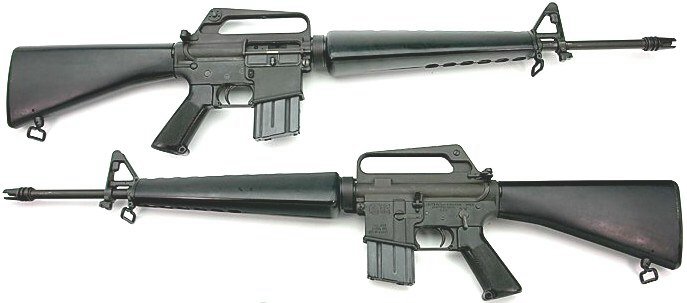 Винтовка
Винтовка
АР-15 (позже М-16),первый вариант.
 Винтовка
Винтовка
М-16 А-1,»поздний» вариант.
Начиная историю М-16,американские авторы обращаются к тому периоду, когда
COLT выкупил у ARMALITE модель винтовки AR-15 со всеми
потрохами и ведущим конструктором.
Так вроде бы и
родилась М16, но в действительности же ее история
начинается несколько раньше.
И в американской
литературе, этот период, можно сказать «зачатия»
винтовки, как правило, не освещается.
Причем, сами
американцы признают, что история создания М-16 полна
интриг, закулисных игр и двуличия.
В борьбе за
продвижение своей винтовки, COLT сыграл немаловажную
роль в упадке SPRIGFIELD ARMORY последовавшему в 1968
году.
Так как же оно было на
самом деле?
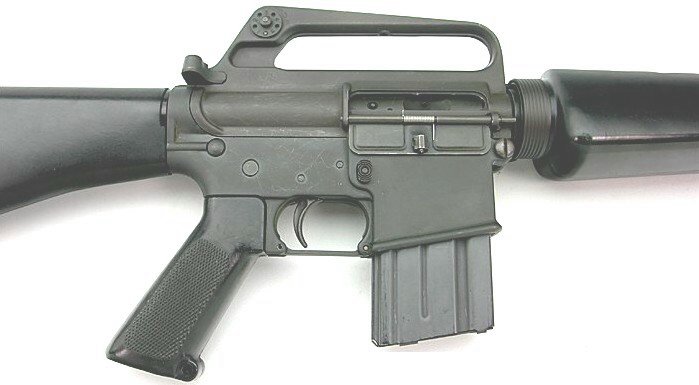
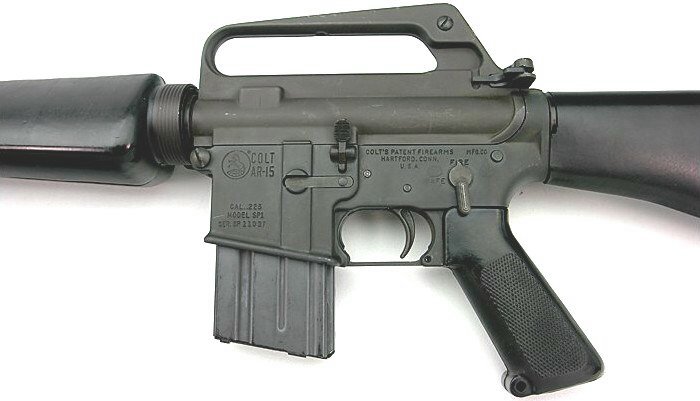 Винтовка AR-15,виды
Винтовка AR-15,видысправа и слева. Первые винтовки AR-15 / М-16 и
М-16-А1 имели трех-щелевой пламегаситель.
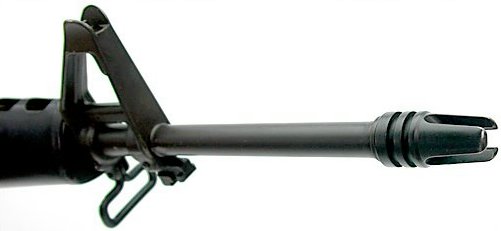 На Западе к концепции
На Западе к концепцииASSAULT RIFLE — «Штурмовой винтовки» довольно долгое
время относились отрицательно, отдавая предпочтение
концепции BATTLE RIFLE — «Боевой
винтовки» (у нас
принято обозначение как «Автоматическая винтовка»).
В рамках этой
концепции под стандартный патрон NATO 7,62х51 (калибр х
длинна гильзы)
были созданы американская М14, бельгийская FN-FAL,
западногерманская G.3.
Однако, уже в самом
начале широкого разворачивания боевых действий
Вьетнамской войны
американцы столкнулись с серьезными проблемами.
Практически с такими
же, что и солдаты германского Вермахта на Восточном
фронте, вооруженные
в основной массе карабинами MAUSER 98k и G.43, они
противостояли
пистолетами-пулеметами в огромном количестве.
В США концепция
создания стрелкового комплекса в виде легкой
малокалиберной штурмовой винтовки, получила путевку в жизнь в
1957 г., практически сразу после того, как была принята на
вооружение винтовка М14.
Первые образцы
винтовок М16, еще под обозначением AR-15, для ее замены
начали поступать
на вооружение в 1962 году. Низкая эффективность огня М14
создала прецедент
оружием менее чем за 10-ти летний период.

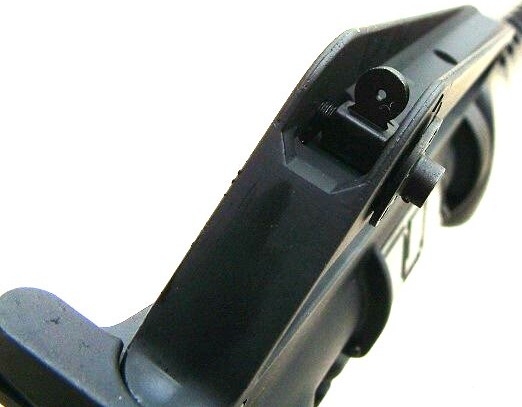 Целик М-16
Целик М-16перекидной,вид сверху.Имеет установки на две дистанции
— до
200 м и до 450 м.А М16 — AR-15 стала
таким образом, первой принятой на вооружение боевой
винтовкой уменьшенного
калибра 5,56 мм.
Касаясь М14 стоить
только отметить, что она выпускалась в двух вариантах:
модель М14Е1
предназначена только под одиночную стрельбу, и модель
М14Е2 с переключателем
для ведения автоматической стрельбы, сошками и
затыльником для
В 1964 году М14 была
снята с вооружения американской армии, но еще и по сей
день используется
в качестве снайперской винтовки и в системе внестроевой
подготовки.
развитие снайперской концепции М14 стала винтовка М21.
Но это совсем другая
история.


Винтовка М-16
«вьетнамского» периода, с магазинами на 20 (точнее,на
17)
и на 30 (точнее, на
28) патронов.
В 1948 году
командование армии США поручает исследовательскому
центру Управления по исследованию операций (ORO —
OPERATIONS RESEARCH OFFICE), созданному при Университете
им. Джона Хопкина (Jonh Hopkin), изучить вопрос
применения обычного вооружения в ядерном конфликте.
Одним из первых итогов
работы ORO должна была стать программа ALCLAD — создание
оптимальной индивидуальной защиты для пехотинца.
В этом исследовании
была собрана и изучена статистика ранений, полученных
солдатами армии США от Первой Мировой до Корейской
войны.
Были сопоставлены
цифры о количестве и расположении ран не теле, типы
ранений, дальность, на которых они были получены. Были
обработаны данные о потерях в личном составе миллиона
солдат.
Исследования показали,
что прицельный огонь утратил былую роль, и большее
количество ран было нанесено от попаданий в ходе
неприцельной автоматической стрельбы, причем очень редко
огонь велся на расстояниях более 300 метров.
В ходе корейской
войны, по опросам 600 пехотинцев до 87% ран было
получено ими на расстоянии менее 300 метров. А ответный
огонь, в 95% случаев они открывали с расстояния около
100 метров.
«вьетнамкого» периода с различными магазинами и
штык-ножом.Опираясь на эти
наработки Командование армии на континентальной части
США (CONARC — CONTINENTAL ARMY COMMAND) объявило конкурс
на создание в период 1953-57 году, автоматической
винтовки, отвечающий этим требованиям. Изначально CONARC
предложил оружейным фирмам создать винтовку, под
гражданский патрон .222 Remington.Окончательные
требования к винтовке сформулировал генерал Вилард Г.
Вайман (Willard G. Wyman): она должна быть высоко
скорострельной, иметь переключатель для ведения
автоматического огня, оснащена магазин емкостью не менее
чем с 20 патронами, весить не более 6 фунтов (примерно
2-2,5 кг), способной пробить американскую каску М1 или
стальную плиту толщиной 3,5 мм с расстояния 500 метров.Новый проект получил
название — программа SALVO.В середине 50-х годов,
так называемая «Группа Стоунера: Юджин Стоунер (Eugene
Stoner) — ведущий конструктор, Роберт Фремонт (Robert
Fremont) — отвечал за изготовление прототипа и Джеймс
Сулливан (James Sullivan) – «главный проектировщик » из
ARMALITE, представила автоматическую винтовку AR-10 под
единый патрон NATO 7,62х51 мм.
Автоматика винтовки работала по принципу отвода
пороховых газов. Для уменьшения отдачи приклад
разместили на одной оси с осью ствола (компоновка
STRAIGHT LINE), что уменьшило плечо отдачи.
Прицел при этом перенесли на ручку для транспортировки,
где в задней ее части поместили вращающий фиксатор
диоптра, позволяющей целится при недостаточной
освещенности по звуку щелчков. В конструкции винтовки
широко применялись алюминиевые сплавы и пластмассы.
Ил. 1. Ил. 2.
Винтовки М16А1, произведенные на различных
предприятиях
(COLT INDUSTRIES и G.М, CORP.).
a — кнопка затворной задержки, b — переводчик режимов
огня.
Ил. 1. Ил. 2.
Винтовки М16А1, произведенные на различных
предприятиях
(COLT INDUSTRIES и G.М, CORP.).
a — кнопка затворной задержки, b — переводчик режимов
огня.В таком виде предстала
перед военными AR-10, ставшая, практически «родной
мамой» семейству AR-15 — M16.Изначально AR-10
создавалась как прямой конкурент винтовкам FN-FAL и M14,
однако оказалась слишком «новой» для своего времени и не
смогла конкурировать по нескольким пунктам требований
SALVO с двумя основными претендентами на вооружение
армии США того времени — Т44Е4 и Т48. Вследствие чего, AR-10
никогда не состояла на вооружении армии США, однако
пользуется значительной популярностью как спортивное и
«тактическое» ружье для полиции и сил правопорядка.
Небольшое количество
AR-10 было продано Судану и Португалии. Винтовка вышла явно
удачной, чем и привлекла внимание американских
генералов. Но согласно
первоначальным требованиям армии — слишком тяжелой и
большой по размеру. Дальнейшие попытки
снижения веса конструкции могло привести к потере
прочности и надежности. Совершенствуя систему,
конструкторы пошли другим путем — уменьшили калибр в
рамках требований ORO/CONARC. Снижение калибра
позволило сразу снизить вес на 800 гр. и увеличить
носимый боекомплект. Справедливости ради
стоит отметить, что впервые решение о переходе на
меньший калибр было принято Оружейным комитетом
Главного артиллерийского управления русской армии еще в
1915 году.
Ил. 3. Винтовка
М16А2 производства COLT.
Переводчик режимов огня а у М16А2 вместо положения
«auto» у М16А1
(автоматический огонь) имеет положение «burst»
(фиксированные очереди
по 3 патрона).Так что, если бы не
октябрь 1917…В целом решение о
переходе на малый калибр можно смело назвать
революционным. И хотя споры между
сторонниками и противниками малого калибра даже среди
специалистов не утихают до сих пор, своим появлением на
свет 5,45-мм АК-74 обязан именно AR-15. Ко времени начала
работ над доработкой AR-10 в рамках проекта SALVO, фирма
SIERRA BULLETS на основе охотничьего патрона .222
Remington, создала боевой патрон уменьшенного калибра
.223 Remington (5,56×45) с пулей весом 5,5 гр.
А ученый-баллистик Эрл
Харви (Earle Harvey) предложил теоретические основы
траектории новой пули, в применении к параметрам оружия
нового калибра. Под новый патрон,
получивший в армии обозначение М193, на базе AR-10 в
1957 году создали винтовку AR-15, в дальнейшем более
известную, как М-16. Уменьшение калибра
привело к увеличению начальной скорости пули до 990
м/сек, что обеспечивало настильную траекторию ведения
огня и прощавшую стрелку незначительные ошибки в
определении расстояния до цели, и позволило, в свою
очередь, упростить прицельные приспособления. Новая винтовка весила
всего 2,89 кг (6,35 фунтов) и строилась по схеме с
отводом газов из ствола прямо в затворную коробку, при
этом газы действовали непосредственно на затворную раму
(в АК газы действуют на газовый поршень в газовой камере
и не попадают в пространство затворной коробки).
У винтовки М-16-A2
(вверху) ствол значительно тяжелее, чем у М-16-А1.
Щелевой пламегаситель выполняет фукцию компенсатора
(внизу отсутствуют две щелевые прорези).Общеизвестный минус
конструкции — повышенная загрязняемость механизмов
пороховой гарью, что соответственно, привело к
ужесточению к требованиям по чистке и уходу за оружием.
К достоинствам такой конструкции относится меньшая масса
подвижных частей автоматики, и меньшее влияние импульсов
от их движения на устойчивость оружия при автоматической
стрельбе.В новой винтовке
Стоунер широко использовал известные наработки по
созданию стрелкового оружия.Например, шарнирную
систему разборки ствольной коробки взяли от бельгийской
FN-FAL, а закрытое окно экстрактора от немецкого MP-40.Помимо этого, к
особенностям конструкции можно отнести затворную
коробку, изготовленную литьем из алюминиевых сплавов,
приклад из полимерных материалов, расположенный на линии
ствола, цевье из такого же материала и пистолетную
рукоятку. Винтовка получила
дэмпфер отката затвора в виде подпружиненного груза, в
который ударяется затворная рама в крайнем заднем
положении. Так как разместить его, кроме как в прикладе,
было негде — это создало проблемы с созданием, а вернее,
привело к невозможности создания модификаций М-16 со
складным прикладом, отсюда — и характерные
«телескопические» приклады на укороченных моделях.
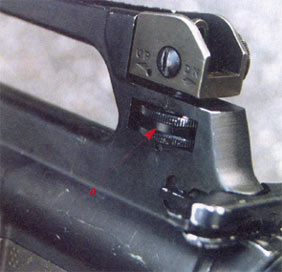
На М-16-А2
установка дальности осуществляется маховичком (а) с
шагом 100 м.
Боковые поправки вводятся с помощью маховичка (b).
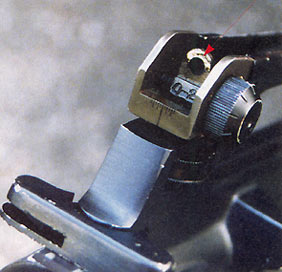
Отверстие большого
диаметра для стрельбы в условиях
пониженной освещенности (слева) и обычных условиях
(справа).Переводчик огня имел
две позиции для стрельбы: один выстрел и очередь.
Прицельные ограничивались мушкой и диоптрического
целика, имеющего установку всего на две дистанции 200 и
450 метров.Но на ARMALITE сделали
одну большую ошибку. После Второй Мировой войны были
четко сформулированы требования к тому, чтобы все
внутренние детали стрелкового оружия, включая ствол,
должны быль обязательно хромированными для
предотвращения коррозии. Такой технологией фирма тогда
не обладала, и Стоунер не стал учитывать это требование
в первоначальном проекте, что чуть было не привело к
фатальным последствиям в дальнейшем.По окончании которых и
подсчитав затраты (около $1,45 млн.), руководство
FAIRCHILD ENGINE пришло к выводу о необходимости
реорганизовать работы на ARMALITE, и продало права на
AR-15 фирме COLT FIREARMS за $75.000 и 4,5% комиссионных
с каждой проданной в дальнейшем винтовки. COLT решает не
терять время, и в 1959 году начинает производство и
продажу коммерческого варианта винтовки. Одновременно
форсируя ее совершенствование для конкурсных
сравнительных испытаний по выбору перспективной
армейской винтовки программы SALVO. В которых участвуют
М-14, Stoner 63, G.3, и чуть позже к ним присоединяется
AR-18.В период 1960-62 гг.
проходит тестирование AR-15 в различных климатических
зонах, в ходе которых выявляются два основных
недостатка: при шаге нарезов 356 мм в арктических
условиях на Аляске, где воздух обладает большей
плотностью, и 5,56-мм пуля слишком быстро теряет
стабилизацию. А независимая рукоятка перезаряжания
исключает докрывание затвора при его загрязнении. В
результате шаг нарезов было решено уменьшить до 305 мм,
при этом несколько уменьшилось убойное действие пули.
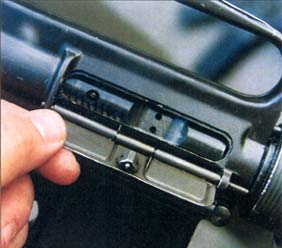
Рисунок А:
Подпружиненная защитная крышка предохраняет механизм
M-l6
от попадания пыли и грязи, первых выпусков.
Открывается автоматически при движении затвора
назад.
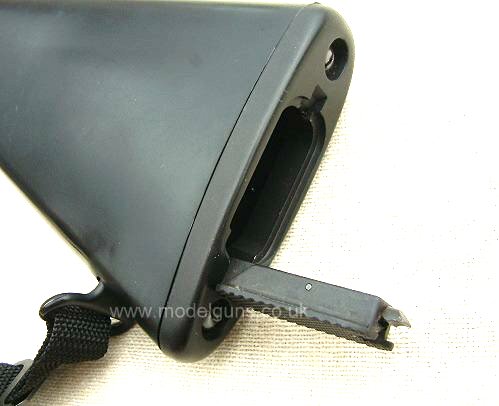
Рисунки Б,В и Г:
..Затыльники прикладов (сверху вниз) винтовок
М-16-А1, М-16-А2 и
M-16 первых выпусков.
Для принудительного
докрывания затвора в случае засорения и досыла патрона,
в приливе с правой стороны стенки ствольной коробки,
винтовка приобрела характерное устройство в виде
клавиши. Необходимость и принцип работы этой детали
объясняется тем, что рукоятка перезаряжания, доступная
для обоих рук стрелка и расположенная на тыльной стороне
ствольной коробки, не связана с затвором жестко и при
стрельбе остается неподвижной. При недозакрытии затвора
необходимо несколько раз нажать на эту клавишу, которая
своим зубом-храповиком продвигает ззатворную раму
вперед, взаимодействуя с гребенкой на боковой
поверхности затворной рамы. Кстати, в плане более
высокой надежности, таковым до сих пор остается
первоначальный магазин на 20 патронов,в который для
более надежной подачи патронов рекомендуют снаряжать не
более 18 патронов. Новый, стандартный удлиненный магазин
на 30 патронов, также рекомендуется снарядить не более
чем 28 патронами.
«Знаменитый»
докрыватель затвора М-16.
При недоходе
затвора в крайнее переднее положение, необходимо
дослать его вперед (докрыть) многократно нажимая
на кнопку (а). В 1962 году COLT
передает в Департамент перспективных исследований и
разработок (ARPA — ADVANCED RESEARCH PROJECT AGENCY)
1.000 экземпляров новой винтовки для испытания в боевых
условиях вьетнамской войны.По итогам испытаний, с
одной стороны был получен восторженный отзыв от полевых
частей и большое количество замечаний к недоработкам со
стороны министерства Обороны и министерства Армии
(DEPARTMENT OF DEFENSE и DEPARTMENT OF THE ARMY).Руководство COLT
максимально использует свое влияние на Государственный
департамент для продвижения своего проекта. Формально
удовлетворив предъявляемые замечания, первые 8.500
винтовок под обозначением М-16, по приказу генерала
Куртиса Лимея (Curtis LeMay) поступает на вооружение
Стратегического Авиационного командование ВВС для замены
карабинов М2.
На цевье и рукоятке
М-16А1 видны повреждения (трещина и скол),
полученные в процессе эксплуатации винтовки.
На фото ниже
вид с нормальными деталями.Не смотря на сильное
сопротивление армии, начальник штаба армии генерал
Масквелл Тейлор (Maxwell Taylor) выступает с резкой
критикой М-16 и рекомендует продолжить производство
М-14. Министр обороны Роберт Макнамара (Robert McNamara)
заключает 15 мая 1962 предварительный контракт с фирмой
COLT на поставку 85.000 винтовок M-16 для опытной
эксплуатации в различных родах сухопутных войск и
покупке еще 19.000 для ВВС.Новая концепция
стрелкового комплекса, суть которой заключалась в
разработке легкой малокалиберной штурмовой винтовки,
получила путевку в жизнь после того, как в 1957 г.
армией США была принята на вооружение 7,62-мм винтовка
М-14. Низкая эффективность огня М14 по сути дела создала
прецедент перевооружения армии основным оружием менее
чем за 10 лет.
Затвор в
сборе.Стрелкой показан отражатель (а).Решение о переходе на
малый калибр можно смело назвать революционным.
И хотя споры между
сторонниками и противниками малого калибра даже среди
специалистов не утихают до сих пор, нужно отметить, что
своим появлением на свет 5,45-мм АК-74 обязан именно
AR-15.В 1959 г. фирма Colt
покупает праве на производство AR-15 у фирмы Armalite и
начинает производство коммерческого варианта винтовки,
одновременно представляя ее для широких конкурсных
сравнительных испытаний по выбору перспективной
армейской винтовки по программе Salvo.Существенно обойдя
конкурентов (М14, AR-18, Stoner 63, и G3M) по основным
боевым характеристикам AR-15 осенью 1961 г. отправляется
в Южный Вьетнам на войсковые испытания. Полностью
удовлетворив всем предъявляемым требованиям, 15 мая 1962
г. она была принята на вооружение ВВС под индексом M-l6.
Армия осторожничала. В 1963 г. был заключен контракт с
фирмой Colt на поставку 85 000 винтовок «M-16» для
опытной эксплуатации в различных родах войск. Все
винтовки были отправлены во Вьетнам. В это же время
«М-16» проходит тестирование в различных климатических
зонах. Выявляются два основных недостатка: при шаге
нарезов 356 мм в арктических условиях, где воздух
обладает большей плотностью, 5,56-мм пуля теряет
стабилизацию.
Затвор в
разобранном виде.
1. Остов затвора. 2. Поворотная личинка. 3. Ударник.
4. Вкладыш (обеспечивает
поворот личинки при взаимодействии с копирным пазом
остова затвора). 5. Чека.
Стрелкой показана гребенка, которая служит для
докрывания затвора.Проблема создания
армейской малокалиберной автоматической винтовки,
способной заменить автоматы привычного калибра, была
решена лишь в середине 50-х гг. XX в. благодаря двум
причинам. Первая из них — создание боевого
малокалиберного патрона, обладавшего целым рядом
существенных преимуществ как в боевых свойствах, так и в
отношении производства патронов и оружия под них. Вторая
причина появление новых технологий изготовления оружия и
новых материалов, в первую очередь литьевых пластмасс и
высокоточной штамповки деталей сложной конфигурации.
Задняя часть
газоотводной трубки выходит непосредственно
в ствольную
коробку.
Переход к уменьшенному
калибру патронов позволил разработать оружие меньшей
массы, существенно повысить начальную скорость полета
пули, уменьшить отдачу и рассеивание пуль при стрельбе
очередями. Применение литьевых пластмасс сделало
производство отдельных деталей оружия практически
безотходным.
В первую очередь это
касалось таких трудоемких при изготовлении элементов,
как приклады, ложи, цевья.
В 1956 г. в США
специалисты фирмы «Remington Arms» разработали новый
малокалиберный боевой патрон калибра 5.56×45 с пулей
массой 3.6 г и начальной скоростью полета около 1000
м/с. Обладая малой величиной отдачи (ее импульс равнялся
0,5 кгс.с), он обеспечивал повышенную кучность стрельбы
очередями. Патрон получил наименование М-193. Под него
главный инженер фирмы «Армалит» Юджин Стоунер создал
серию облегченных винтовок — самозарядную AR-7 и
автоматическую AR-15 (1957). В 1964 г. в районе
Вашингтона состоялась демонстрация этих новых образцов
винтовок со стрельбой на дистанцию 90 м. Мишени были
поражены, но в ходе стрельбы было много задержек по вине
винтовок, и армия от заказа на них воздержалась.
После доработки AR-15 она получила наименование М-16.
Винтовка
ХМ-177,ранний вариант.На поздних вариантах был
знаменитый «докрыватель»В 1959 г. права на
конструкцию, производство и продажу винтовок приобрела
фирма «Кольт». Авторитет фирмы и широкая реклама
положительных качеств М-16 привели к принятию ее на
вооружение в 1960 г. для ВДВ США, а затем в 1963 г. и
сухопутных войск. А далее началась история явных неудач
американской винтовки, неприятие ее армией из-за
недопустимо низкой надежности, причиной которой была
сама конструкция автоматики.
Впервые именно при ее изготовлении так широко
использовали пластик и сплавы.
Впоследствии конструкторы доработали AR-10 в
соответствии с требованиями американских военных и
получили AR-15.
Стреляющая новым 5,56-мм патроном, она выгодно
отличалась от винтовок, состоявших на вооружении
американской армии.
Однако в 1959 году армия потеряла интерес к этой
разработке и озаботилась созданием оружия с калибром
6-мм по программе «Личное оружие специального
назначения.» (SPIW).
Это могло бы стать концом истории, но тут на сцене
появились ВВС США, которые были заинтересованы в
получении компактного оружия для вооружения им
подразделений охраны аэродромов.
Представители ВВС осмотрели AR-15, которая им очень
понравилась, в результате чего в 1962 году был сделан
заказ на поставку 8000 штук.
Винтовка
ХМ-177Е-2,»поздний» вариант (вверху) и винтовка
ХМ-177Е-2,вид справа.
На нижнем фото карабин модели 653,отличавшийся от
модели ХМ-177 Е-1 более длинным стволом.Через некоторое время
эти образцы направили подразделениям охраны во Вьетнам.
В Армии Южного Вьетнама (АЮВ), изучив эти винтовки,
решили, что они могут стать идеальным оружием для
невысоких вьетнамских воинов.
В результате США получили заказ на поставку этих
винтовок еще и от АЮВ.
Тысячу из них привезли
во Вьетнам в 1962 году, и они довольно быстро завоевали
популярность.
Здесь опять появилась армия США.
Программу SPIW она признала ошибочной, и военные вновь
обратили внимание на AR-15.
В 1963 году изготовители получили заказ на 85 000
винтовок для сухопутных войск и 19 000 экземпляров для
ВВС.
Все винтовки сразу отправляются во Вьетнам.
Однако последующие отчеты, представленные отделом
Вооружений (ORDNANCE DEPARTMENT) вскрыли невысокую
надежность М-16, при том, что она, по их
мнению,действительно уравнивала американских пехотинцев
в их огневой мощи с противником, вооруженным советскими
АК. Эти отчеты, в свою очередь, хвалили и главного
конкурента М-14, как более качественную и надежную
винтовку, которая была просто «немного тяжелой» для
горячих джунглей Юго-восточной Азии, и вследствие чего
патрули не могли брать с собой более 50-100 патронов,
ограничивая себя в ведении автоматической стрельбы.
В остальном, она вполне устраивала армию.
Дальнейшее решение спора и оценку М-14 и М-16 передали
независимым агентствам. Их заключение гласило: М-14
действительно не была столь плоха, как ее хотели
представить, но и М-16 не была столь хороша, как
хотелось бы.
Руководство COLT не замедлил воспользоваться
расплывчатой формулировкой итогов сравнительных
испытаний и шумихой поднятой вокруг М-16, начало «игру»
против М-14.Упирая на то, что М-16 имела больше
возможностей для совершенствования и была более
подходящей для Вьетнама.
Винтовка М-16,модель 655, ранний вариант.На
поздних вариантах был знаменитый «докрыватель».
Отзывы с полей боев
тоже были весьма противоречивы.После боев в долине
Ладранг (La Drang) подполковник, в последствии
генерал-лейтенант, Гарольд Мур (Harold Moor) писал,что
только храбрость солдат и винтовка М-16 принесли победу
(хотя здесь, по мнению Пола Дефендера, налицо была явная
подтасовка фактов: в отличие от большинства солдат и
офицеров,служивших во Вьетнаме, Гарольд Мур к тому
времени имел опыт службы более чем в 20 лет и был уже
ветераном Второй Мировой войны и войны в Корее).
Во Вьетнаме винтовку проклинали, она заслужила репутацию
капризного и ненадежного оружия из-за множества отказов
и задержек во время стрельбы.
Это происходило потому, что американские производители
патронов сменили тип применяемого пороха, не
озаботившись предупредить войска.
Новый порох был более грязным и образовывал больше
нагара.
Заполнение же затворной рамы нагаром приводило к
возникновению проблем.
Потребовалась серьезная разъяснительная работа в
войсках, раздача комплектов для чистки оружия и
улучшение качеств пороха, для того чтобы решить этот
вопрос.
Военные настояли на внесении некоторых изменений в
конструкцию винтовки.
Наиболее значимым стало создание «приспособления для
ручного запирания затвора».
Выяснилось, что грязный патрон или загрязнение
патронника могли привести к заклиниванию затвора.
Винтовка «М-16-А 1
LMG». Обратите внимание на утяжеленный ствол и сошки.
Также обратите внимание на «гребень»-переходник с
планкой типа «ласточкин хвост»
в левом нижнем углу, который легко приворачивается к
рукоятке, после чего
можно легко поставить практически любой оптический
прицел.
Также нужно сказать, что у модели «LMG» были
прямоугольные либо квадратные накладки.
Винтовка М-16,
набор американского морского пехотинца начала 1990-х
годов.Причиной, по которой грязный порох
мешал стрельбе, была особенность конструкции винтовки.
Один морской
пехотинец писал домой следующее: «Я нахожусь в
госпитале, на борту судна. Мы пошли в бой с 1400
солдатами в нашем батальоне, вернулись с половиной. В
нашей роте было 250 человек, теперь осталось 107. Во
взводе было 72, вернулось только 19. Я обязан жизнью
судьбе, которая послала мне это ранение. Поверите ли
вы мне? Но нас убивали наши собственные винтовки!
После боя, почти каждый убитый морской пехотинец был
найден с неисправной винтовкой.Большинство солдат было
убито и ранено во время устранения неисправностей.
Учитывая политическую ситуацию в США по отношению к
войне во Вьетнаме «ненадежная» М-16 попала в поле зрения
журналистов, настроенных против политики Госдепа.
Газеты писали, что в армию поставляется дефектное
оружие, за которое расплачиваются кровью американские
парни…
В судьбу М-16 был
вынужден вмешаться президент Джон Ф. Кеннеди — JFK (John
F Kennedy), который уполномочил министра Армии Сайруса
Венса (Cyrus Vance) провести испытания М-14, М16 и
АК-47.
Протокол испытаний был откровенно положительным в
отношении М-14 и требовали возобновить производство
М-14, остановленное 23 января 1963 года. Венс
расследовал методику и порядок испытаний армейских
инспекторов, и пришел к выводу, что они явно
симпатизировали М-14.8 февраля 1964 М-16
была признана основной винтовкой американской армии.
Форсирование судьбы
М-16 было связано как с первыми положительными
результатами ее боевого применения во Вьетнаме и
прекращением производства винтовки M-14, так и с
нежеланием использовать вместо нее совсем устаревшую
винтовку M-1. В то же время, опыт широкой боевой
эксплуатации выявил еще ряд серьезных конструктивных
недостатков винтовки М-16, послуживших поводом для
создания специальной комиссии, назначенной конгрессом
США, для установления причин неудовлетворительной работы
автоматики винтовки.
Винтовка
М-16-А2 модели 723 «Carbine».У модели же 733 ствол
более короткий.
На нижнем фото размещен карабин модели 733 для
гражданского рынка и на экспорт
Для того, что бы
окончательно разрешить спор между М-14 и М-16, 15 мая
1967 проблема была передана для изучения специальной
комиссии конгресса США во главе с конгрессменом Ричардом
Ичхорном (Richard Ichord).
В ходе пятимесячных исследований комиссией были
проведены специальные испытания М-16 в форте Беннинг,для
Армии США (Fort Benning,одна из официальных баз армии
США,где проходят подготовку солдаты для службы в
воздушно-десантных войсках и войсках спецназа) в США и
лагере Пендлтон,для Корпуса морской пехоты США (Camp
Pendleton,один из лагерей Министерства морского флота
США,а точнее,одна из баз морской пехоты США). После них
комиссия пришла к выводу, что задержки в стрельбе
происходят в том числе и из-за недостаточного обучения
солдат обращению с новым оружием и как следствием —
плохого повседневного ухода за ним.
М-16 требовала больше внимания к обучению обращению с
ней и чистке.
Винтовка была передана армии, прежде чем были закончены
десятимесячные производственные испытания, причем
проектировщики и армейские эксперты не имели между собой
никакой связи.
А самое главное, для М-16 Стоунер использовал тип пороха
IMR, который ARMALITE применила еще на первых моделях
AR-15. В армии же порох в патронах с IMR4475 был заменен
на WC846.
Фирме COLT было разрешено испытывать винтовки патронами
с порохом IMR, так как, половина выпускаемых винтовок не
выдерживала приемосдаточных испытаний при стрельбе
патронами с порохом WC846.
Армия продолжала поставлять во Вьетнам большое
количество патронов с другим типом пороха, что было
оценено комиссией как «преступная халатность».
Винтовка AR-15,
ствольная коробка откинута.Вышеуказанная замена
марки пороха была произведена из-за невозможности
производства большого объема быстрогорящего пороха IMR в
связи с большой отбраковкой и стремлением к унификации
порохов 5,56-мм и 7,62-мм патронов, а еще и потому, что
температура пороховых газов сферического
медленногорящего пороха WC846 ниже, что приводит к
повышению ресурса ствола.
Снаряжение патронов порохом WC846 привело к увеличению
импульса пороховых газов, действующего на стебель
затвора. Максимальное давление этого пороха ниже, чем у
IMR.
В то же время начальная скорость пули одинакова,
следовательно, давление в стволе у газоотводного
отверстия выше. Повышение импульса отдачи затвора
привело к повышению темпа стрельбы до 1000 выстр./мин
(при допустимой норме — 850 выстр./мин).
Конструкция M-16 была рассчитана на раннее отпирание
затвора при давлении 700-840 кг/см2.
При увеличении импульса пороховых газов отпирание
затвора происходит при большем давлении, что приводило к
заклиниванию гильзы в патроннике.
Взаимодействие остатков продуктов горения с влагой,
адсорбируемой из воздуха, приводит к образованию кислот,
вызывающих интенсивную коррозию нехромированного
патронника,что так же способствует заклиниванию гильз и
их поперечным разрывам.
Причина невыбрасывания гильз — попадание несгоревших
остатков пороха и мелких стружек, соскабливаемых с
гильз, на захваты выбрасывателя, что приводит к
соскальзыванию зацепа выбрасывателя с закраины гильзы.
Винтовка М-16 А-2 с
магазином 30 патронов.
Винтовка М-16 А-2 с
магазином на 20 патронов.
Винтовка М-16 А-2 с
магазином на 30 патронов.Это и стало главной
причиной появления дефектов типа «пропуск подачи
патрона» и «неправильная подача патрона».
Кроме этого, оказалось, что малокалиберные стволы (до 6
мм) обладают капиллярной способность и удерживают влагу,
конденсируя водяные пары в канале ствола, которая при
стрельбе вызывает повышение давления пороховых газов до
величины, достаточной для разрыва ствола.
Вода вытекает из канала ствола оружия, если винтовку
повернуть дульной частью вниз и приоткрыть затвор. чтобы
избежать попадания влаги в ствол, вышло наставление с
рекомендацией пользоваться дульными колпачками.
С целью устранения этих недостатков был проведен целый
ряд мероприятий: изменена конструкция направляющей
возвратной пружины, она стала выполняться в виде буфера
противоотскока, и амортизирует удар подвижных частей в
заднем положении, уменьшая скорость наката и снижая темп
стрельбы до допустимой нормы.
Патронник хромировали, что исключило его быструю
коррозию и облегчило чистку.
В ЗИП винтовки ввели
извлекатель для извлечения остатков гильзы при
поперечном обрыве.
Для уменьшения трения подвижных частей рекомендовали
использование специальной смазки.
Продолжительность обучения солдат по уходу за винтовкой
увеличили с 10,5 до 26,5 часа,а в комплект винтовки
ввели еще и четырехколенный шомпол для чистки винтовки и
выбивания гильз из патронника.
Шомпол удалось разместить в гнезде затыльника приклада.
Чистка стволов винтовок более раннего изготовления
производилась с помощью капронового шнура с
металлическим наконечником, пропускаемым в ствол и
протягиваемым вместе с ветошью.
раневой канал пули
М-193С этими изменениями
винтовка получила обозначение ХМ16Е1 и 27 февраля 1967
г. окончательно принимается на вооружение, для широкого
оснащения сухопутных войск, ВВС и Морской пехоты. 16
июня 1967, для войск, находящихся во Вьетнаме,
министерство Обороны США выдает заказ на производство
840.000 М-16 на сумму $91,7 млн., со сроком выполнения
заказа уже к концу 1967 г.Темпы поставок
вынуждают фирму COLT разместить заказы на производство
винтовок в фирмах HYDRAMATIC DIVISION OF GENERAL MOTOR
CORPORATION и HARRINGTON & RICHARDSON.Для ручного запирания
затвора с правой стороны винтовки был выведен
специальный шток. С этим приспособлением
винтовка стала называться М-16 А-1 и получила
официальное «благословение». Только после этого к
М-16 перестали предъявлять претензии. После всесторонних
испытаний,в том числе и в войне во Вьетнаме, в 1967 году
под наименованием М-16-А1 была принята на вооружение
сухопутных войск.Вместо изначального
магазина на 20 патронов был принят новый, на 30
патронов. Щелевой пламегаситель заменен на так
называемую «птичью клетку» (BIRDCAGE) — цилиндрический с
продольными прорезями по бокам.
Безусловно вызывает интерес и такой факт: первые
трофейные винтовки M-16 попали в СССР на испытания в
Минобороны и Оборонпром еще в 1967 году. Проведенные
испытания выявили ряд положительных качеств, среди них —
высокое убойное действие пули, хорошие эргономические
показатели, достаточно высокая эффективность огня на
требуемых тактических дистанциях, значительное снижение
веса носимого боекомплекта. Но наряду с этим
испытания показали, что винтовка отличается чрезвычайно
низкой служебной прочностью и безотказностью работы
автоматики. Особо подчеркивалось, что винтовка
практически не пригодна к ведению рукопашного боя.Боевое крещение М-16
во Вьетнаме показало, что задержки происходят
непростительно часто. Тогда винтовки оснастили
дополнительным устройством для ручного досылания затвора
на случай отказа оружия из-за его загрязнения. Внедрение
такого новшества обошлось Министерству обороны,
примерно, 50-90 млн долларов в нынешних ценах с учетом
масштабов производства.А с точки зрения
конструктора оружия потребность в таком устройстве —
яркое доказательство низкой надежности системы. Понимали
ли это создатели винтовки? Конечно, да! Понимало это и
военное руководство армии США. Но коммерческие интересы
могущественной фирмы, производящей винтовки М-16-А1,
оказались важнее интересов армии.
Сейчас же можно более подробно описать события,
связанные с «проталкиванием» на вооружение винтовки
М-16.Положительные отзывы о
винтовке М-16А1 в первые годы ее применения исходили,
главным образом, не от военных, а от журналистов. Их
мнение разительно отличалось от мнения военных, которые
еще в ходе войны во Вьетнаме отмечали значительное
количество задержек в стрельбе из винтовки из-за
недохода подвижных частей в переднее положение при
загрязнении патронника.
Производители винтовки продолжали настаивать на ее
пригодности для армии, которая продолжала закупать
винтовку. Появились модификации М-16-А2, затем —
М-16-АЗ, М-16-А4.
Но все они без исключения сохранили конструкцию
автоматики первого образца и поэтому оставались оружием
крайне ненадежным. А восхваление винтовки в средствах
массовой информации упорно продолжалось.
Так, после военных действий в 1991 г. в Ираке в
американском журнале «Guns and Ammo» в статье Ч.Коуэна
«Стрелковое оружие в операции «Буря в пустыне»
утверждалось, что М-16-А1 может надежно функционировать
в условиях сильного засорения, например песком, потому,
что ее конструкция сама по себе предотвращает
загрязнение автоматики». Такое утверждение выдавало
желаемое за действительное. И это при условии, что еще
первые годы эксплуатации М-16 в войсках отчетливо
показали ее конструктивный недостаток. В ржавеющем
патроннике заклинивало гильзу, подвижные части не
доходили в переднее положение. В винтовке было много
труднодоступных в процессе чистки мест. А в руководствах
к ней утверждалось, что она — «самоочищающаяся» и вовсе
не требует чистки. В 1966 г. компания «Кольт» заключила
контракт на поставку армии 840 тыс. винтовок. В 1967 г.
министр обороны США утвердил вариант М-16А1 с
устройством для досылания подвижных частей в переднее
положение вручную. Сам факт необходимости оснащения
винтовки М-16 таким спецустройством был достаточно
убедительным сигналом о наличии принципиального
конструктивного недостатка в схеме действия автоматики.
Однако компания «Кольт» через средства массовой
информации организовала мощную рекламную кампанию, в
ходе которой, вопреки логике, функционировала винтовка
М-16 А-1 как самоочищающаяся при стрельбе. В мае 1967 г.
в печати США публикуются итоги опроса 250 солдат с
однозначным выводом о непригодности винтовки для войск.
Однако к выпуску М-16 уже был подключен ряд ведущих
компаний и изменить ничего было нельзя, шла война во
Вьетнаме, и оружия не хватало. В 1982 г. группа
экспертов выпустила обширный доклад с осуждением
компании «Кольт» за выпуск винтовок, непригодных для
армии.
Все возвратившиеся с войны винтовки М-16-А1 были в
нерабочем состоянии. Тем не менее компания
«Кольт» не собиралась упускать выгодный контракт и в
1972 г. приступила к производству новой модификации М16
— М16А2. В нем используется бельгийский патрон SS109
большей массы, чем М-193; ствол утяжелен и изменен шаг
нарезки до 178 мм, что повысило устойчивость пуль в
полете (скорость вращения пули с 3246 оборотов в секунду
повысилась до 5560 оборотов в секунду). Последующие
модификации М-16АЗ и М-16-А4 внесли ряд
усовершенствований в конструкцию, однако устройство
автоматики осталось неизменным. А значит, сохраняется
главный недостаток системы — низкая надежность.
Таким образом,
во всех винтовках семейства М-16 не устранена причина
неприятия их в армии. Военное руководство оказалось
бессильным перед могущественным заявлением оружейных
магнатов; винтовки продолжают состоять на вооружении
войск 50 лет в армиях США и ряда других государств.
Все эти годы
недостатки конструкции автоматики продолжают сказываться
на надежности. Даже последние модификации М-16 давали
частые задержки при действиях в условиях песчаной
пустыни в ходе военных действий в Ираке в 2003-2004 гг.
При этом производители винтовок продолжают утверждать,
что поток газов, отводимых из ствола для приведения в
действие автоматики, сам очищает механизм винтовки и не
требует специальной чистки. Заказ на производство
винтовок М-16 в США сохраняется.Большая часть оружия,
чье действие основано на принципе отвода пороховых
газов, имеет газовый поршень, который под действием
пороховых газов, поступающих из канала ствола, отходит
назад, отводя затворную раму. Но в М-16 поступили
по-другому. Итак, что же в итоге
представляла из себя М-16, ставшая с одной стороны
предметомхвалебных отзывов и с
другой — объектом разбирательств многочисленных
комиссий?Автоматика винтовки
работает за счёт отвода пороховых газов из канала
ствола. Запирание ствола
осуществляется поворотом затвора. Особенностью газовой
автоматики винтовки является отсутствие толкателя или
затворной рамы с газовым поршнем,как это принято в
других подобных образцах. Из-за отсутствия
поршня газы отводятся назад через газовую трубку прямо в
затворную раму, которая под воздействием газов движется
назад. Когда пуля проходит
отверстие в стенке канала ствола,часть газов поступает в
газовый канал и,через газовый регулятор,непосредственно
внутрь затворной рамы. Под действием давления
пороховых газов, при отходе затворной рамы назад
фигурный вырез, в который входит выступ затвора,
заставляет затвор повернуться. Затвор отпирает канал
ствола, после чего затворная рама отводит затвор
назад,во время этого происходит удаление стреляной
гильзы. Такое конструкторское
решение позволило снизить влияние движущегося при
стрельбе затвора на устойчивость оружия и уменьшить
массу самого запирающего затвор узла. Затем две пружины
возвращают затвор вперед, новый патрон досылается в
патронник, происходит перезарядка оружия. При движении затворной
рамы назад взводится курок. И новое нажатие на
спусковой крючок приводит к выстрелу. Режим автоматической
стрельбы достигается за счет того, что после запирания
затвора затворная рама не удерживает автоспуск, который
освобождает курок. Работа механизма
винтовки: для взведения рукоятка затвора отводится
назад, если патронов в магазине нет, то подаватель
фиксирует затвор в заднем положении и затвор
останавливается.В противном случае
затвор забирает патрон и досылает его в патронник и
останавливается только, когда патрон полностью входит в
патронник. Затворная рама продолжает двигаться и
поворачивает затвор против часовой стрелки на 20 град.,
семь запирающих выступов входят в упоры ствола.После установки
переводчика огня и нажатия на спуск происходит выстрел.При котором шептало
выходит из зацепления с вырезом на курке и бьет по
ударнику.Под действием
пороховых газов рама движется назад, поворачивая и
отпирая затвор.После этого она
захватывает затвор и продолжает откат вместе с ним.Выбрасыватель
извлекает гильзу и подпружиненный палец, отражаясь в
зеркале затвора, выбрасывает ее в окно на правой стороне
ствольной коробки. Затворная рама сжимает пружину и цикл
повторяется.Можно сказать, что
спусковой механизм М-16 в целом создан на базе механизма
винтовки GARAND М1. Как уже неоднократно говорилось, в
отличие от АК, автоматика М-16 строится на отводе
пороховых газов через поперечное отверстие в стволе,
через которые газы по длинному газоотводу попадают в
ствольную коробку и воздействуют на поршень, укрепленный
на стебле затвора (в АК поршень расположен
непосредственно в газоотводной трубке). Рукоятка
взведения имеет Т-образную форму, разобщена с затвором,
и оттягивается до крайнего заднего положения. При
задержке подачи патрона досылка осуществляется
специальной кнопкой. В АК досылка осуществляется
рукояткой взведения, жестко связанной с затвором, что в
критических ситуациях досылания патрона и при
срабатывании автоспуска приводит к неизбежной травме
руки. Надежность работы автоматики М16 зависит от
постоянства остаточного давления и от коэффициентов
трения в механизме. АК напротив, работает в импульсивном
режиме. После израсходования всех патронов затвор
остается в крайнем заднем положении на затворной
задержке, имеющей наружный орган управления на левой
стороне спусковой коробки в виде переключателя
предохранитель/один выстрел/очередь. Прицел
диоптрический, с перекидным целиком на две дистанции.
Основанием диоптра служит рукояткой для переноски
винтовки и базой для крепления ночного и оптического
прицелов. Приведение винтовки к нормальному бою
осуществляется перемещением (ввинчиванием —
вывинчиванием) мушки по вертикали и перемещением целика
по горизонтали с помощью ходового винта на правой
стороне рукоятки для переноски винтовки. Ствольная и
спусковая коробки изготовлены из алюминиевого сплава.
Цевье, состоящее из правой и левой пластмассовых
ствольных накладок имеет теплоизолирующий экран и
треугольное сечение с основанием треугольника в нижней
части очень удобное при стрельбе «с руки».
Гильзовыводное окно ствольной коробки закрывается
пылезащитным щитком с защелкой и автоматически
открывается при заряжании винтовки.На дальности 400
метров патроны, калибр которых 5,56 мм обладают более
высоким убойным действием, чем калибр 7,62. Из-за
меньшей кинетической энергии, они при встрече с
преградой теряют устойчивость и образуют рваные раны.
Снижение веса боеприпаса позволило пехотинцу брать в бой
в 2-3 раза больше боеприпасов. Для вооружения сил
Специального назначения (SPECIAL FORCES, RANGERS,
AIRBORNE, AIR ASSAULT), возникла необходимость в
коротком оружии — более удобном для ношения и ведения
ближнего боя.Согласно заданию
проекта SAWS (SMALL ARMS WEAPONS SYSTEMS) в середине
1964 года на базе винтовки AR-15 был разработан карабин,
получивший обозначение CAR-15. Первые модели были
очень похожи на уменьшенную винтовку и имели стволы
длиной 15 и 16 дюймов (381 и 406 мм), укороченное
цевье и газоотводное отверстие большего диаметра,
необходимое для надежной работы автоматики. После ряда
исследований удалось уменьшить еще и вес затвора. Из-за
более короткого ствола (у AR-15 — ствол длинной 20
дюймов, или 508 мм) несколько уменьшилась длина
прицельной линии (кстати, у АК она еще меньше). Учитывая
специфику задач спецназа, когда практическая дальность
стрельбы редко превышает 200 метров, и за счет того, что
стрельба ведется «промежуточным» патроном, уменьшение
прицельной линии не сказалось на точности. По
статистическим данным того времени, обычная пуля,
выпущенная с 200 метров, попадала в цель гораздо чаще,
чем снайперская с 600-метрового расстояния. Не стоит и
забывать, что карабин — это оружие для стрельбы
навскидку.Генерал Юнт
сообщил фирме «Colt» об увеличении заказа ещё на 765
единиц, впервые упомянув название нового автомата «Colt
Commando».
Окончательно детали контракта на 2815 автоматов
«Commando Model» были согласованы 28 июня 1966 года.
Типовые испытания
нового автомата, проведённые в июле-сентябре на
Абердинском полигоне, выявили особенности оружия по
сравнению с «М-16», связанные с укорочением ствола.
Звук выстрела стал
чрезмерно громким, а дульное пламя недопустимо большим.
Темп стрельбы автомата
заметно зависел от условий ведения огня.
К тому же, по сравнению с прототипом, снизилась
живучесть оружия и возросло рассеивание. Разом решить все
перечисленные проблемы призвано было дульное устройство
новой конструкции, отработанное к концу того же года.
После
удовлетворительных полигонных испытаний в 20-х числах
января 1967 года автомату «CAR-15 Commando»
присваивается армейское обозначение «SUBMASHINE GUN
5,56-mm XM-177» (версия для ВВС) и «ХМ-177-Е-1» (версия
для армии). Автоматы снабжались
складными телескопическими прикладами конструкции Роба
Роя, получившего на него патент в США за номером
3,348,328. Винтовка с таким
прикладом в сложенном положении, надевавшимся на кожух
возвратной пружины, имела длину 28 дюймов (711 мм), в
разложенном – 31,25 дюйма (79,1 мм). Вскоре дуплекс
«ХM-177»/«XM-77-E-1» заменили единым «XM-177-E-2» с
удлинённым на полтора дюйма (38 мм) стволом и более
новым пламегасителем. В апреле было принято
решение о направлении 510 единиц автоматов «Сolt AR-15
XM-177-E-2» в специальную группу действующей армии во
Вьетнам. Первый опыт применения
новых автоматов в боевых действиях в очередной раз
выявил их серьёзные недостатки. Дульное устройство
оказалось малоэффективным уже при незначительном
количестве выстрелов.Для проведения
исследований, направленных на устранение выявленных
недостатков, в середине ноября 1968 года фирма «Кольт»
запросила у заказчика шесть месяцев, оценив объём работ
в 40 000 долларов. Однако, несмотря на
популярность автоматов «ХМ-177-Е-2» у бойцов
подразделений специального назначения, военными было
принято решение, что короткий 11,5-дюймовый (242 мм)
ствол всё-таки не обеспечивает необходимую дальность и
точность стрельбы (хотя, как считает Пол Дефендер, дело
здесь было все-таки в шаге нарезов, что подтверждается
популярностью карабинов «Colt-M-4»). В результате программа
по разработке короткоствольного автомата на базе «М-16»
была свёрнута к 1970 году. К тому же Бюро но
обороту алкоголя, табака и огнестрельного оружия (Bureau
of Alcohole, Tobacco, and Firearms — ВАТF) вдруг
решило,что дульное устройство автомата является
запрещённым законом к обороту глушителем, и запретило
продажу «ХМ-177-Е-2» на гражданском рынке и ее экспорт.
После окончания войны
часть автоматов попала в правоохранительные органы США.
Следующая, получившая
обозначение «ХМ-4» укороченная версия винтовки «М-16»
появилась в армии и в морской пехоте США в середине 80-х
годов (об этой модификации у Пола Дефендера нет никаких
сведений, однако будет логичным предположить, что это та
же самая модель 733, но с иным шагом нарезов).
Конструкция
«ХМ-177-Е-2», кроме упомянутых телескопического приклада
и дульного устройства, отличается oт «M-16» всего лишь
несколькими деталями.На укороченном стволе стойка мушки
перенесена ближе к ствольной коробке. Пластиковые
накладки цевья стали короче и получили характерные
поперечные рёбра. В отличие от
винтовочного, к сечении близкого к треугольнику со
скруглёнными углами, автоматное цевьё стало
цилиндрическим.
Все остальные узлы и элементы у винтовки и у автомата
взаимозаменяемы. После пекла Вьетнама
многие страны заинтересовались стрелковым оружием
уменьшенного калибра.В 1980 году на
международных испытаниях в рамках работы по унификации
боеприпасов стран NATO бельгийский патрон SS109, с пулей
имеющей стальной сердечник (в армии США обозначение
М855), показал лучшие результаты, чем М193. Хотя на глаз
оба патрона абсолютно одинаковы, пуля М855 имеет лучшую
аэродинамическую форму, она устойчивее в пролете, имеет
большую скорость вращения и поэтому медленнее теряет
кинетическую энергию. На дистанции 400 метров она на 50%
выше, чем у пули М193. На дальности до 100 метром пуля
М855 способна пробить броню толщиной 3,5 мм, а на
дистанции до 300 метров пробивает американскую каску.Но патрон М855 5,56х45
мм, наиболее эффективен при использовании в стволе с
ходом нарезки 178 мм, так как его пуля на 0,4 гр.
тяжелее американского. Патрон М193 в свою очередь
наиболее эффективен в стволе с ходом нарезки 305 мм. В
некоторых нейтральных странах требования не совпали со
стандартами NATO, и поэтому винтовки М-16-А1 выпускались
c ходом нарезки как 178 мм, так и 305 мм (приоритетным
боеприпасом для М-16-А1 первых выпусков оставался
американский патрон) от обыкновенных большей длиной,
вообще оказалась невозможной ввиду их кувыркания после
покидания ствола. Позже появилась
винтовка М-16 А-2.Обобщив 20-летний опыт
эксплуатации винтовки M16A1, и в соответствии с
возросшими требованиями обеспечения пробивного действия
по целям, защищенным средствами индивидуальной
бронезащиты винтовка вновь была модифицирована в начале
80-х.Необходимость
модернизации был вызван еще и тем, что бельгийский
патрон SS109 (американское обозначение М855) в 1980 году
был принят в качестве стандартного 5,56-мм патрона NATO.
А при стрельбе пулей патрона M193 необходим ход нарезов
305 мм,для M855- 178 мм.Для обеспечения более
интенсивной стрельбы ствол был заменен на более тяжелый.
Так как изменение крутизны нарезки ствола привело к
повышению напряжений в металле, при выстреле и движении
пули, в результате вес ствола винтовки А2 на 170 гр
больше, чем у А1. Из М16А2 можно стрелять и патроном
М193 с небольшой потерей убойных качеств его пули, но
штатным остается М855.Пламегаситель тоже
немного видоизменили, и он стал выполнять функцию
компенсатора.В нем убрали две
нижние прорези, что уменьшило тенденцию к подпрыгиванию
винтовки при стрельбе и уменьшило пылеобразование. При
стрельбе винтовку рекомендуется немного наклонять,
направо — при стрельбе с правого плеча, и налево — с
левого, это придает большую устойчивость при стрельбе
очередями.Кроме того, был введен
механизм ограничения длины очереди до 3 патронов —
специальный храповик с тремя зубьями на оси шептала. Но
на заказ можно изготовить и режим переключения ведения
автоматического огня — один выстрел / бесконечность.В новой модели были
впервые применены устройства, позволяющие вводить
поправки нулевой точки прицеливания в зависимости от
дальности стрельбы и бокового ветра. У целика нового
диоптрийного прицела два отверстия: диаметром 5 мм для
ведения огня в сумерках и 1,87 мм для стрельбы днем.
Мушка имеет прямоугольную форму, что уменьшает ошибку
прицеливания. Введен механизм установки дальности
стрельбы до 800 м с шагом по 100 м.На правой стороне
ствольной коробки появился выступ — дефлектор, для
отражения стреляных гильз при стрельбе с левого плеча во
избежание попадания их в лицо стрелка-левши. Для
удобства удержания винтовки при стрельбе очередями «с
руки» на пистолетной рукоятке добавили упор для среднего
пальца. Так как пластмассовые
детали М-16-А1 часто не выдерживали эксплуатационных
нагрузок,новые приклад и цевье изготовили из
ударопрочного полиамида. Главная внешняя отличительная
черта модификации А2 — ребристая ствольная накладка
изготовлена из взаимозаменяемых половин не из
стеклопластика, а из специальной ударнопрочной
пластмассы, с повышенными теплоизоляционными свойствами.
Для упрочнения, она имеет характерные ребра жесткости.
Приклад и рукоятка штампуются из такого же материала.
Приклад А2 заполнен пенопластом и на 16 мм длиннее
приклада А1, что обеспечивает большее удобство при
прицеливании. Как один из вариантов, бытует мнение, что
толчком к использованию полиамида послужили образцы
АК-74 с подобными деталями, захваченные моджахедами в
Афганистане.Новая модификация
винтовки получила обозначение М16А2, и с 1982 года по
настоящее время состоит на вооружении армии США и других
стран. В целом, по отчетом испытаний, винтовка М16А2
показала большую надежность в экстремальных условиях
Арктики и тропиков.Главные недостатки
модели А2 — ствольная коробка и затвор. Сам затвор,
ударник и штифт очень маленькие, что несколько
затрудняет обращение с ним в полевых условиях.
Именно эти детали требуют наибольшего внимания при
сборке и смазке. Малый ход затвора не позволяет
использовать сильную возвратную пружину, в результате
чего при загрязнении, затвор не доходит до крайнего
положения и может произойти осечка.Однако вот что
пишется о винтовке М-16-А2 одним из американских
военных (взято с ресурса www.club762.samtel.ru , да простят меня администраторы
это сайта и автор статьи Михаил Белов): «Недавно я вел
довольно напряженную дискуссию с моим приятелем по
переписке Дэном Шэни, инструктором по стрельбе из
Сан-Хосе, Калифорния. В прошлом Дэн был офицером
воздушно-десантных войск США, участвовал в операции
против Ирака в 1991 году. Так вот, мы обсуждали тему
перспективной штурмовой винтовки армии США, точнее Дэн
объяснил мне, какой взгляд на эту тему у большинства
американских военнослужащих. Какое бы решение не приняли
в Пентагоне, самое важное то, как нововведения воспримет
основная масса солдат и офицеров. В последнем письме на
эту тему Дэн особенно четко изложил свой взгляд на АК и
М-16А2 и видение будущего американского пехотного
оружия. Большую часть этого письма я здесь и привожу, в
своем авторском переводе: «Когда М-16А2 стала
появляться в войсках, все были чрезвычайно довольны:
усовершенствования, которые на ней были реализованы,
предлагали мы сами, это было то, что бросалось в глаза
еще при первом знакомстве с оружием Стоунера. Наконец-то
появилось оружие, достойное мужчины, приговаривали
бывалые сержанты «эйрбонн», вбив на 300 ярдов буквально
одну пулю в другую. Оружие и впрямь можно было назвать
«хорошим»: благодаря тяжелому стволу можно было,
наконец, довольно долго стрелять очередями, что раньше
было малореально, отдача воспринималась едва ли не
вполовину слабее старого варианта — из-за всего лишь
чуть-чуть более широкого затыльника и большей массы.
Прицел приобрел
нормальные регулировочные винты, теперь пристрелять
оружие мог любой новобранец. Кучность обычно составляла
примерно 2-3,5 дюйма на 100 ярдов, но отдельные стволы
выбивали и 1 1\2 на той же дистанции. Стрельба на
300-400 ярдов теперь способна была вызвать у опытного
стрелка манию величия — настолько просто стало разносить
мишени в клочья… Этому способствовал и более прочный и
емкий нейлоновый магазин на 30 патронов. Штык, входящий
в комплект А2 выглядел круто, но толку от него было уже
ощутимо меньше, чем от длинного прежней модификации.
Прицел с двумя отверстиями тоже был, пожалуй, ни к чему:
даже с большим стрельба в сумерках казалась неудачной
шуткой, как и пометка 800 ярдов. УСМ с отсечкой по три
выстрела тоже не назовешь правильным: у нас в Форте
Брэгг отсекать три выстрела умел каждый новобранец на
второй день стрельб. А вот одиночная
стрельба из-за детали отсечки стала гораздо менее
удобна, спуск стал неровным, более тяжелым и с провалом
в конце. Поэтому сейчас многие винтовки в армии и на
Флоте такого устройства не имеют. На 800 ярдов попасть
можно в мишень разве что со слона размером, хотя энергия
пули еще вполне достаточная. Зато заметно улучшилось
запреградное действие пули, ранее равное примерно нулю.
Правда, тогда мы уже имели возможность пострелять для
разнообразия и из АК, в основном АК-47 советского
производства. Это оружие казалось всем чем-то вроде
пращи и лука примитивных дикарей, настолько просто оно
было устроено и отделано, но на 300 ярдов пули 7,62
начисто пробивали кирпичную кладку, и запросто могли
убить укрывающегося за ней бойца. Это не могло не
впечатлить, но тогда всерьез никого не заставило
задуматься. Были у М-16А2 и другие
недостатки, которые сразу начинали нервировать. Оружие
было по-прежнему не тяжелым, но вот габариты явно давали
о себе знать. Именно габариты винтовок заставили сделать
такими высоким потолки М113 и М2А2, а винтовок М4 долгое
время не хватало. Между тем опыт первых же столкновений
в Заливе показал, что реальная дальность стрельбы при
огневых контактах не превышает 300 ярдов. Это сводило на
нет концепцию «длинного пехотного ружья», которая
занимала умы наших отцов-командиров еще со 2-й Мировой,
и отчасти подкрепленную опытом боев в горных районах
Вьетнама. Лично я думаю, что
«длинная» винтовка со стволом .20 дюймов как раз и
должна была стать «специальным» оружием горнострелковых
частей, а основным общеармейским частям: с длинной
ствола .14 1\2 и складным прикладом, как на модификации
М4. Обычно в пользу длинного ствола говорят, что он
делает оружие более пригодным к штыковому бою. Мне это
странно слышать, т.к. никакого штыкового боя больше нет.
Да, мы учим солдат тыкать штыком в чучело, но надо же
как-то развивать у «асфальтовых мальчиков» элементарную
агрессивность! Если бы я в Кувейте отдал моим парням
приказ пойти в штыковую на иракских гвардейцев, меня бы
немедленно связали и упекли в лечебную часть. А для
«работы» с манекеном и случайной скоротечной схватки
вполне достаточно и короткого ствола.
Другая заметная особенность — общая хрупкость
конструкции. Не только от ударов о землю при падении
(что тоже не редкость), но и при случайных толчках об
корпус бронетехники, об поручни трапов, об винтовки
других солдат на ресивере возникали трещины. Чаще всего
это лечилось только сменой ресивера. Это означало не
только потерю верных 200 долларов государством, но
неделю в мастерской, и новую пристрелку. А происходит
это часто, намного чаще, чем должно быть с нормальным
боевым оружием. Поначалу был еще один баг с
выворачиванием антабок при беге, когда оружие
подвергается увеличенным перегрузкам. Это прекратилось с
вводом новых антабок. О надежности АR-15 вообще и
армейских винтовок в частности сказано немало. Я могу
сказать лишь то, что моя М-16А2 ни разу не подводила
меня в трудной ситуации. Но! В целом надежность оружия
сравнительно невелика. В опытных руках М-16 никогда не
окунется в грязь, даже если стрелок окажется в ней по
самою маковку, никогда не хлебнет воды и всегда будет
вычищена и смазана. А вот неопытный боец всегда найдет
способ довести оружие до полной негодности. Примеров в
Персидском Заливе была масса… Когда в механизм М-16А2
попадал песок, она не всегда прекращала стрелять, но
очень скоро могла совсем выбыть из строя из-за поломки.
Есть замечательный способ этого избежать — не разбирать
винтовку иначе как в закрытом помещении. Но поскольку
часто это приходилось делать прямо в HAMVEE или в
палатке, пыль попадала в необходимом количестве. Отсюда
вывод — винтовка малопригодна для длительного
автономного похода… Еще один «пустячок»: вода при
попадании в ствол М-16 не всегда вытряхивается одним
движением из-за его малого диаметра, большой длины
и своеобразного типа нарезов. В результате — ствол
выходит из строя после нескольких (двух или трех)
выстрелов, и требует замены. Любопытно, что АК-74, при в
точности таком же калибре, этого недостатка начисто
лишен…В эхах часто встречается мнение, что, мол М-16А2
есть оружие профессионалов, для которых точность важнее
способности переносить загрязнение. Это, мягко говоря,
не так. Война целиком состоит из эпизодов, мало
попадающих под действие уставов, которые гражданские
называют экстремальными. Профессионал во время боя
должен срастаться с оружием, оно должно быть именно что
на 100% надежным, и не одного профи не убедишь, что
главное на войне — уследить за состоянием винтовки.
Скорей М-16 можно назвать хорошей спортивной винтовкой,
которая с некоторой условностью может применяться в
качестве армейской. Все эти мысли в сочетании с солидной
ценой армейской винтовки заставляют военных задуматься о
будущности этого вида оружия. Альтернативой М-16 испокон
времен был АК. АК никак не назовешь заурядным оружием,
вероятно, это наиболее надежный образец массового оружия
пехоты со времен Маузера-98. АК активно испытывался в
Армии США, и даже применялся отдельными
спецподразделениями ВМФ в ходе некоторых локальных
конфликтов. Стоит АК современного изготовления чуть ли
не 10-ую часть от стоимости М-16А3. Но, несмотря на
массу положительных качеств, которые перечислять не
стоит,АК имеет ряд особенностей, которые ограничивают
универсальность его применения. Так, полностью стальная
конструкция улучшает прочность оружия, увеличивает
ресурс и ремонтопригодность, но лишает оружия
необходимого резерва массы для увеличения огневой мощи.
Если М-16 после модернизации, т.е. удлинения приклада и
утяжеления ствола, стала весить всего на 300 грамм
больше, то аналогичные усовершенствования на АК
увеличивают его массу до неприемлемой для боевого оружия
— более 4 кг, что видно на примере карабинов Сайга М3 и
пулеметов РПК.
Съемная крышка ствольной коробки исключает возможность
крепления оптического прицела на планку Вивера,
закрепленную на неё, и размещение диоптрического прицела
на традиционном месте. Для этого требуется более жесткая
ствольная коробка, как на винтовке «Галиль», что
немедленно сказывается на массе и технологичности. Я
уверен, что в Советском Союзе создавались автоматы
Калашникова с легкосплавным ресивером, но они, конечно,
не могли пройти жестких испытаний, которые вы, русские,
так любите устраивать своему оружию… Так ли это, не
мог бы ты это проверить? В любом случае, кроме
уменьшения служебной прочности, у них должна снижаться и
потенциальная кучность, ведь ствол АК жестко закреплен в
ресивере. Так что придется нынешним российским
конструкторам либо искать другие пути повышения
кучности, либо разрабатывать оружие заново.
Впрочем, кучность у АК вовсе не так плоха, как о ней
любят говорить надутые индюки, которые считают, что
восточнее Германии в Европе сплошь дикость и убожество.
АК-47 был не просто достаточно точным, а именно что
высокоточным оружием. На 100 ярдов большинство
попадавшихся мне АК с фрезерованным ресивером уверенно
выбивали 2-2,5-3,5 , что для боевого оружия такой
мощности вполне достаточно. Результаты могли быть и
лучше, будь прицел АК удобнее, а еще лучше — будь в
дополнение к нему 1,5 кратный коллиматор. Вполне точный
огонь из АК 7,62 можно вести до 400 ярдов, на этом
расстоянии пробоины от пуль из АК-47 рассеиваются по 7
дюймовому кругу (клон АК-47 производства Болгарии в
оригинальной комплектации, без оптики). По-моему, это
совсем неплохо. Еще лучше оружие калибра 5,45. Из него
(самозарядный клон АК-74 болгарского производства со
штампосварным ресивером, патроны ТПЗ со свинцовым
сердечником, приклад пластиковый «СВД-стайл», без
оптики) я без труда могу поражать мишени до 600 ярдов, а
точная стрельба с оптикой реальна на 400 ярдов, при этом
рассеивание не привышает 4-5 дюймов. Надо полагать, что
стрельба из АК-74М с усиленным ресивером даст еще лучшие
результаты, это не говоря про модификации калибра .223.
Прочие же «недостатки», приписываемые АК даже такими
опытными спецами, как Пи-Джей (очевидно, речь о Кокалисе
— пр. МБ): трудность примыкания магазина, отсутствие
затворной задержки, неудобный якобы прицел,
предохранитель, короткий приклад — это не недостатки, а
скорей, особенности. Магазин, может, примыкается не так
естественно, как магазин М-16А2 или HK G33, но зато он
примыкается ВСЕГДА, даже когда солдат с оружием в руках
прополз по грязи 500 метров, а потом залег в канаве на
рисовом поле, заполненном, как и положено этим полям,
водой… Это реальный пример, и если бы вам пришлось
хоть раз выковыривать грязь из приемного окна коробки
М-16, чтоб пропихнуть туда проклятый магазин, вы бы
поняли, что, наверное, можно и как-то иначе… Для
примыкания магазина АК не требуется каких-то усилий или
навыков, это не труднее, чем вставить пленку в
фотоаппарат-мыльницу, и нечего тут придумывать.
Предохранитель АК вообще нет нужды включать, если есть
хоть малейшая возможность мгновенного открытия огня.
Оружие не стреляет, даже если его приложить о бетонный
пол, спуск достаточно надежный и не сорвется без нужды.
Это служит известным затруднением для точного огня — но
тоже исправляется простым навыком. Из АК можно точно
стрелять и с таким спуском, а прицел, менее удобный, чем
диоптр, для дальнего точного выстрела, позволяет
мгновенно переносить огонь на малые и средние
дистанциях. Диоптр в таких ситуациях загораживает весь
белый свет, и его вряд ли назовешь удобным… Затворная
задержка это вообще штука на любителя. На М-16А2 она
быстро выходит из строя от простого настрела. На мой
взгляд, лучше никакой задержки, чем такая, от которой
может перекосить первый патрон так, что его придется
выколачивать.Приклад АК и впрям короток, но когда
приходиться стрелять в плотной куртке и в снаряжении,это
ощущается заметно меньше, как и «стройность» цевья и
рукоятки. Летом дело исправит резиновый затыльник
slip-on, но не Ты ли говорил, что у Вас зима 5 месяцев в
году, а куртку снимаете разве что на два месяца?
Я это к тому, что АК
безусловно имеет положительные качества и долго еще
будет пригоден для вооружения армий стран, в которых к
нему привыкли, но идеальным оружием не является.
Думается, будущее все же за более современными
материалами, позволяющими изготовить прочное, но легкое
оружие с хорошей точностью.
В последнее время взгляды ряда военных пали на некоторые
иностранные образцы, в первую очередь на G36 и FN FNC.
Интерес к первым возник в ходе испытаний по программе
OIСW, где одним из модулей перспективного оружия
является не что иное, как модифицированная G36. Оружие
показало высокую точность огня, прочность и надежность.
Особенно это будет актуально, если новый комплекс
примут-таки на вооружение. В пользу его говорят и прочие
образцы оружия этой фирмы, многие годы успешно
применяемые различными силовыми ведомостями США.FNC
логично привлек внимание военных после десятка лет
эксплуатации пулемета М249.К оружию предъявляли
некоторые претензии, но они касались главным образом
недостаточным поражающем воздействием пуль .223 для
пулемета, выявленным в Сомали, но отнюдь не надежности и
прочности. Точность боя у FNC на уровне лучших образцов
АК, но гораздо стабильнее от образца к образцу.
Наибольший интерес представляет шведская винтовка АК-5 и
автомат на её основе, имеющие повышенную надежность и
прочность всей конструкции, более удобные органы
управления и улучшенные прицелы. Трудно сказать, как
пойдет дело дальше, но в целом мнение большинства
военных такого, что на вооружении Армии и Флота должно
состоять безусловно надежное оружие весом не более
М-16А2\3 и ценой в полтора-два раза дешевле, проще
устроенное и дающее точность, приемлемую для своего
тактического назначения, а также имеющее резерв для
модернизации. На сегодняшний день в этих требованиях нет
ничего фантастического, а значит, рано или поздно такое
оружие будет найдено.»
Неполная разборка
М16А1.
1. Ствол со
ствольной коробкой; 2. Спусковая коробка с прикладом и
рукояткой;
3. Затвор в сборе; 4.Буфер противоотскока с возвратной
пружиной; 5. Планка перезаряжания; 6. Накладки цевья
(у М16А1 — левая и правая, у М16А2
обе накладки одинаковые); 7. Магазин.Учитывая
военно-экономическое положение в мире, сложившиеся с
крахом социалистической системы, и политикой
национальной безопасности направленной на удержание
престижа США в мировой системе, M16 суждено превзойти
рекорд полувековой службы винтовки SPRINGFIELD М1903.
Неполная
разборка М16А2 .
1. Ствол со
ствольной коробкой; 2. Спусковая коробка с прикладом и
рукояткой;
3. Затвор в сборе; 4.Буфер противоотскока с возвратной
пружиной; 5. Планка перезаряжания; 6. Накладки цевья
(у М16А1 — левая и правая, у М16А2
обе накладки одинаковые); 7. Магазин.Винтовка М16 и ее
производные состоят на вооружении в армиях более чем 20
стран: США, Канады, Чили, Доминиканской Республики,
Гаити, Италии, Иордании, Южной Кореи, Мексики,
Никарагуа, Панамы, Филиппин, Великобритании, Вьетнама и
др.
В настоящее время основным производителем М16 является
фирма COLT INDUSTRIES и FN MANUFACTURING INC.
(американское подразделение бельгийской компании FN
HERSTAL). Помимо этого, выпускается значительное
количество клонов М-16 в гражданском и полицейском
вариантах (без возможности ведения огня очередями, за
счет изменения ударно-спускового механизма). Они
обозначаются, как правило: AR-15, M15, XM15 и т.д. Все
эти образцы, в большей или меньшей степени, копируют
М16, и производятся компаниями, как ARMALITE (AR-15),
BUSHMASTER FIREARMS (XM15, М15), PROFESSIONAL ORDNANCE и
многими другими. В обороте можно встретить винтовки
М-16, произведенные в Сингапуре, Южной Корее и
Филиппинах как по лицензии фирмы COLT, так и без оной,
при этом маркировка на них производится на
соответствующих государственных языках.Ряд фирм выпускают
коммерческие версии М16 для эстетов и коллекционеров, а
также конструкторы типа «собери сам свою винтовку», это:
Z-M WEAPONS, SOUTHERN GUN Сo., SIERRA PRECISION
RIFLES, ROBINSON ARAMENT COMPANY (Модель M96) и др.Порядок
разборки винтовки М-16.
1. Отделить магазин
нажатием на кнопку защелки магазина, расположенную с
правой стороны спусковой коробки.
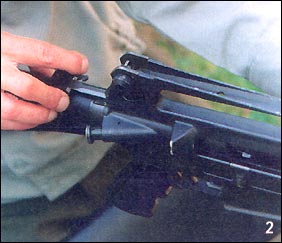
2. Отвести назад
планку перезаряжания и осмотреть патронник на предмет
отсутствия патрона. 3. Если подвижные части
винтовки удерживались затворной задержкой,
нажатием на рычаг затворной задержки спустить их в
переднее положение.
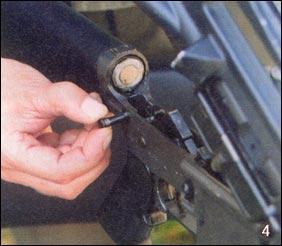
4. Вытолкнуть чеку
в задней части спусковой коробки и откинуть вверх
заднюю часть ствольной коробки. 5. Придерживая рукой
стебель затвора, сдвинуть его вместе с планкой
перезаряжания назад и отделить от ствольной коробки
движением вниз.
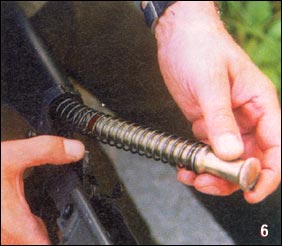
6. Поджав фиксатор
буфера противоотскока, вынуть его вместе с возвратной
пружиной из полости приклада. 7. Сдвинув
подпружиненную муфту цевья назад, отделить накладки
цевья.
Для удобства чистки возможно отделение ствола со
ствольной коробкой от спусковой коробки после
выталкивания вправо чеки, выполняющей роль оси
шарнира. Сборка винтовки производится в обратном
порядке.
Увидеть
схемы винтовки М-16 вы можете здесь,здесь и здесь ,а здесь
вы можете увидеть схему «оригинальной» винтовки М-16 и
модернизированного варианта,предложенного Павлом
Цупиком,администратором этого сайта.
В этом деле впрочем он не был гениален, принципы
действия автоматики
|
Характеристики |
Модель винтовки | ||
| AR-15 /M-16 | М-16 A-1 | М-16-А2 | |
| Калибр,мм | 5,56х45-мм | 5,56х45-мм | 5,56х45-мм |
| Применяемый патрон | М-193 | М-193 | М-855 |
| Масса с магазином без патронов, кг | 3,1 | 3,1 | 3,2 |
| Длина общая, мм | 990 | 990 | 995 |
| Длина ствола, мм | 508 | 508 | 508 |
| Число нарезов | 4 или 6 | 4 или 6 | 4 или 6 |
| Шаг нарезов, мм | 356 | 305 | 178 |
| Начальная скорость пули, м/с | 990 | 990 | 990 |
| Прицельная дальность, м | 450 | 450 | 800 |
| Темп стрельбы, выстр./мин. | 650-850 | 650-850 | 650-850 |
| Боевая скорострельность, выстр./мин. | |||
| одиночными выстрелами | 30-40 | 30-40 | 35-45 |
| очередями | 50-70 | 50-70 | 60-80 |
| Емкость магазина, патронов | 18,28,40 | 18,28,40 | 18,28,40,45 |

